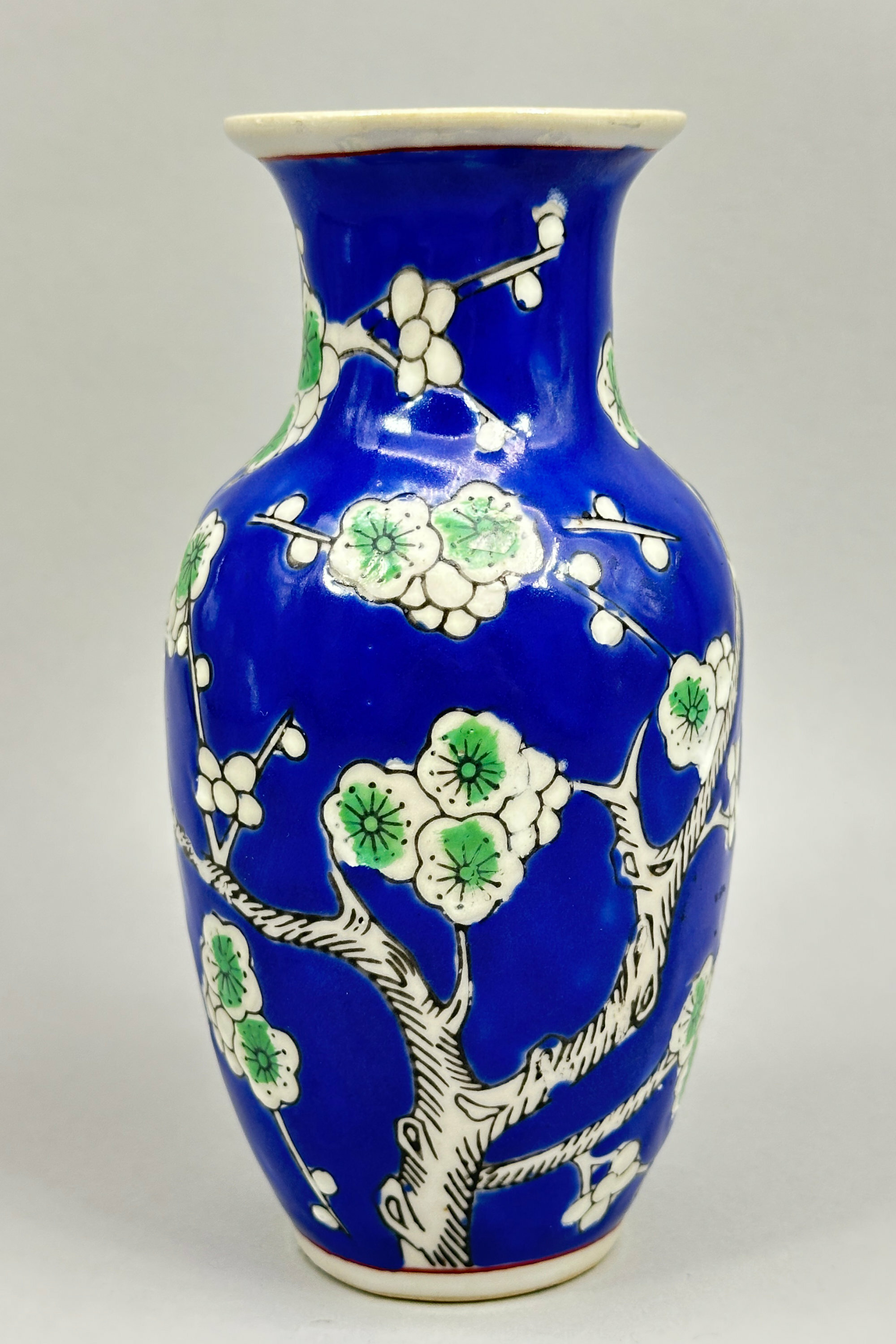Chinese & Japanese Works of Art
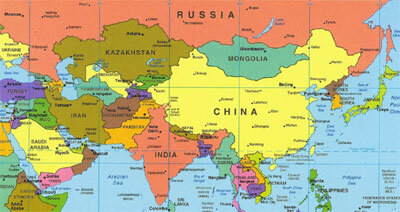
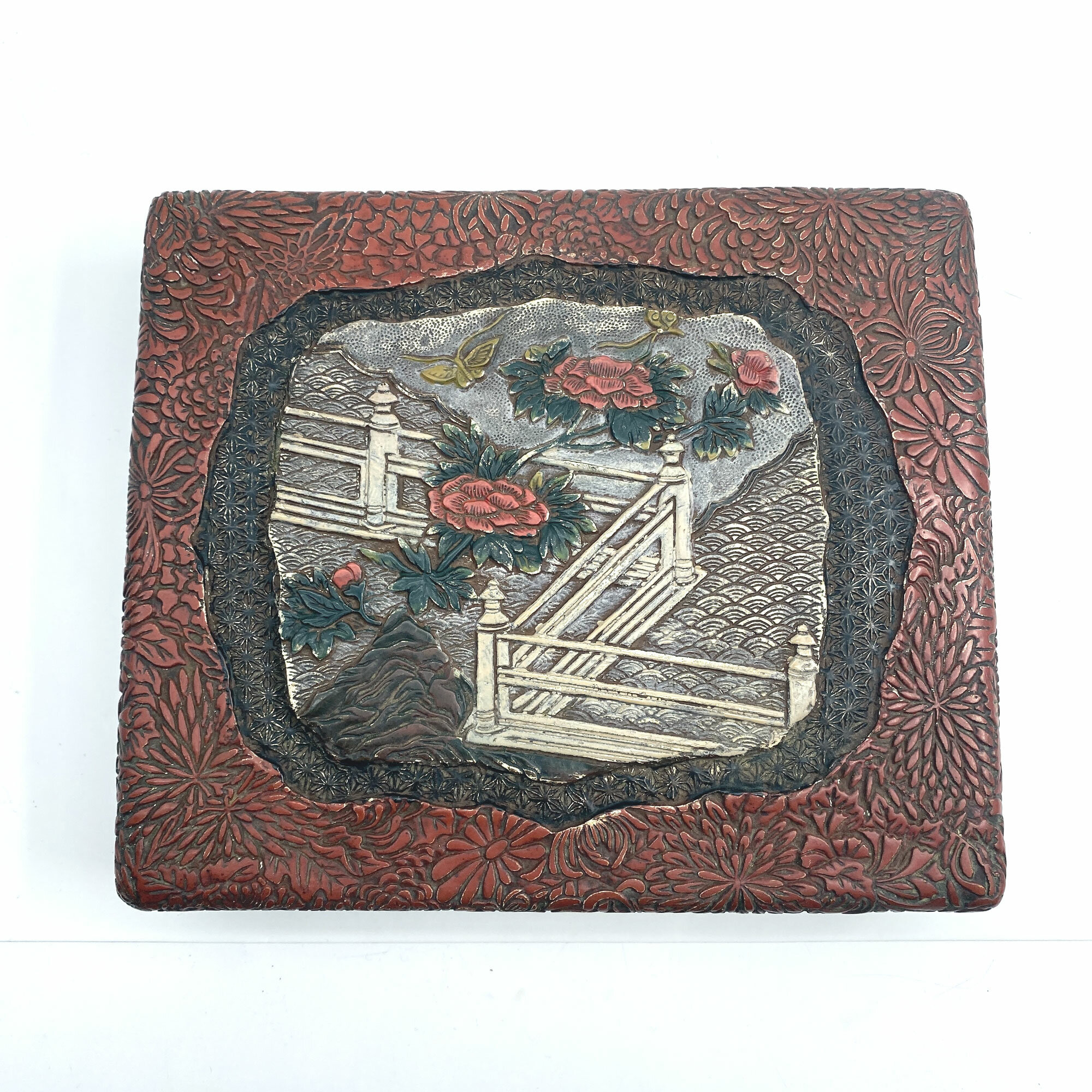
Japanese red lacquer Box and Cover with inset bone plaque, late C19th
Price: £75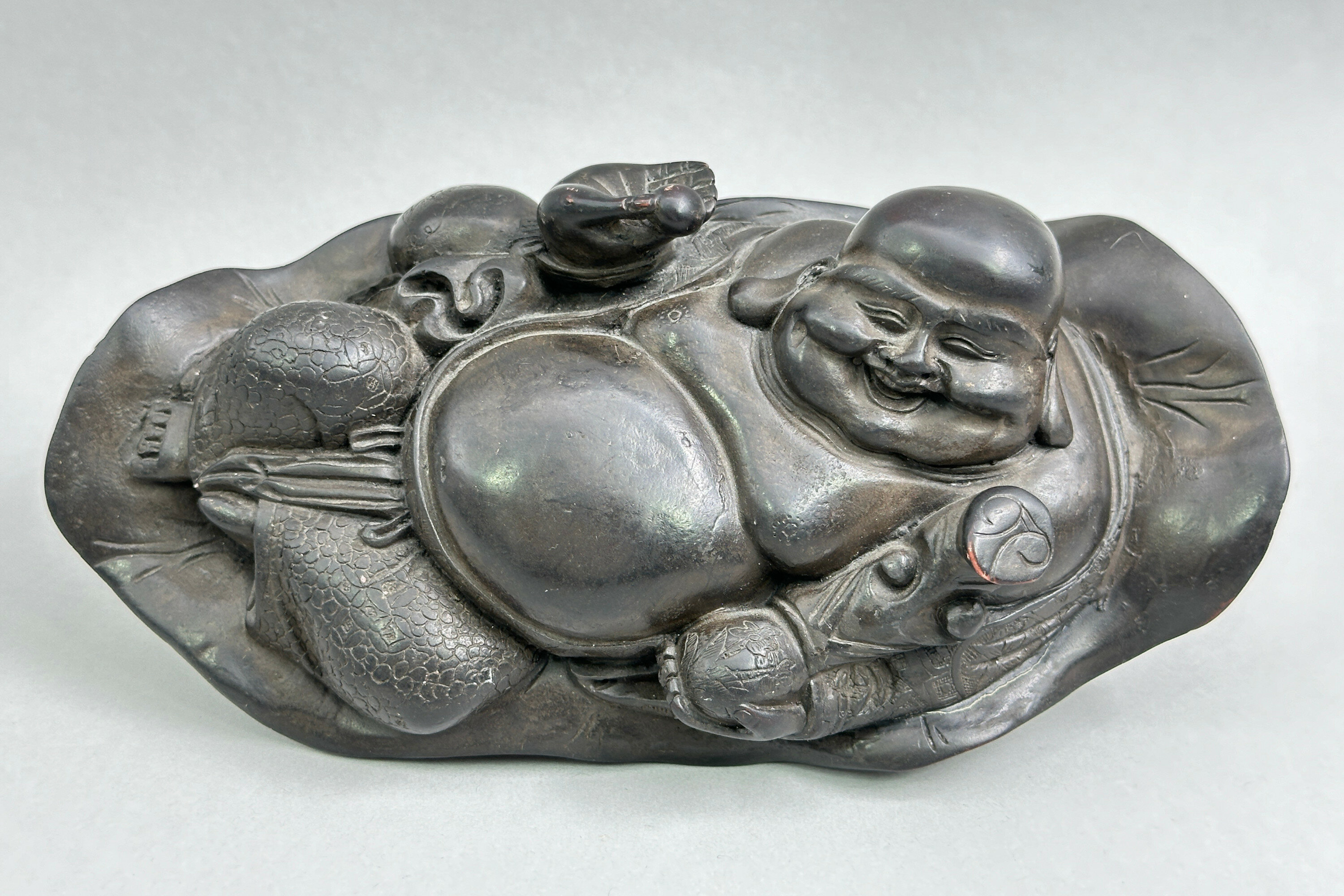
A Chinese Carved Wood Figure of Budai, signed, C 19th
Price: £75
Chinese Rice Grain Plate decorated in underglaze blue, iron red and gold, circa 1900
Price: £45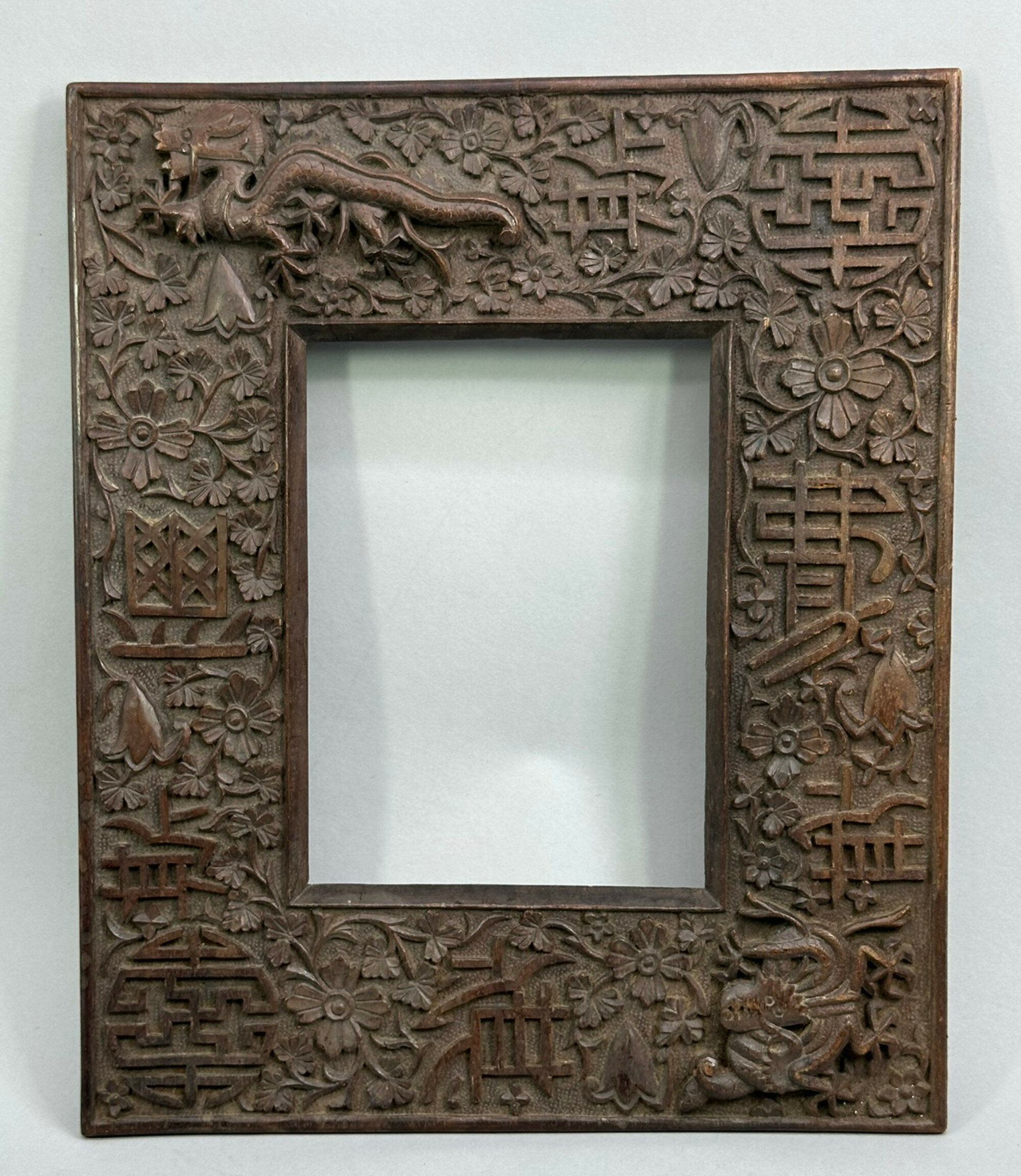
Chinese carved hardwood frame, 1920s
Price: £55
Small Chinese Bronze Vase of Ku Form with Elephant Head Handles, Qing Dynasty circa 1800
Price: £75
Set of two vintage Chinese painted eggs in glass display boxes
Price: £25
Lot of 3 vintage Chinese miniature cork groups
Price: £25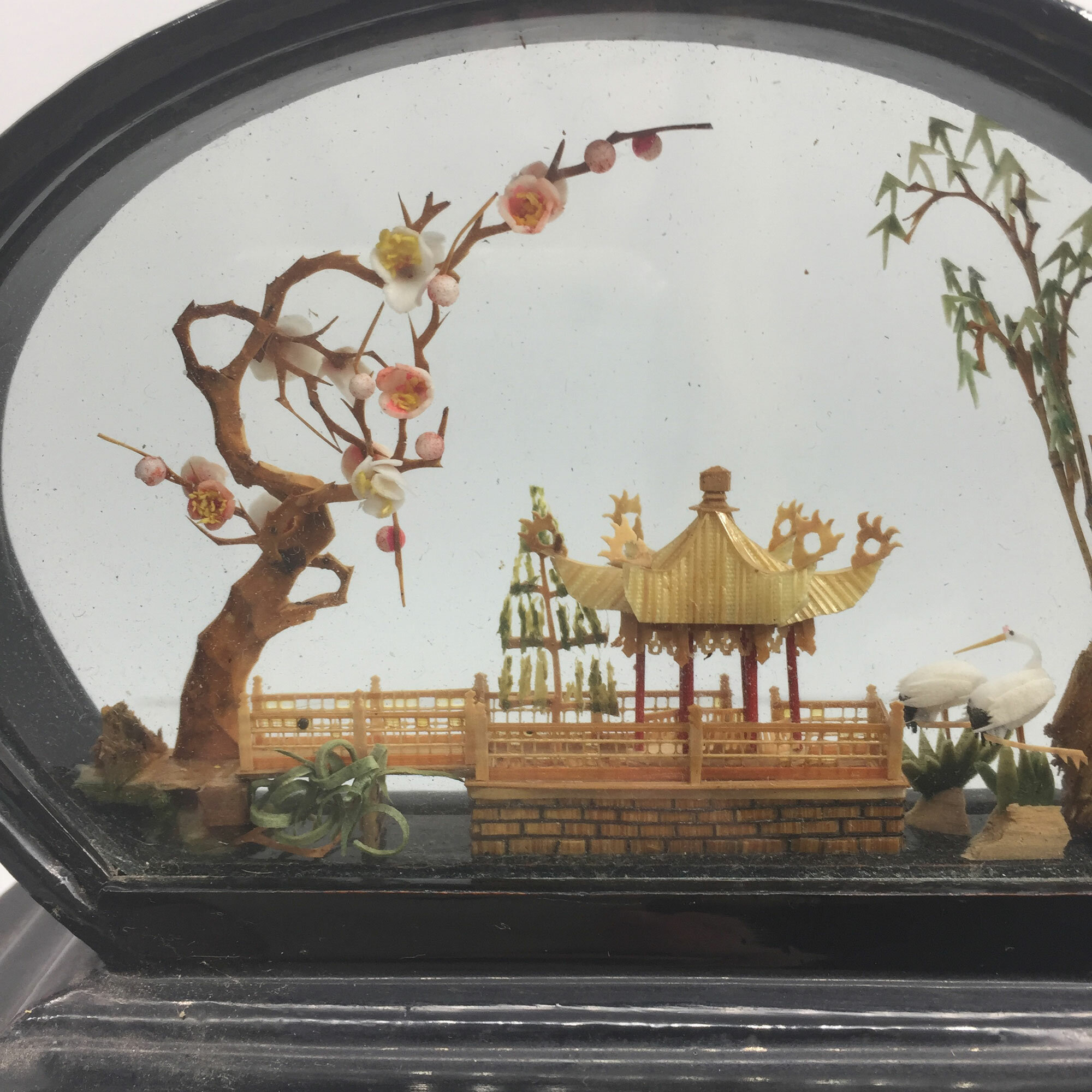
Lot of two vintage Chinese miniature Cork Groups
Price: £25
Very fine pair of vintage Chinese painted eggs in a pentagonal glass case
Price: £25
Unusual Chinese Bowl decorated in the Japanese Kutani Style, early 20th Century
Price: £45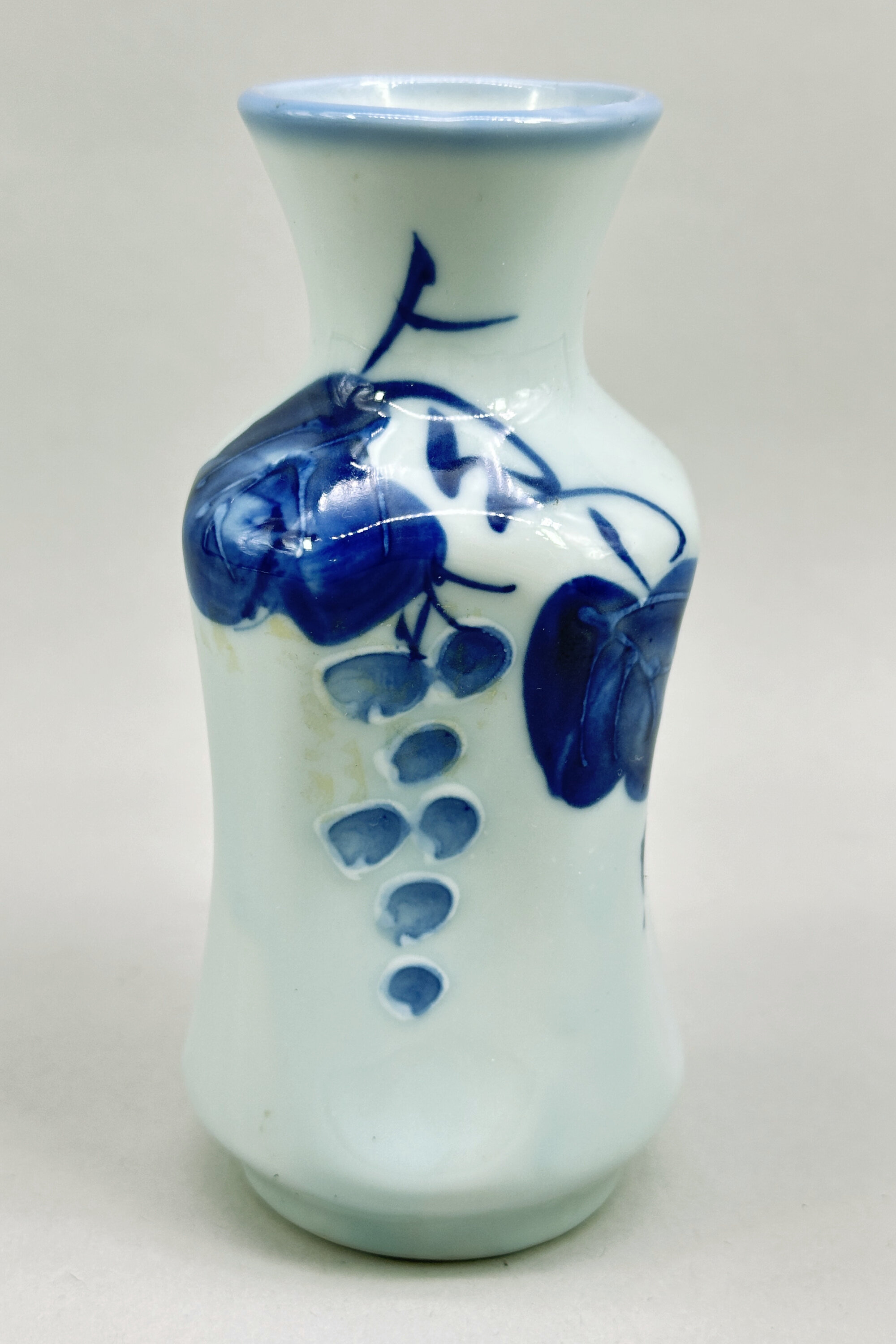
Fine Quality small Japanese Blue and White Vase, C20th
Price: £25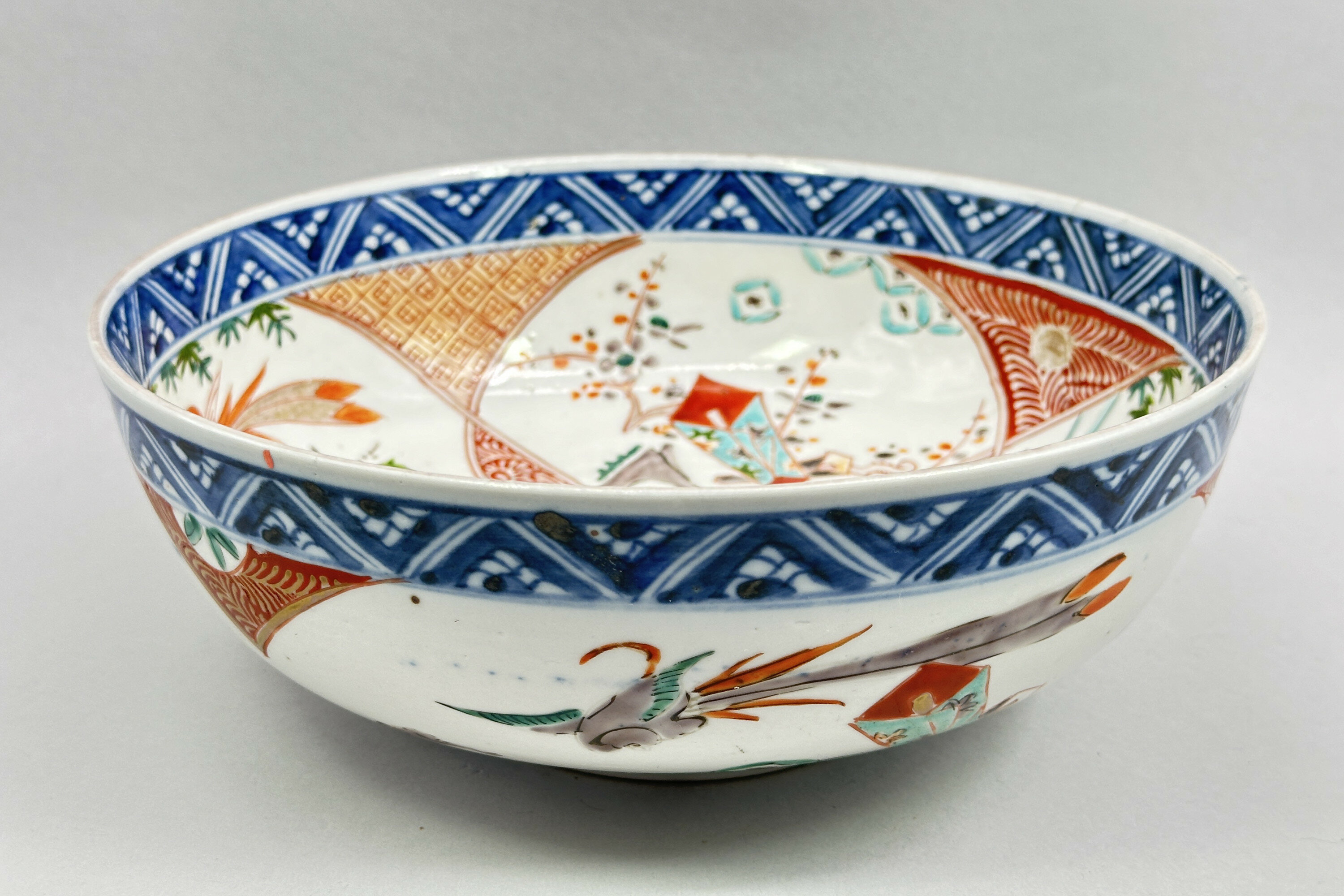
Japanese Arita Bowl decorated with Ho Ho Birds circa 1880
Price: £45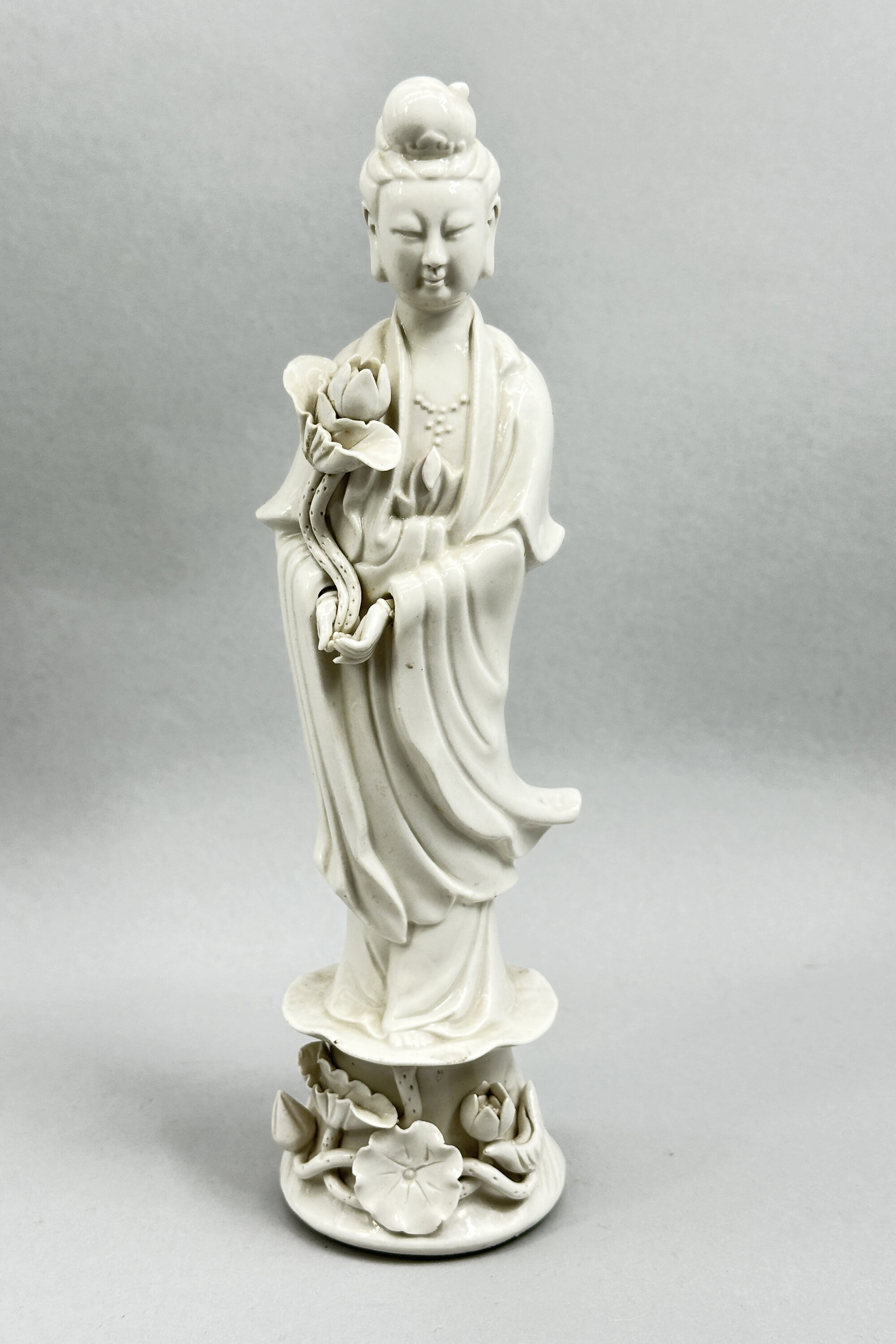
Chinese Blanc de Chine Figure of Guanyin, C20th
Price: £45The white glazed wares known as ‘Blanc de Chine’ are a well known feature of Chinese ceramic art. Pieces of this white ware originally came from the porcelain potteries in Dehua, Fujian province, north of the harbour city of Canton on the South Chinese coast. Eventually production was taken up by the kilns of Jingdezhen, the ‘ceramics city’ of China, but the clay used was rather different to that of Fujian and, when seen unglazed, has a rather ‘drier’ effect. Dehua Blanc de Chine tends to date to the eighteenth and nineteenth centuries or even before whereas the Jingdezhen productions mainly belong to the twentieth century but dating within that period is next to impossible. Quality was maintained even in ‘late’ pieces and the clay used was pretty consistent throughout the period.
Guanyin was the well known Goddess of Mercy and inspired a multitude of images in many art forms. She is often represented with lotus, as here, which is a Buddhist symbol of purity. The pose and modelling of this piece is little different to earlier examples but the paste of the foot indicates Jingdezhen work and the impressed numbers at the base, which seem to read ‘10’, imply a late twentieth century dating. Whether intended as a recreation or a reproduction it is hard to say but the workmanship is not so inferior that this figure cannot be enjoyed as a modest example of a quintessential Chinese ceramic genre.
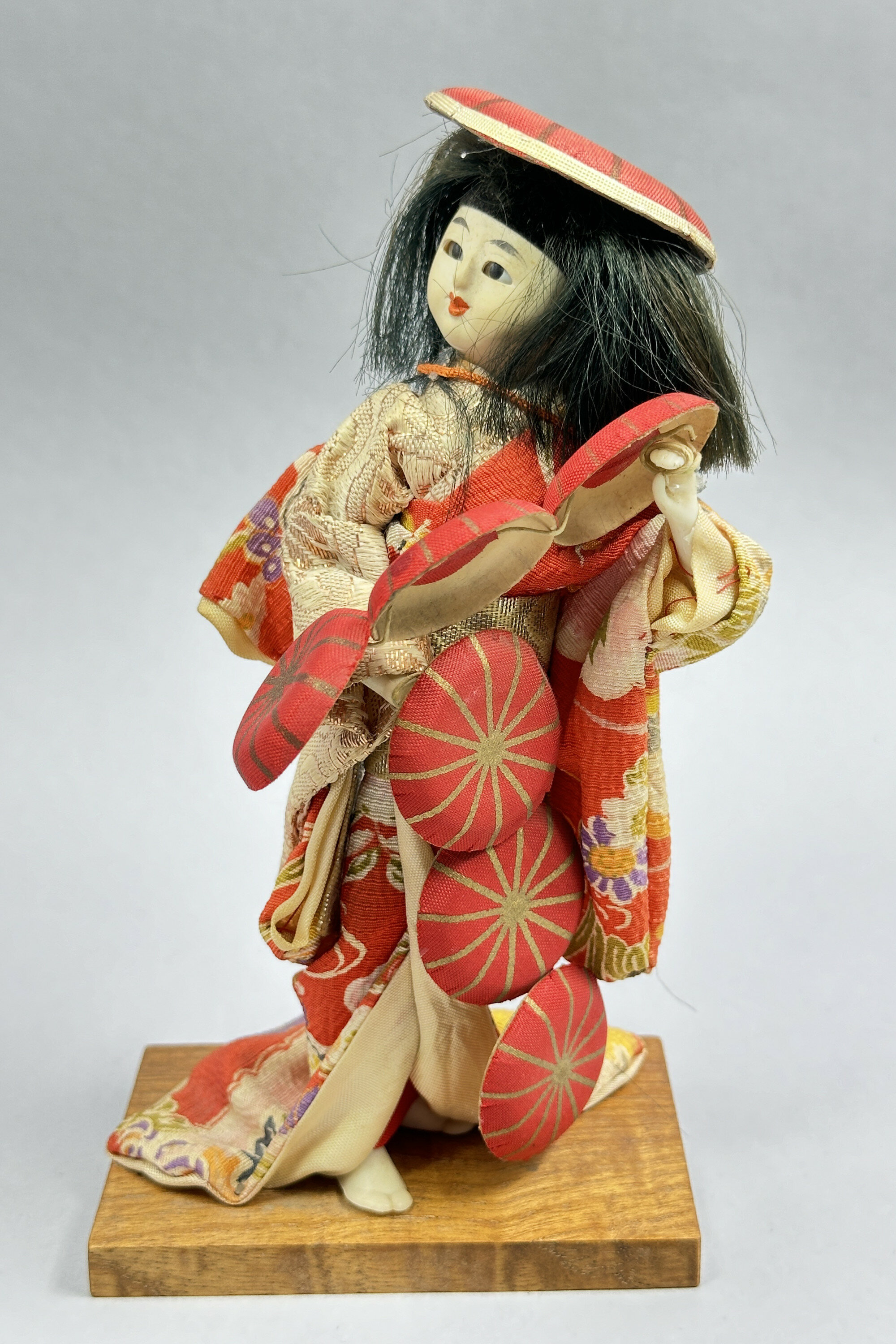
Vintage Japanese Doll of a Hat Seller, C20th
Price: £25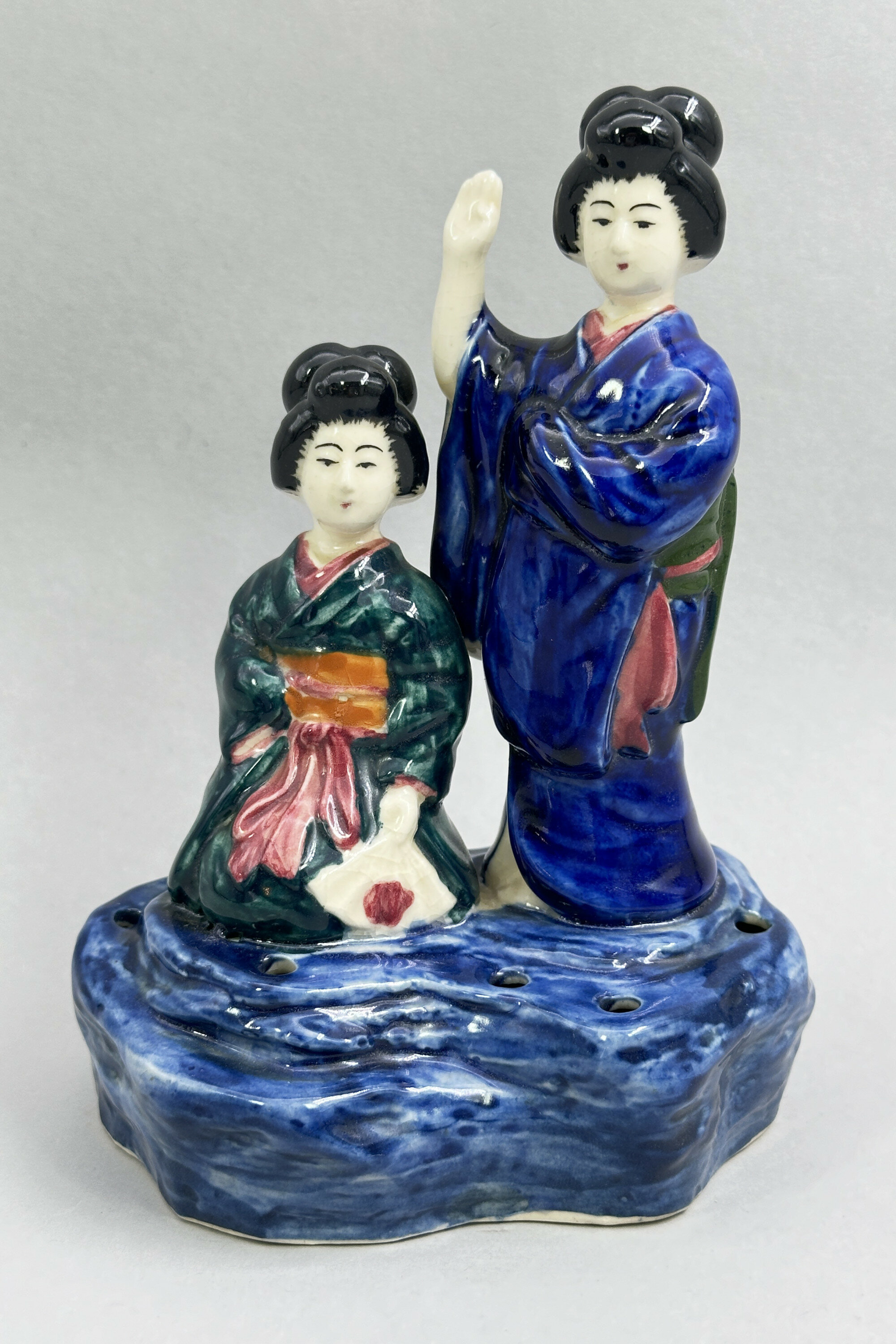
Japanese Ceramic Figural Group of two Geisha, late C19th
Price: £25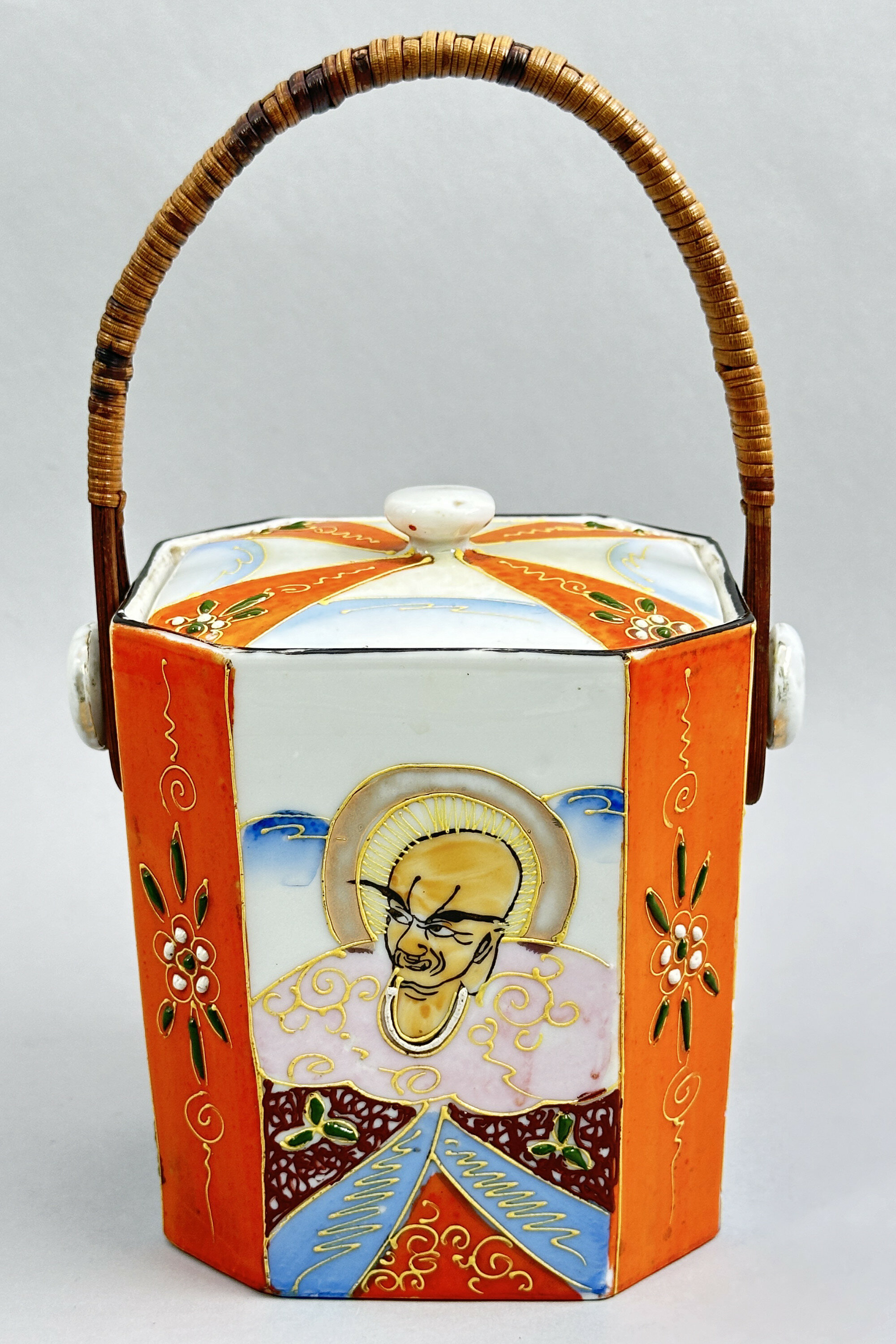
Japanese Samurai China Biscuit Box and Cover, C20th
Price: £25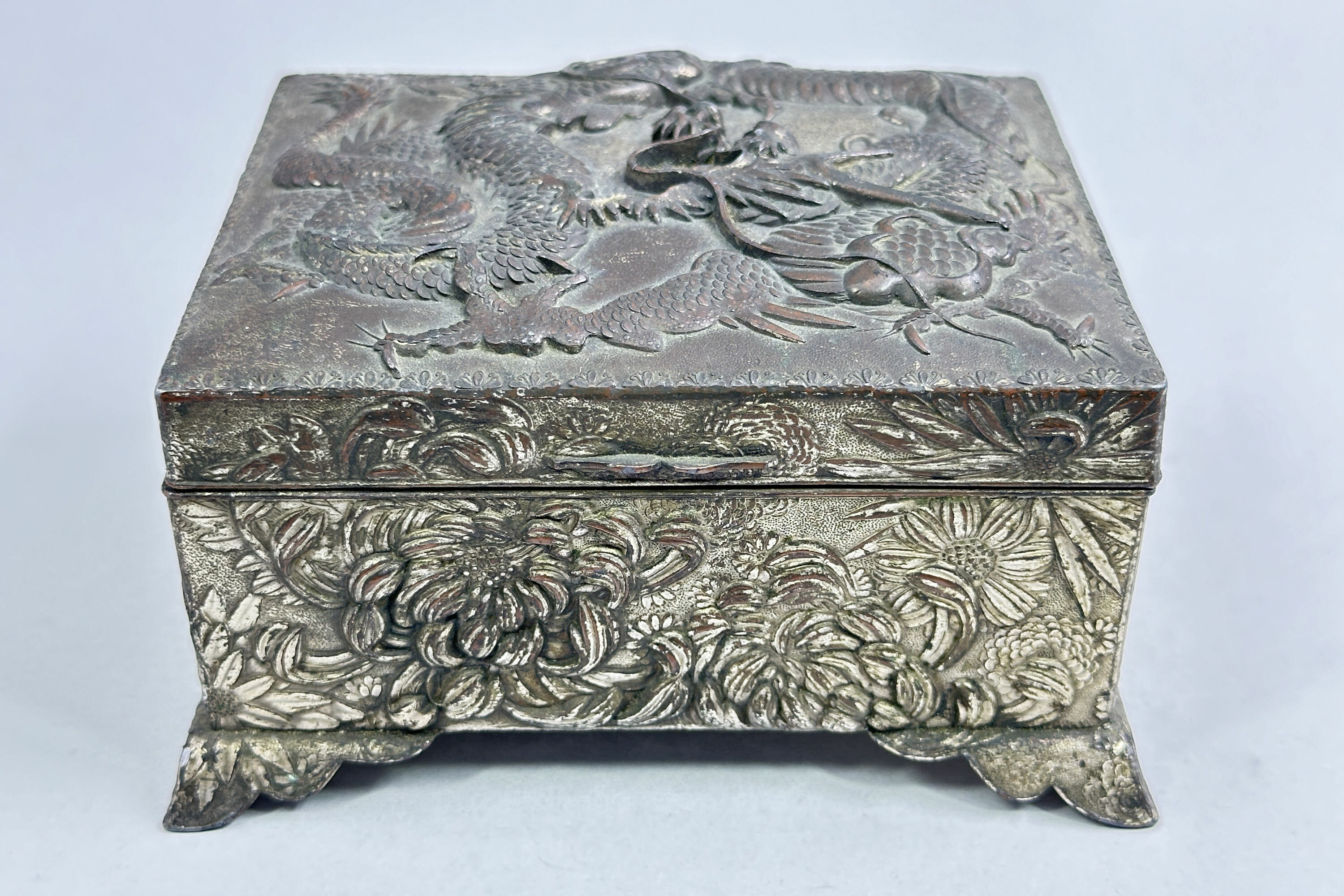
Oriental White Metal Box decorated Dragons and Chrysanthemum, C20th
Price: £25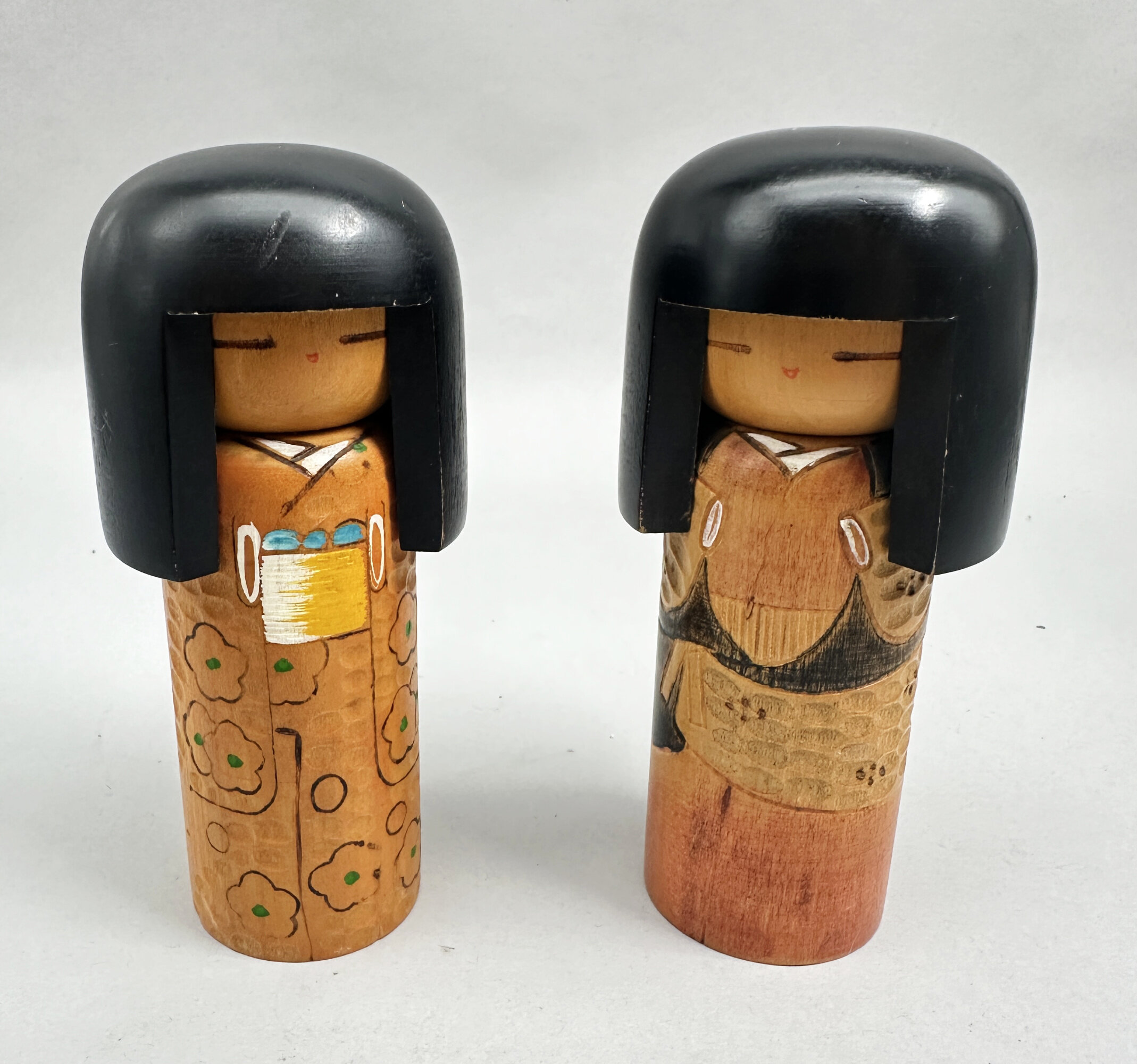
Pair of Vintage Japanese Kokeshi Dolls, signed, late C20th
Price: £25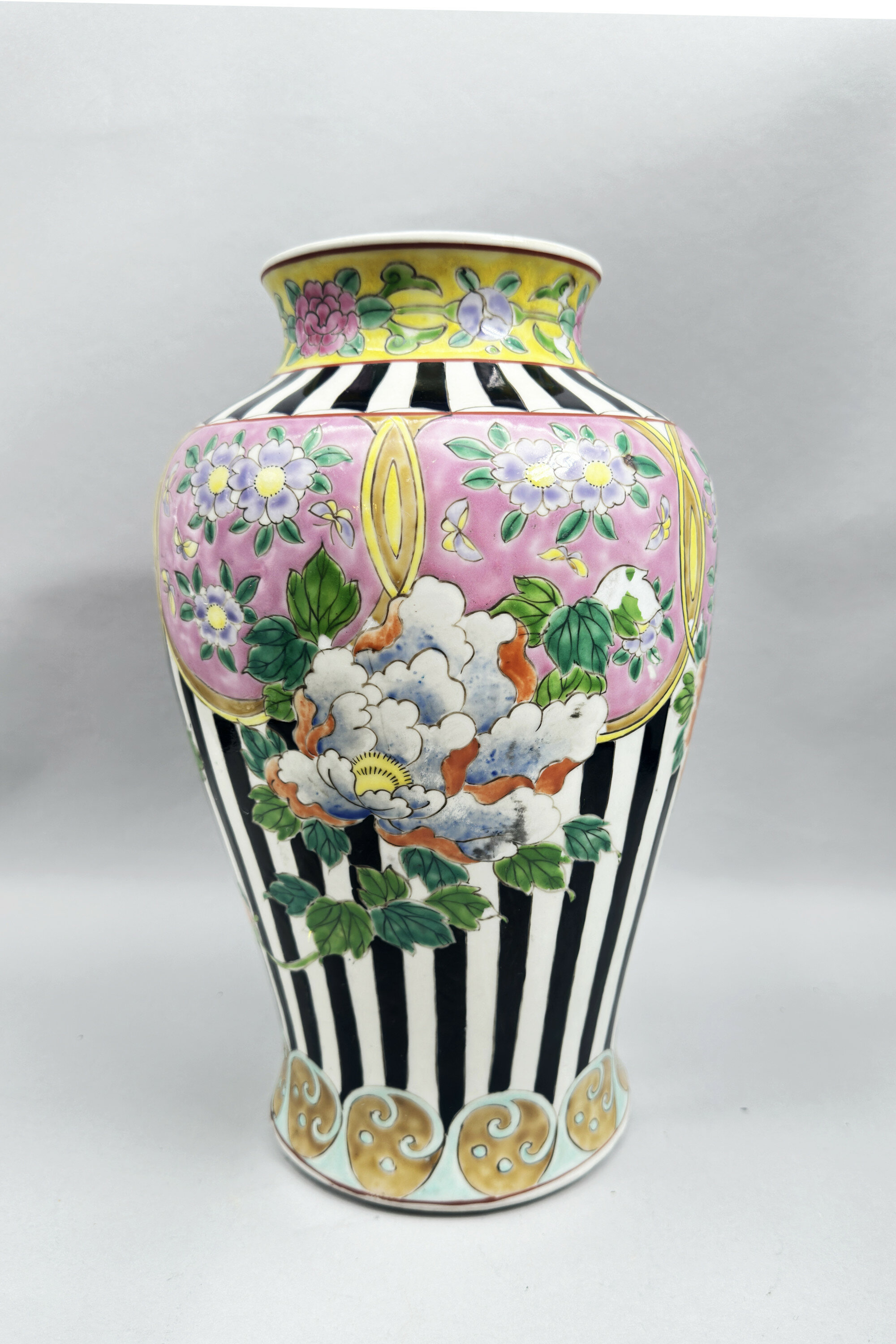
Japanese Arita Vase with Famille Rose Decoration and Black Stripes, early C20th
Price: £55In the late nineteenth century the Japanese potters at Arita turned their hand to producing pieces decorated in the Chinese ‘Famille Rose’ (rose family) palette. These were surprisingly effective and have sometimes deceived later collectors, mistakenly believing them to be Chinese. The decoration here is typical of the style but the striped ground is most unusual giving the piece a much more ‘modern’ appearance. Dating is pretty clear though. The stamped ‘Nippon’ (Japan) mark was used from around 1890 to the early 1920s. From 1891 imports to America were required to be marked with the country of origin, in western characters. Thus Japanese exports to America were marked with ‘Nippon’ in English from this date to 1922, when the requirement was changed so that the word ‘Japan’ should be used. Other countries had importing requirements too and the presence of ‘Nippon’ here is a pretty accurate pointer to the early C20th which is consistent with both the style of decoration and the paste of the foot. The unglazed top suggests that this vase originally had a matching lid. This has gone and, of course, the vase was later used as a lamp base and drilled accordingly. If reused now in the same way it would be a striking and individual lighting feature.
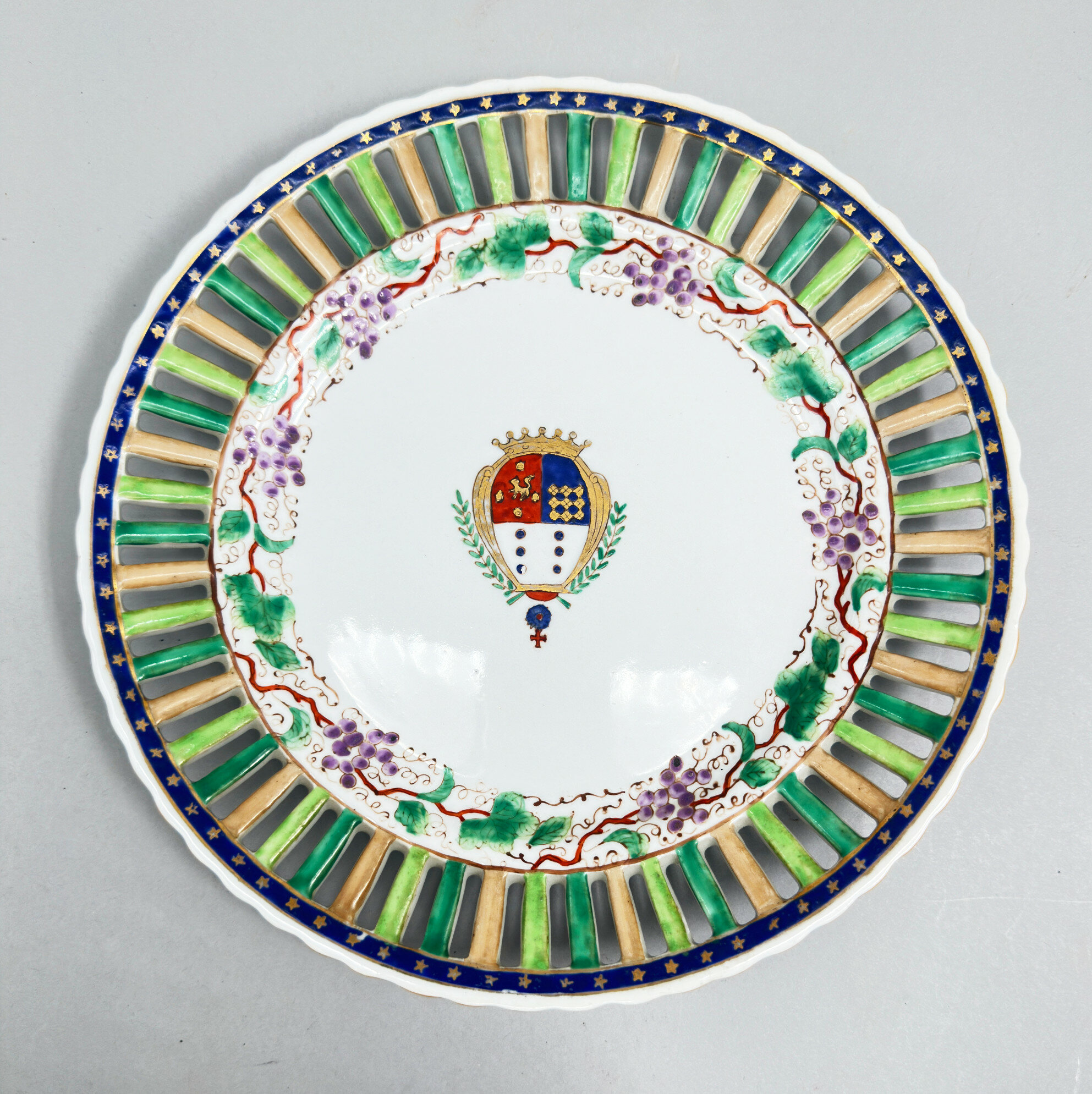
Compagnie des Indes style reticulated edge Armorial Plate, Chinese C20th
Price: £45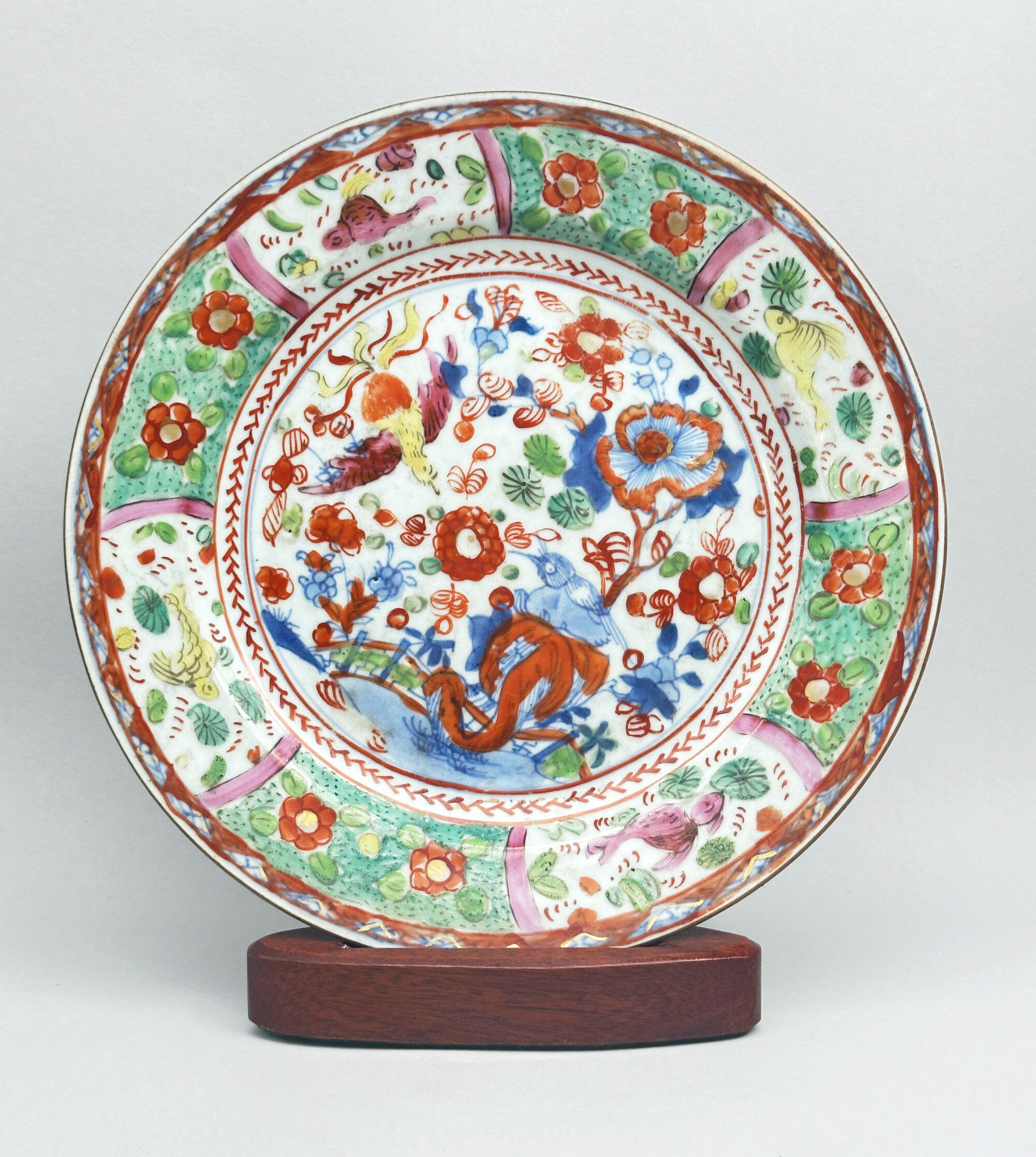
Chinese Export Blue and White Plate with Clobbered Decoration, circa 1780
Price: £75The demand in Europe for polychrome wares from China and Japan was sometimes greater than the supplies sent over and this was remedied on occasion by a second firing on arrival or later to add the colouration desired. The additional enamel decoration would fire at a much lower temperature than the original blue and white so the process was quite safe. The main exponents of the technique were based in Holland and England, often operating as quite small concerns, and there is considerable variation in the quality and style of the decoration they applied. At its best, as here, it can have a naif charm of its own. From the middle of the nineteenth century in England such pieces began to be referred to as ‘clobbered’, a word derived from ‘clobber’ which originally referred to shoe and then clothing repair work. The form and foot rim of this plate allows a secure dating to the late Qianlong period (1736-1795) and the decoration was probably applied in Holland not so long after. By 1900 its use to describe these hybrid porcelains was common and has remained so ever since. The wares are not ones for purists but for those who enjoy a bit of whimsy in a decorative style which is certainly the case here!
Please note that the wood stand is for display purposes only and is not incuded with this lot.
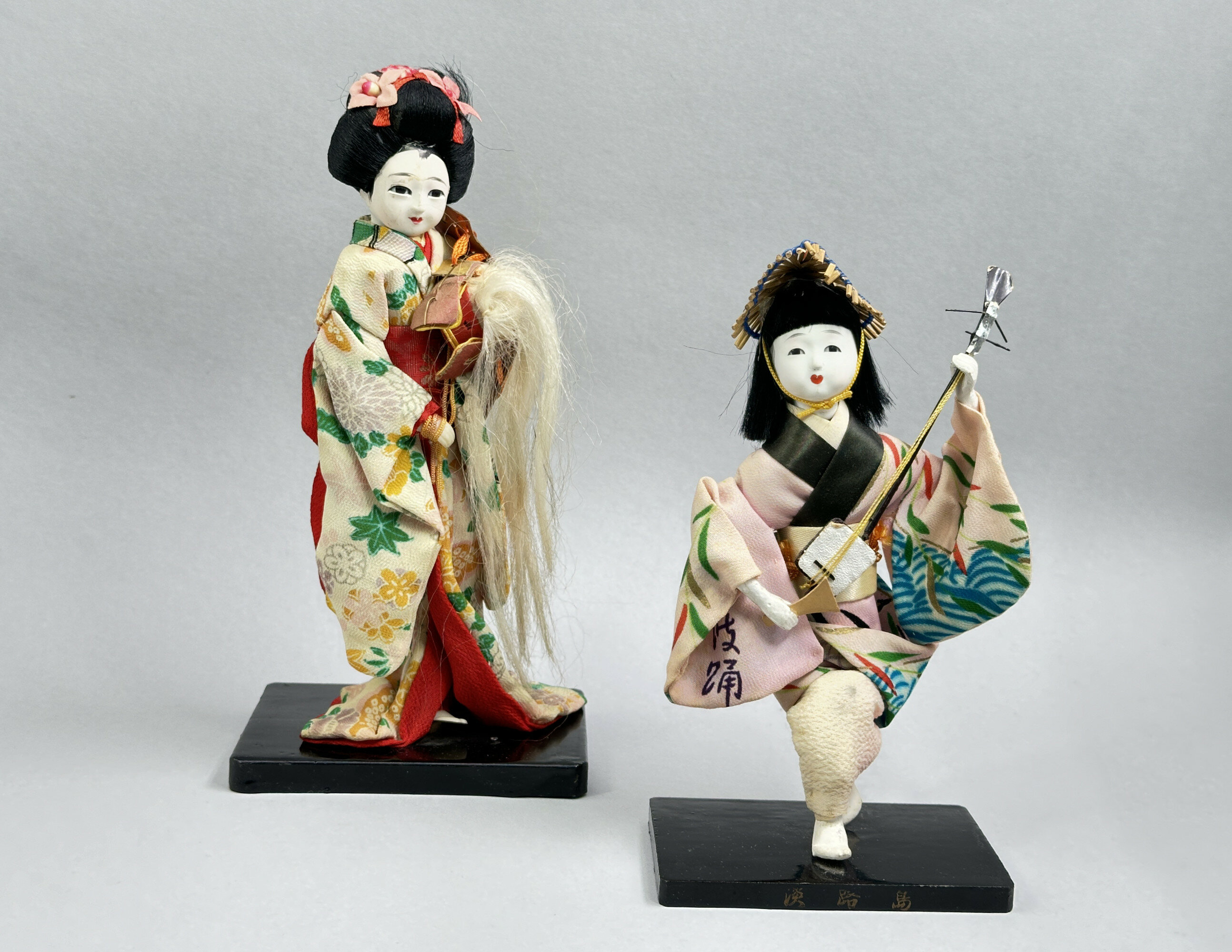
Two Vintage Japanese Geisha Dolls, C20th
Price: £25
Chinese Cloisonné Bowl with a wavy edge, 20th Century
Price: £25
Chinese Mandarin Pattern Saucer circa 1780
Price: £75This is a typical example of the ‘Mandarin’ pattern produced by the Chinese in the late eighteenth century for export to the West where it enjoyed great popularity. The name derives from the male court figures, mandarins, who form such an important component of the designs. The scenes are carefully composed with much charm and rendered in a wide variety of coloured enamels with much emphasis on deep pink (‘Famille Rose’) and iron red. A wide variety of wares were produced in the pattern including vases, bowls, dinner services and tea sets, as here, where there would have been a set of bowls and saucers along with matching serving items. The charm and quality of this piece speaks for itself and presents an excellent and collectible example of this opulent pattern from the eighteenth century.
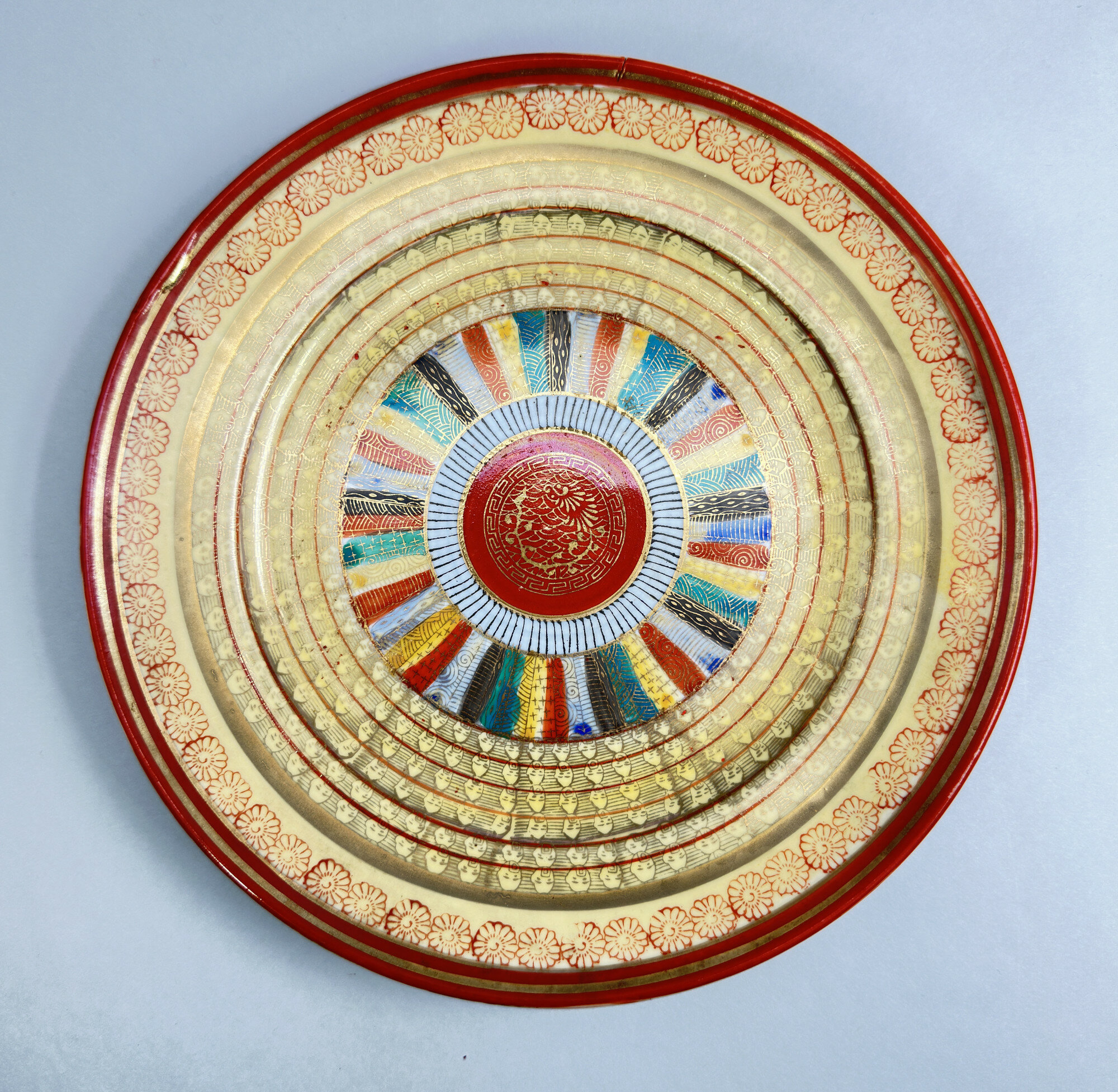
Japanese Kutani Dish decorated with the Thousand Faces pattern, first half C20th
Price: £45The colourings and style of work here clearly indicate the workshops of Kutani (the word means 'nine valleys') in the former Kaga province of Japan. By the nineteenth century the majority of their pieces were decorated in iron red and gold but sometimes with other colours in addition, as here. The ‘thousand faces’ pattern (an apocryphal term and this cataloguer has not attempted to count the number of faces appearing here) seems to have been evolved around the end of the nineteenth century and then continued in production until the mid twentieth. Both plates in various sizes and even tea sets are found in the design. The mark ‘Made in Japan’ was usually employed after 1941 (in the previous twenty years ‘Japan’ was the norm) but there are exceptions and the paste of the foot rim here does suggest a slightly earlier date, perhaps around 1930. In perfect condition, with very little wear to the decoration, this piece is a fine example of a rather eccentric decorative patttern.
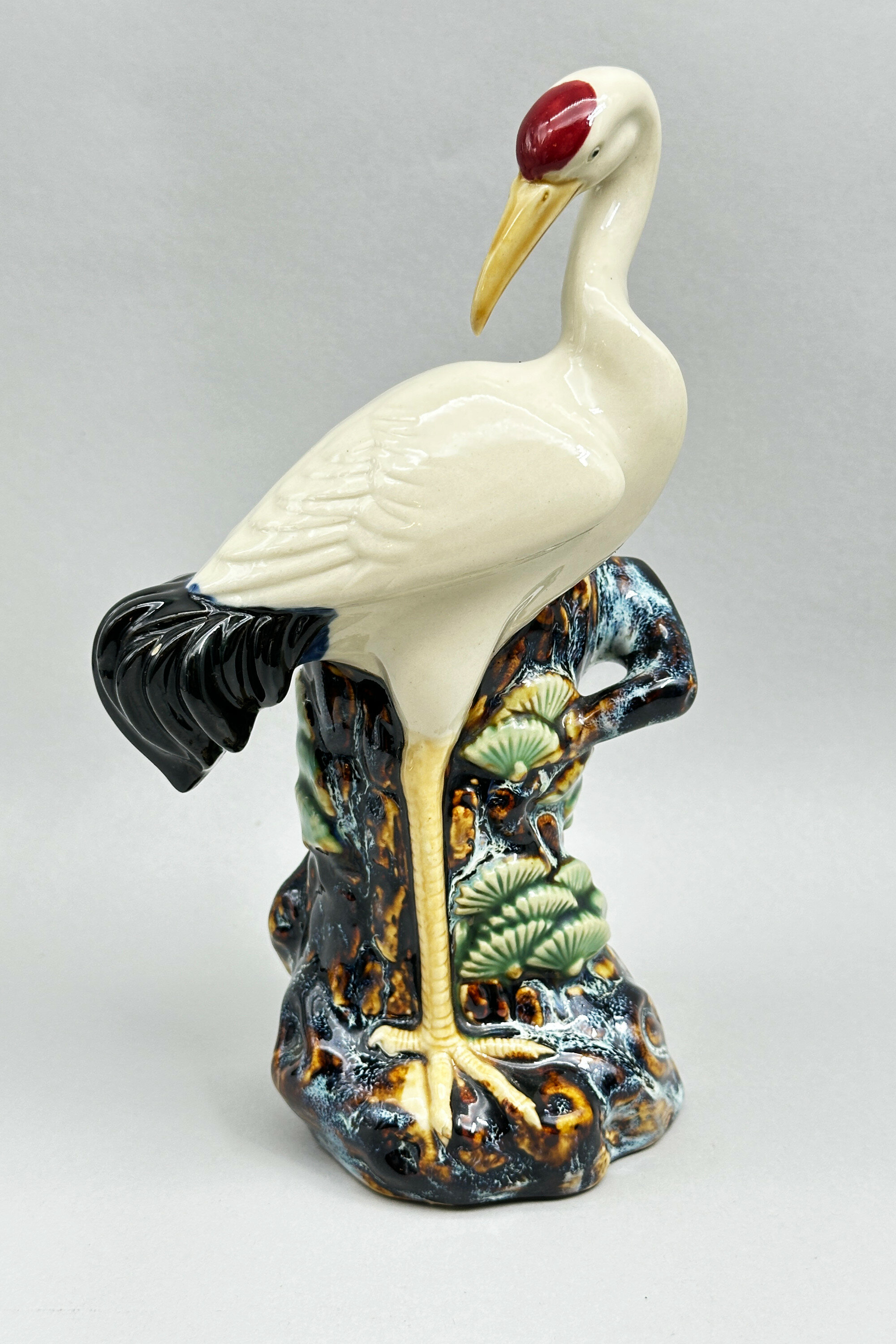
Chinese Majolica Style Brush Holder modelled as a Crane, mid C20th
Price: £25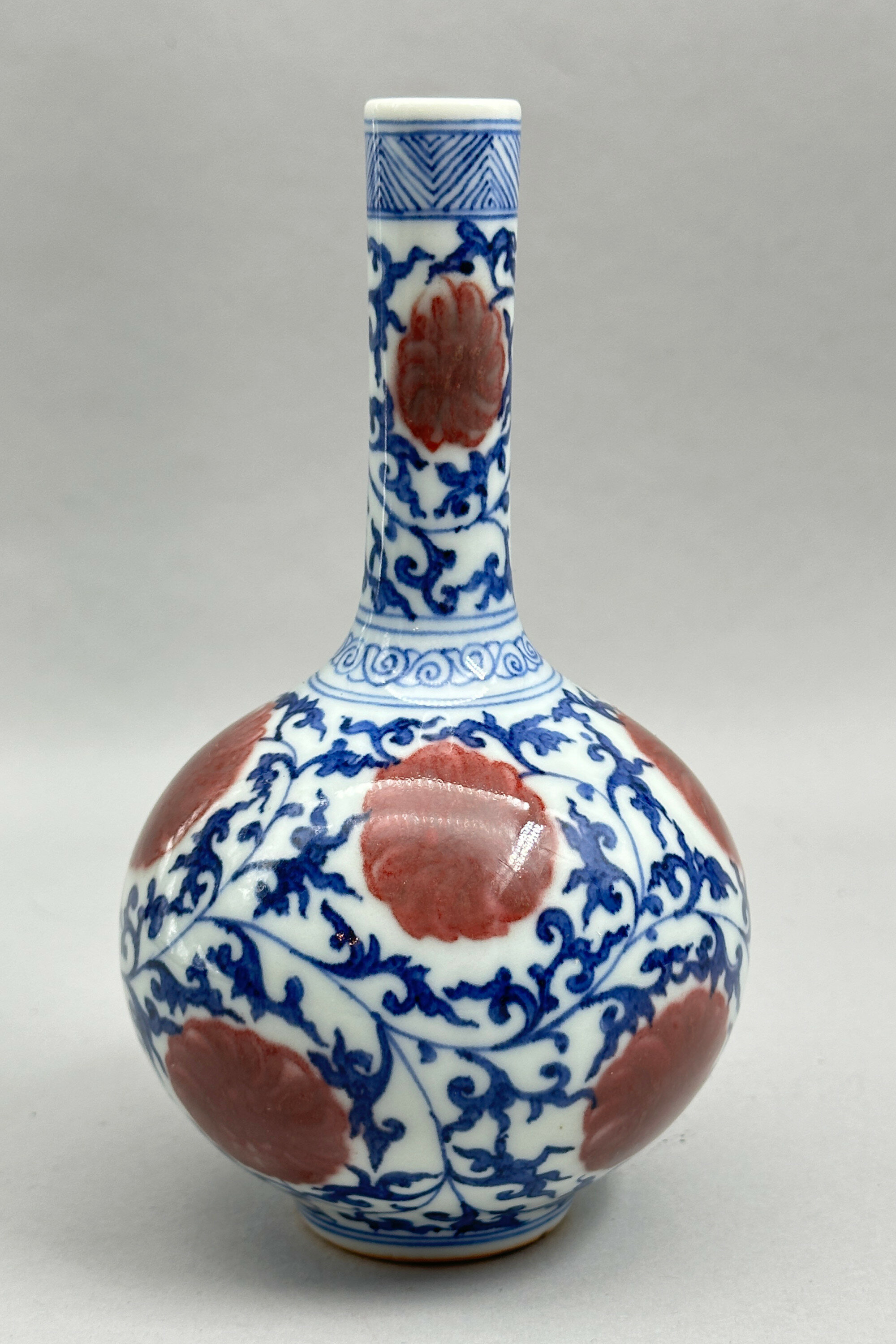
Chinese small Blue and White and Copper Red Bottle Vase, late C20th
Price: £25Underglaze copper red was first developed in China in the north-western Chinese province of Shaanxi during the Tang dynasty (618 – 907) and continued in production during the Yuan, Ming and Qing dynasties. But working with copper oxide as the colouring agent was notoriously difficult with little guarantee of success when the pieces were fired. Often the finished colour more resembled a dull grey or even brown. There were, though, many successes and such pieces were highly prized, sometimes forming part of the ‘imperial’ ware produced for the Emperors (see image 6 : Kangxi Mark and Period). More modern techniques allowed the colour to be produced more easily and this piece, while a very recent example, actually displays it rather well. The quality of the potting and painting is excellent but the paste of the foot betrays fairly recent manufacture at Jingdezhen, probably not much before the beginning of the current century. On the other hand the purchase price is much more modest than that of its forebears!
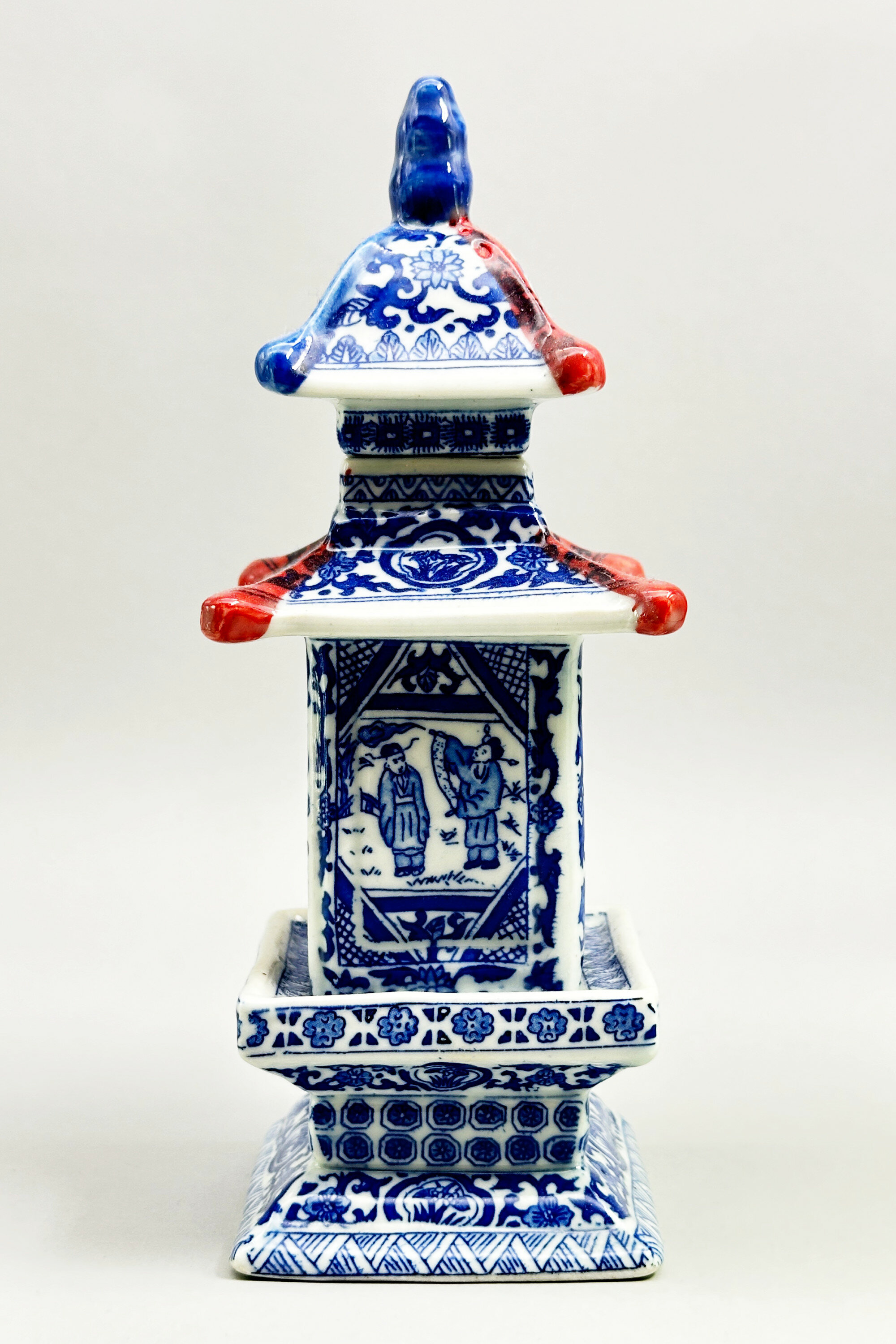
Chinese Blue and White Vase and Cover in the form of a Pagoda, end C20th or later
Price: £30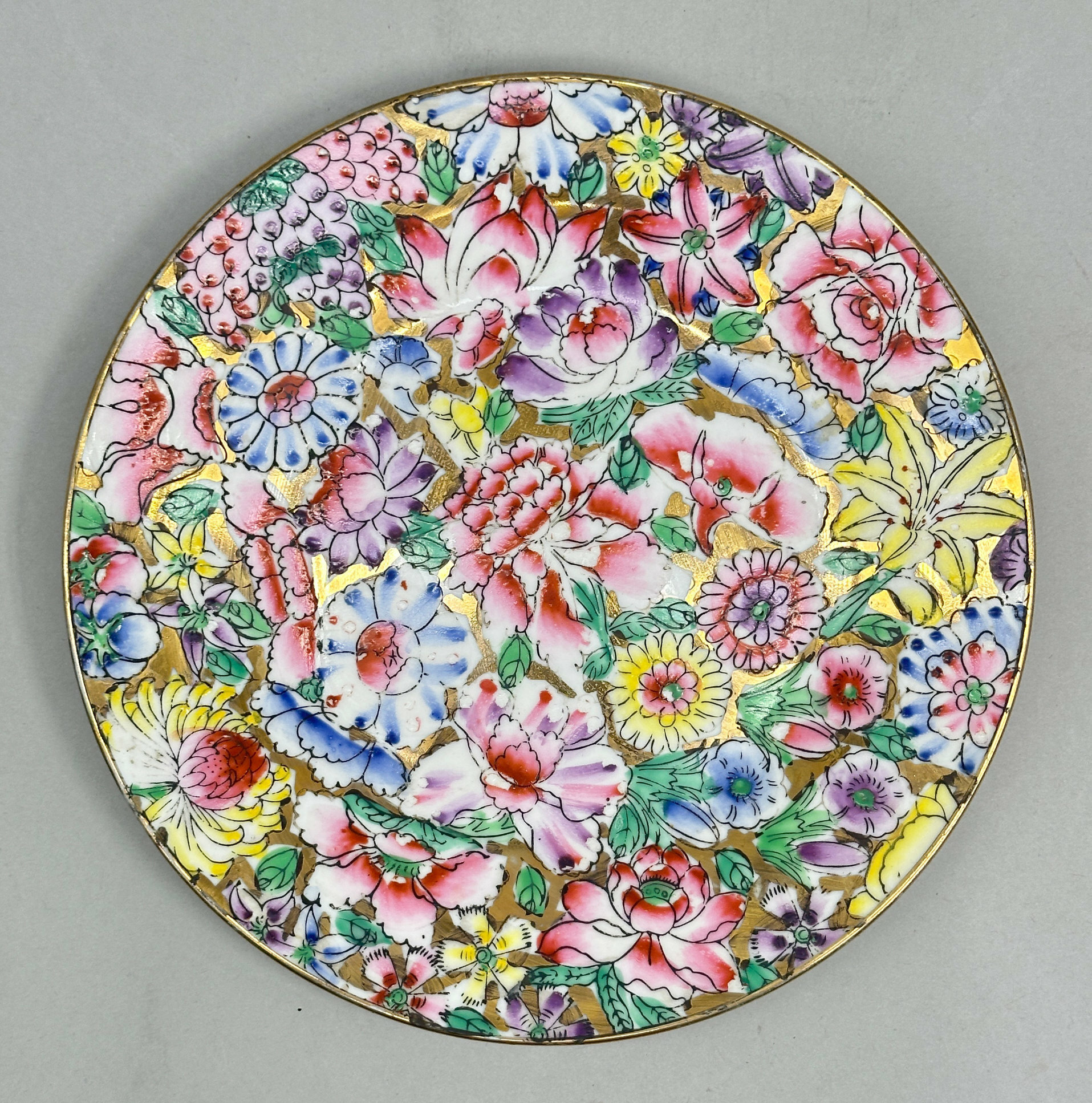
Chinese porcelain Plate in the Mille Fleur Pattern, Qianlong Mark, mid C20th
Price: £45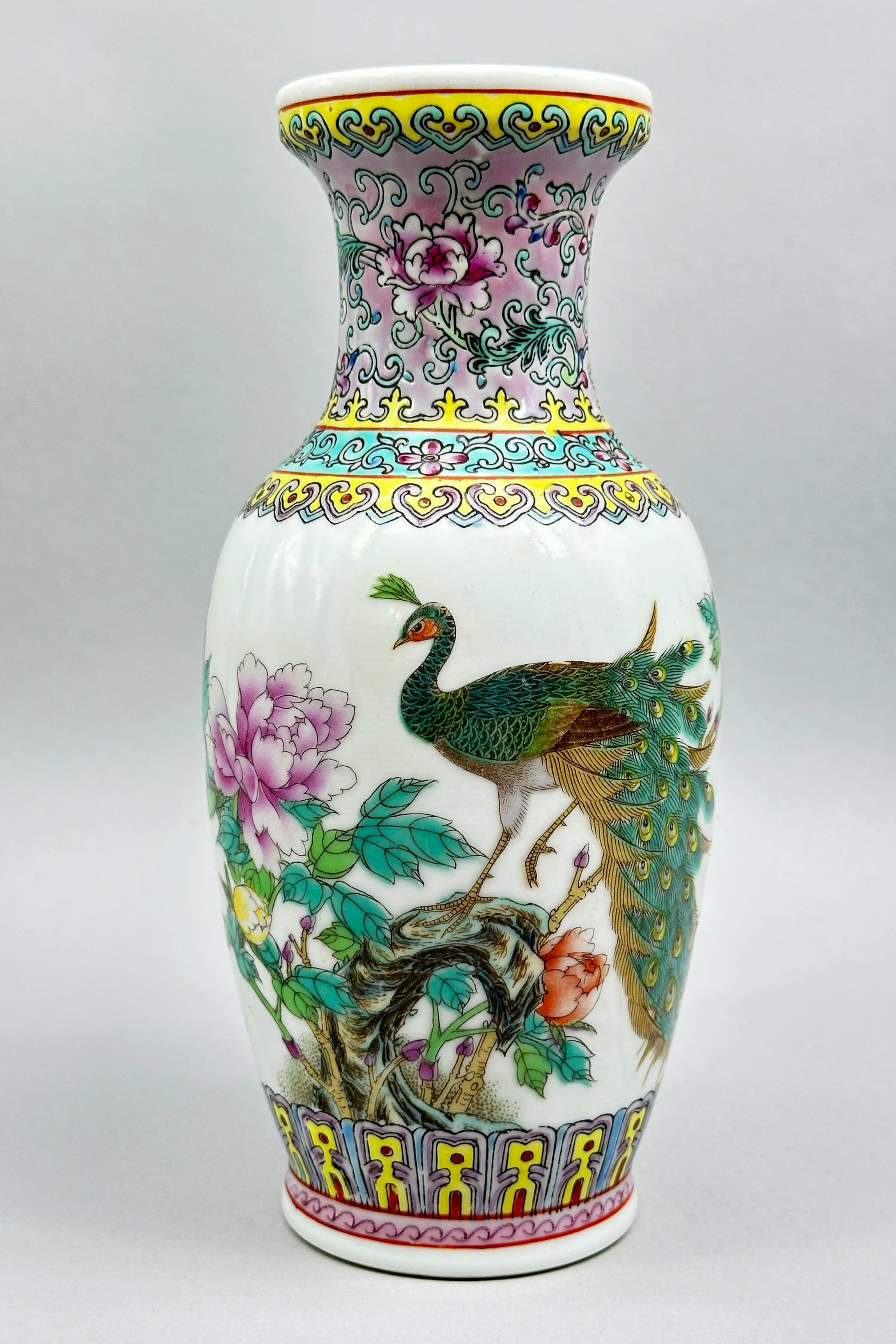
Chinese Famille Rose Vase decorated Peacock and Flowers, Jingdezhen mark, late C20th
Price: £25
Two Vintage Japanese Kokeshi Doll Groups, C20th
Price: £25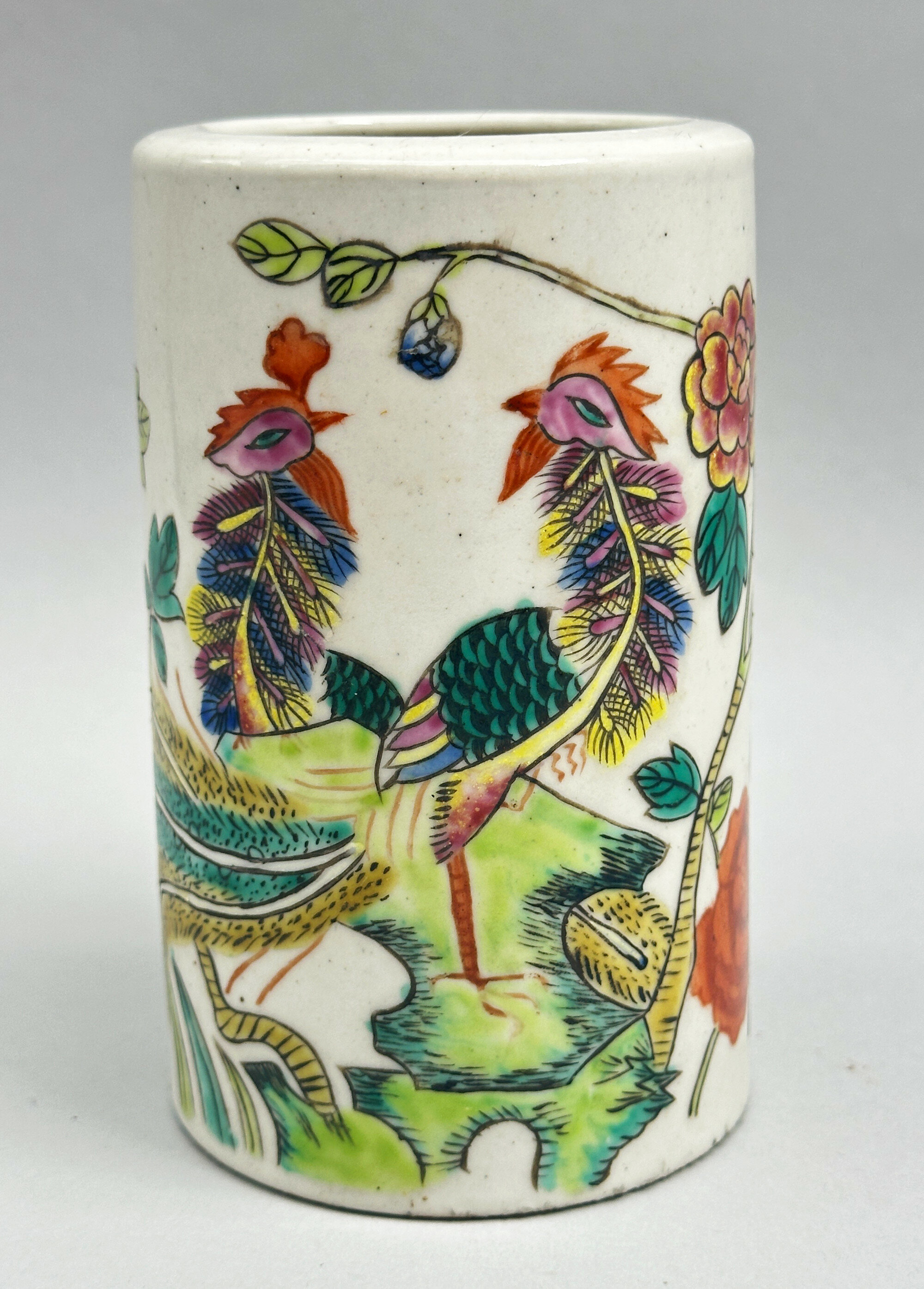
Chinese Famille Rose Brush Pot (bitong) decorated Phoenix, late C19th
Price: £45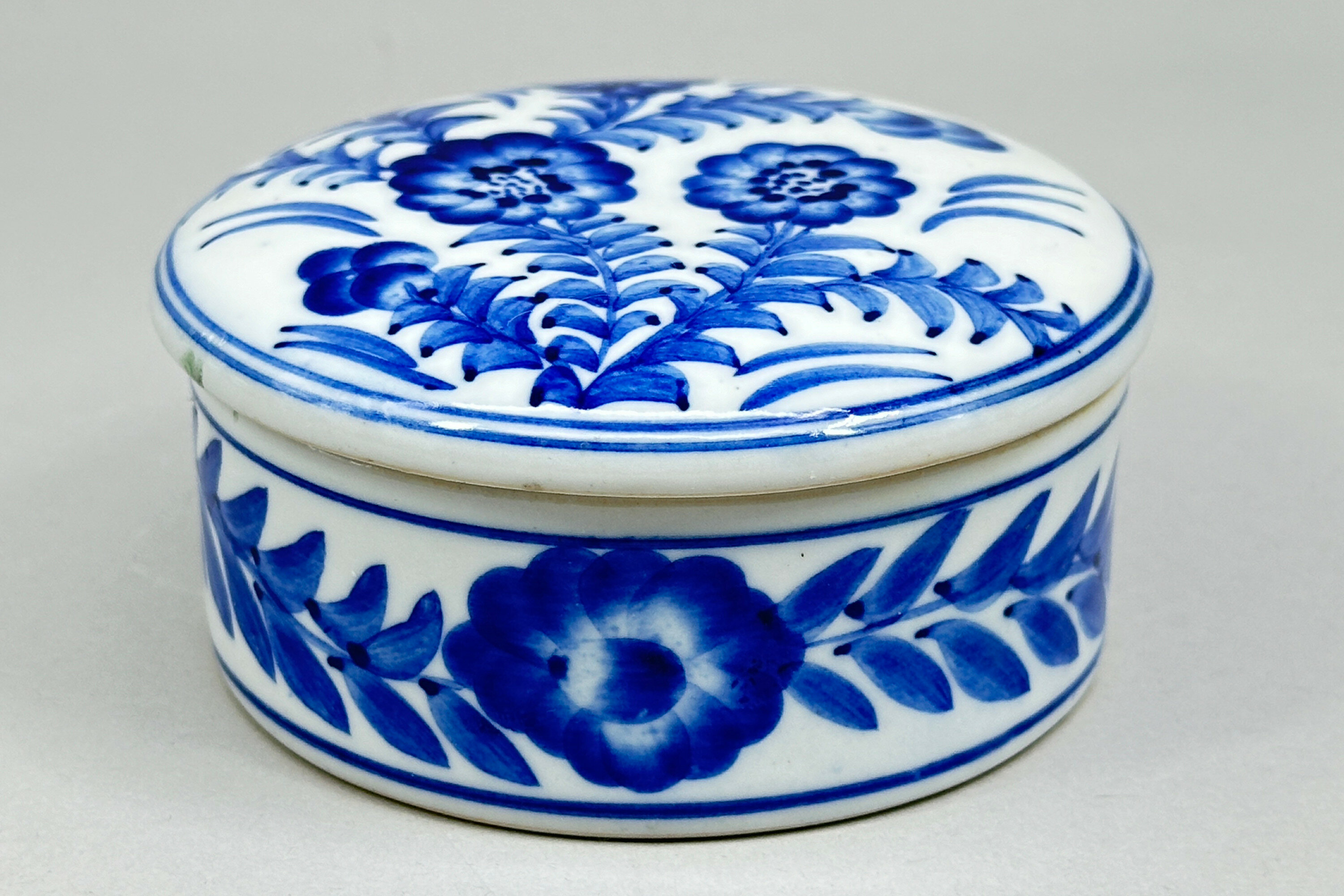
Chinese Blue and White Powder Box and Cover decorated Lotus, mid C20th
Price: £25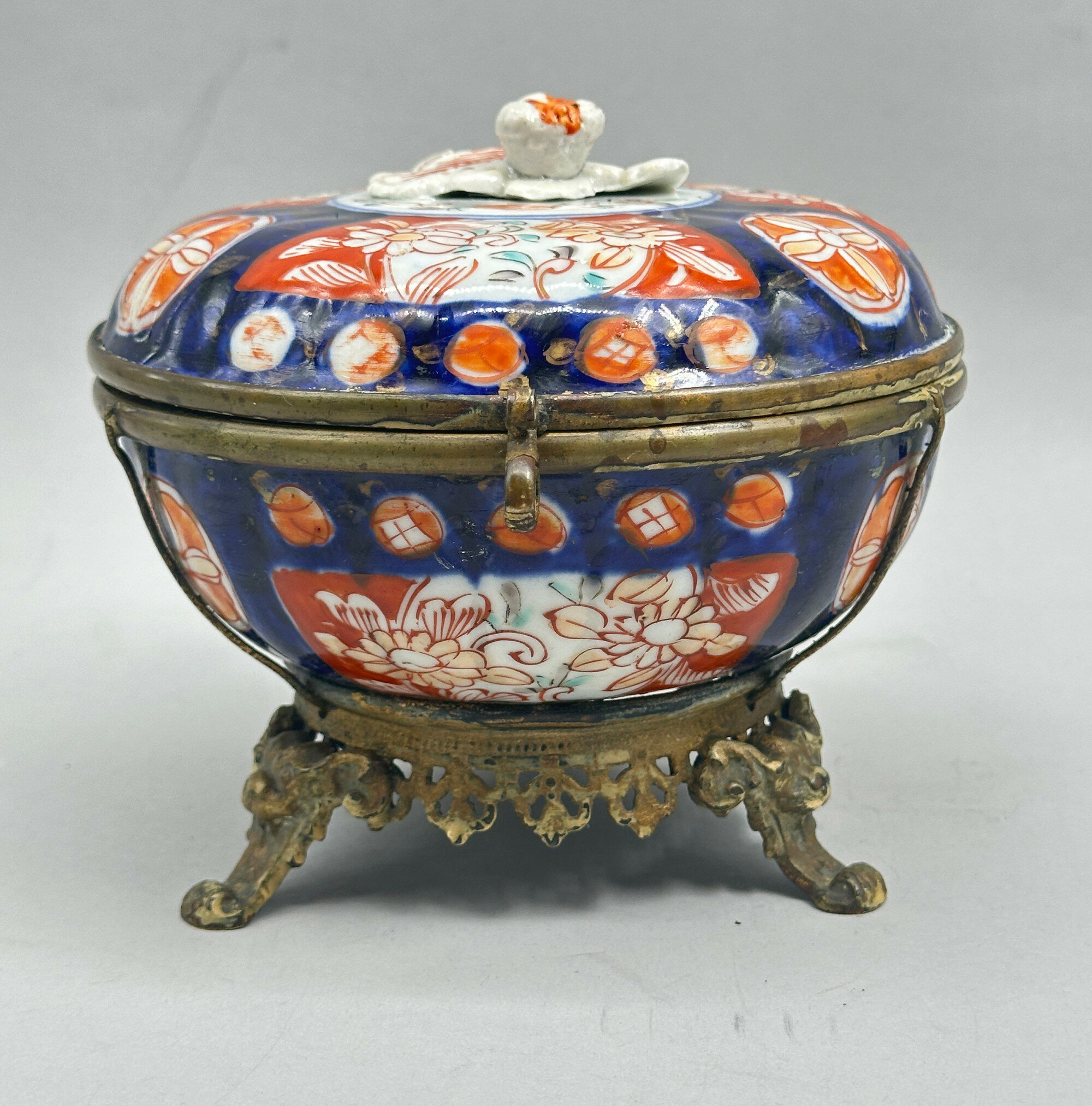
Gilt Metal Mounted Japanese Imari Box and Cover, late C19th
Price: £45Considerable care was taken to adapt this quite modest piece of Japanese export ware to what was presumably an addition to a boudoir dressing table. Evidently the original was felt by its owner to be a bit too plain and some enhancement was requested. The metal work is probably continental, perhaps French, and the hybrid result retains nevertheless a degree of provincial charm.
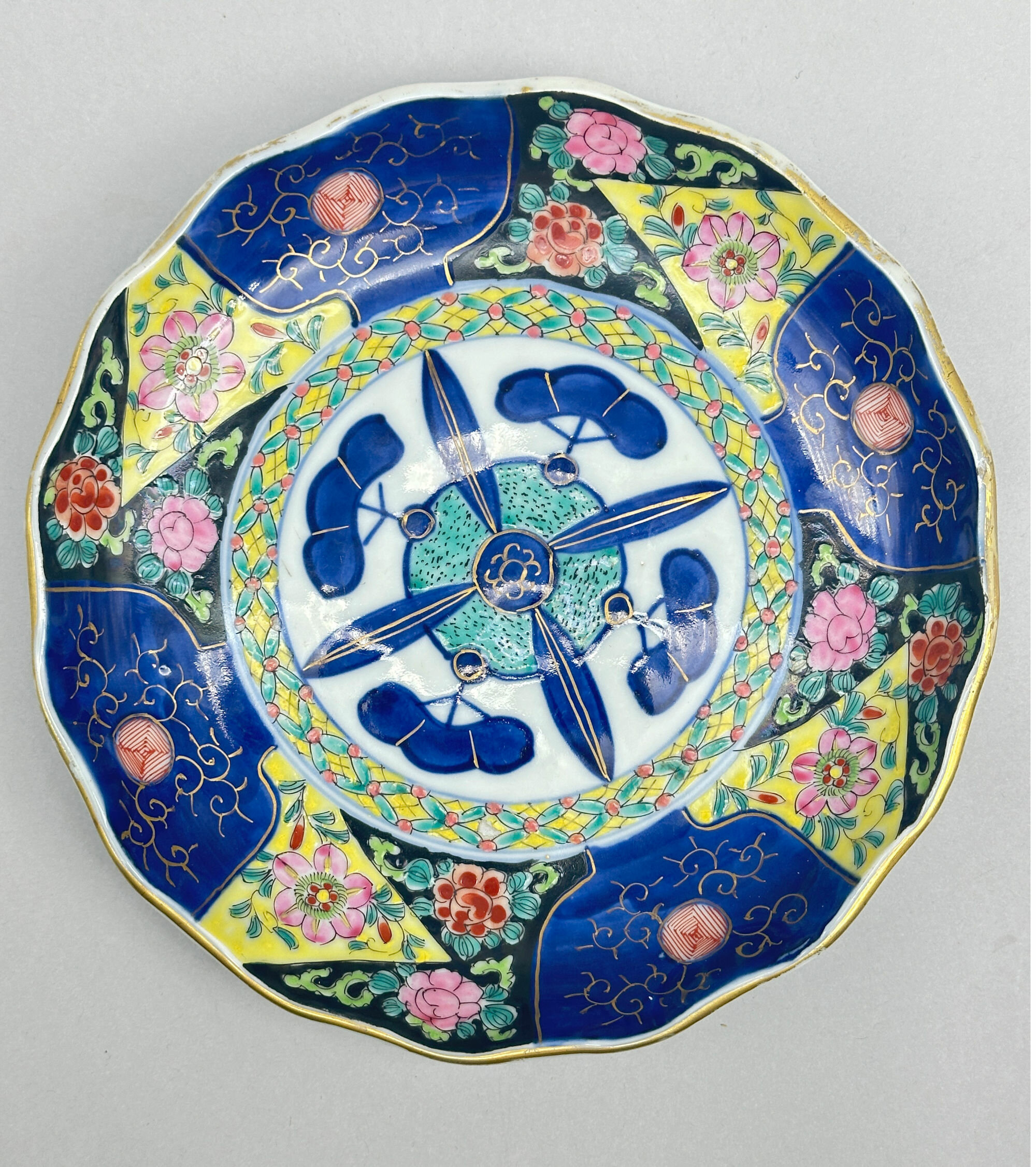
Japanese Arita Plate with Famille Rose Decoration, late C19th
Price: £45Ceramics decorated in the Chinese ‘Famille Rose’ palette were exported by Japan in the late nineteenth century and are sometime confused with their counterparts but there is nothing ‘Chinese’ about the decoration here and the range of colours, the irregularly shaped panels and the striking use of the underglaze blue ground are distinctively ‘Japanese’ and quite arresting in their effect.
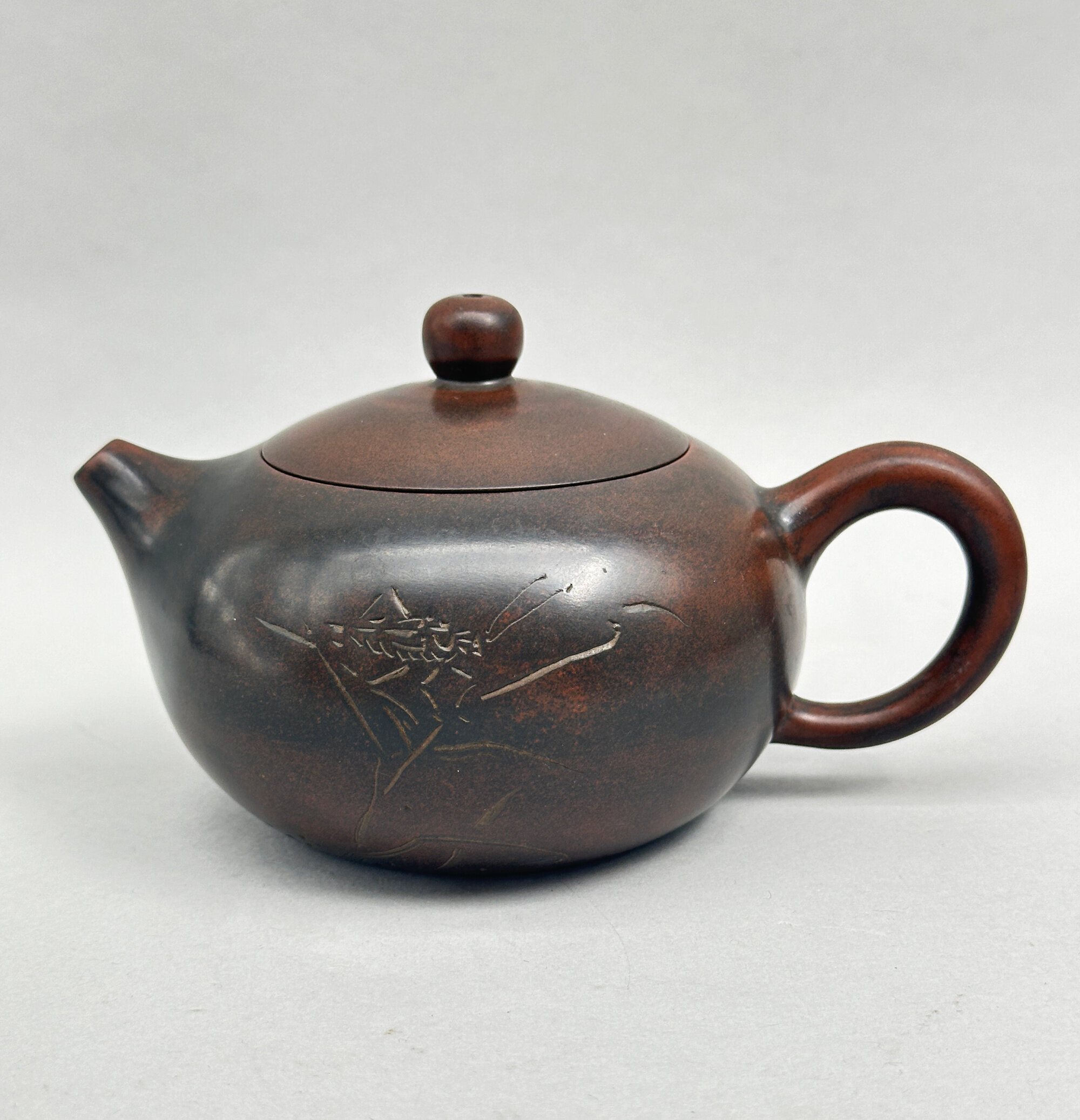
Fine Quality Japanese Yixing style Teapot decorated locust, signed, mid C20th
Price: £95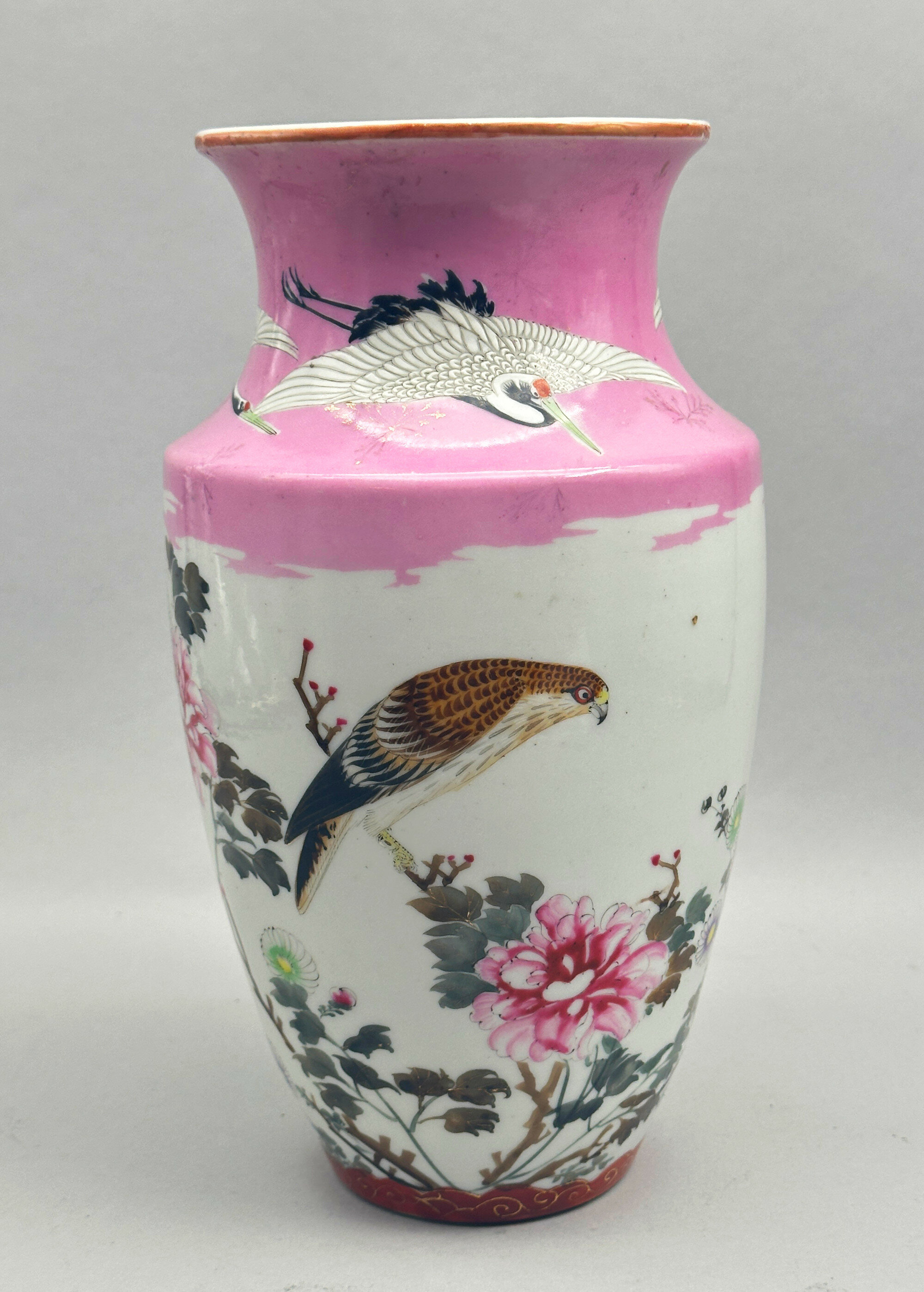
Unusual Japanese Kutani Vase with Pink ground, late C19th
Price: £75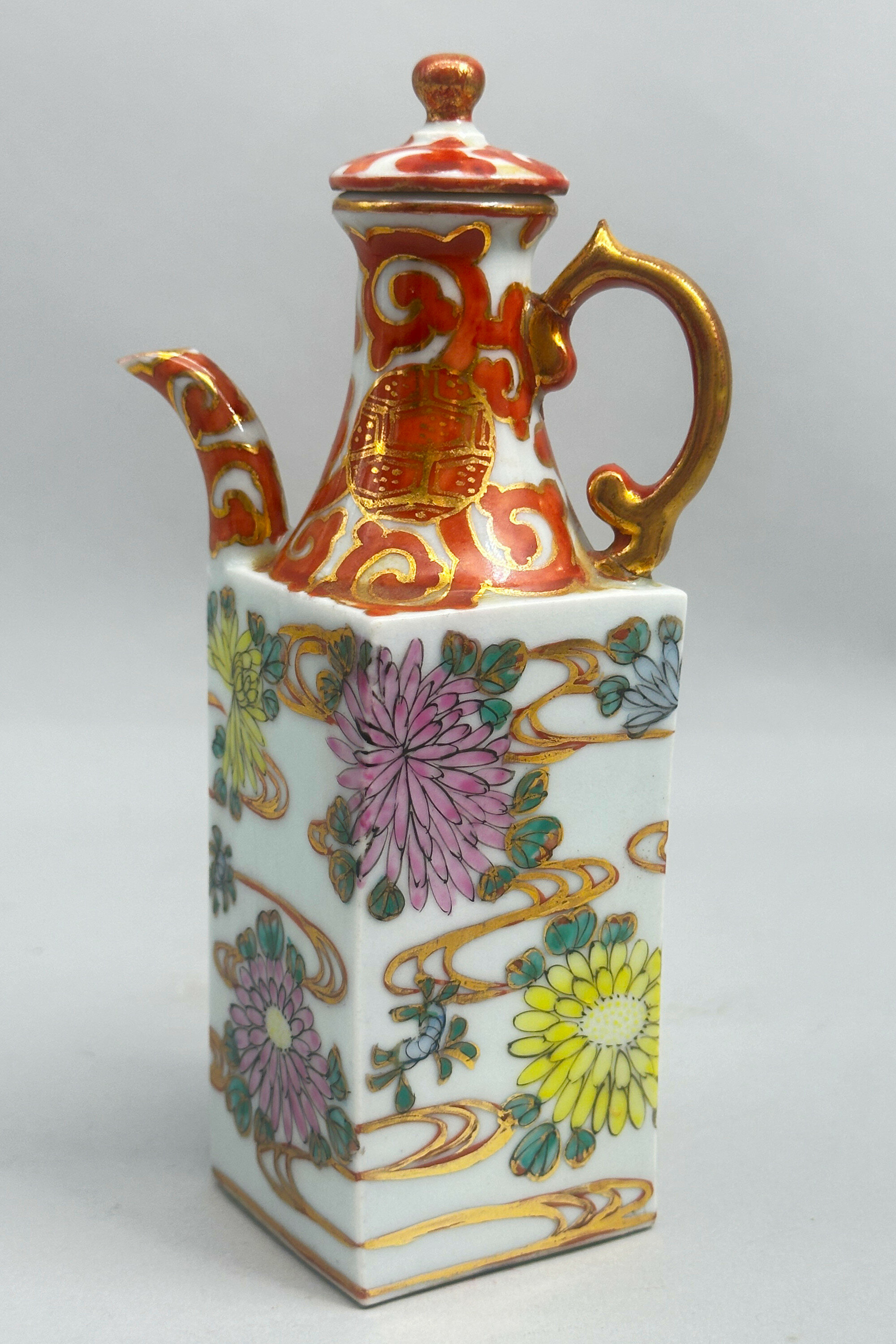
Japanese Arita Square Sake Flask and Cover decorated flowers, C20th
Price: £25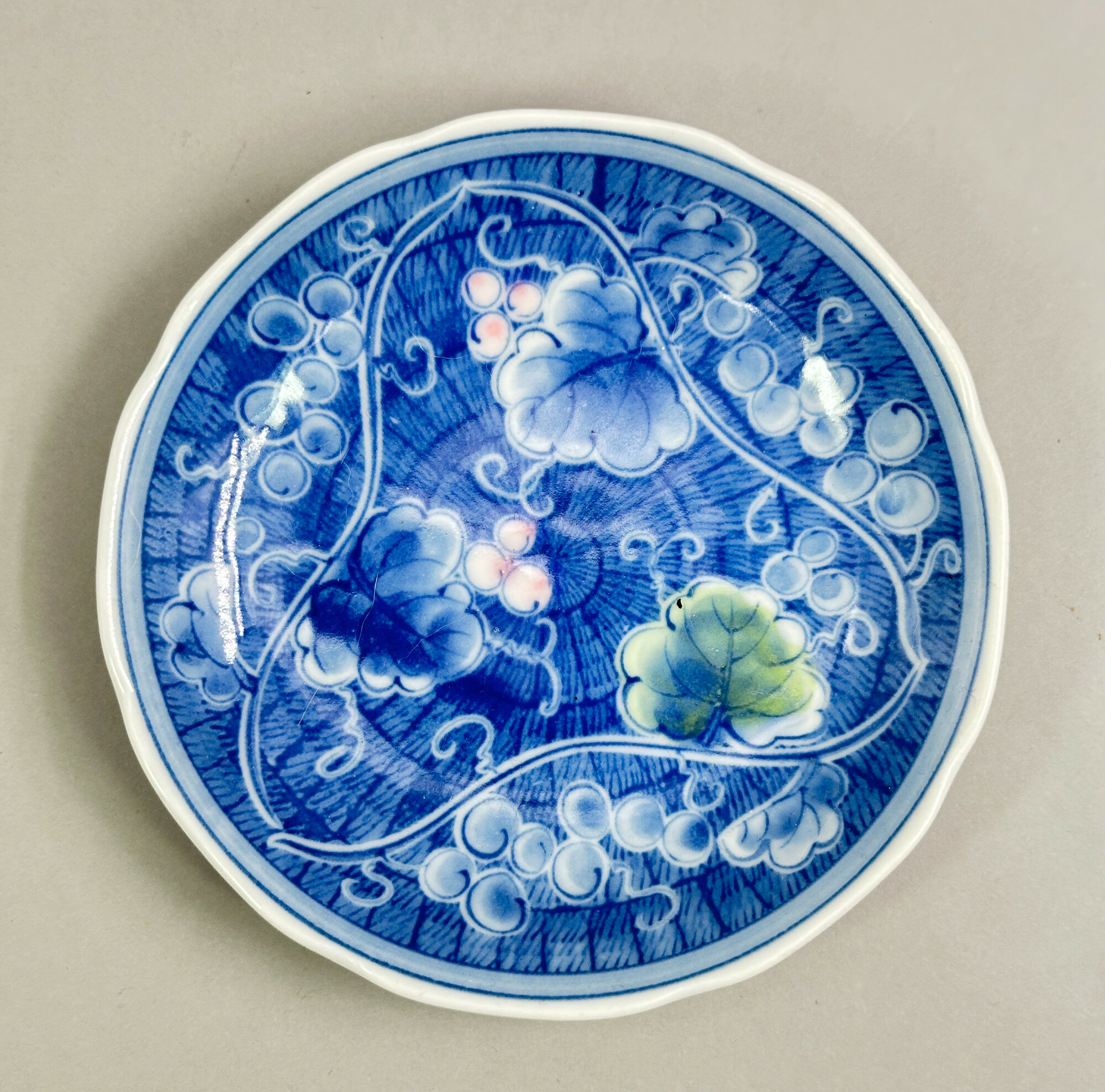
Japanese Arita Blue and White Saucer decorated Gourd and Grapes, mid C20th
Price: £15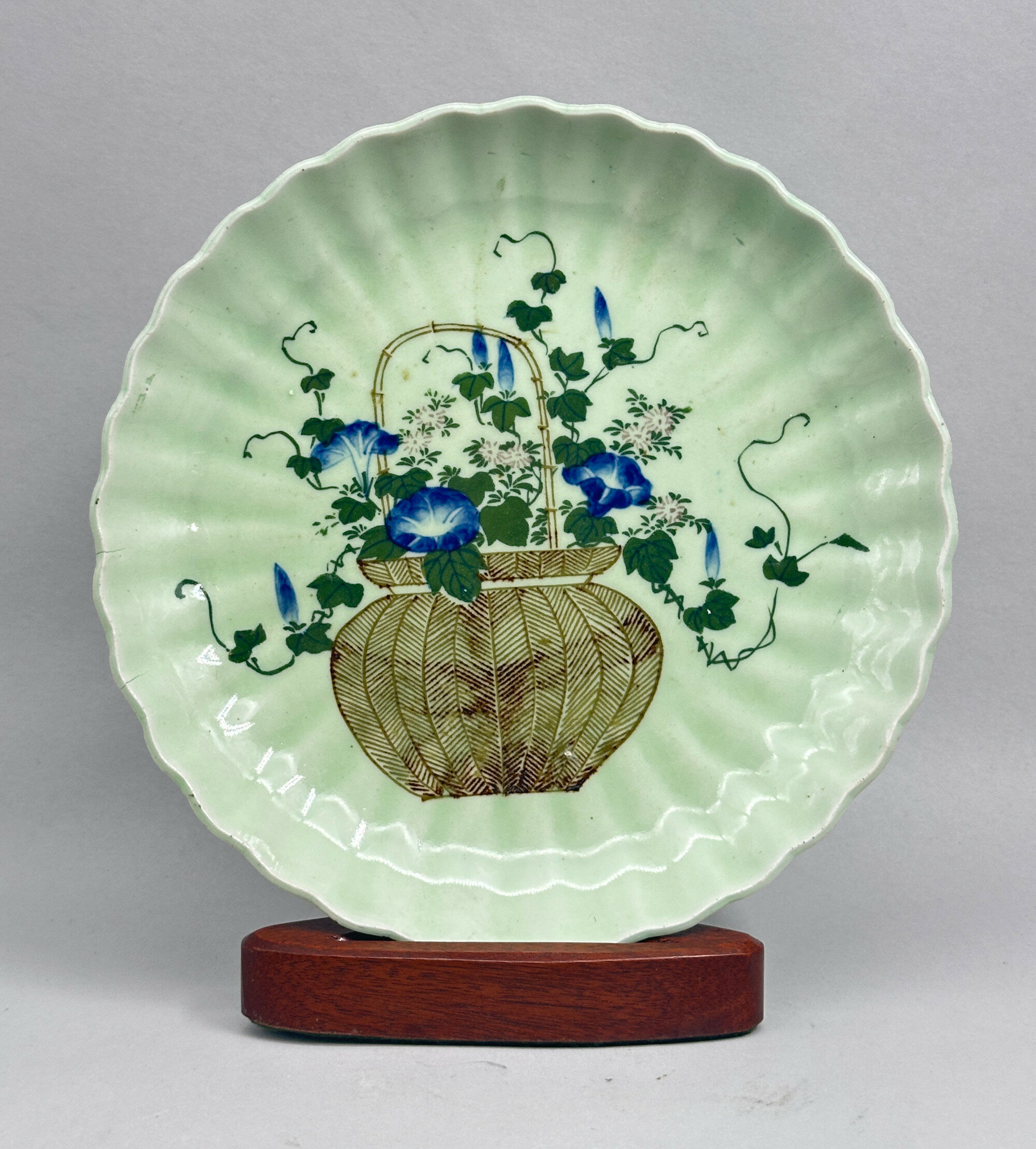
Japanese Celadon Dish decorated basket of flowers, circa 1900
Price: £45Celadon glazed wares with enamel decoration in fairly muted colours are a familiar product amongst the ceramics produced by Japanese potters at the end of the nineteenth century but examples of this type of dish are rather less commonly found. The basket of flowers is a regular decorative feature of Chinese ceramics, but given here a slightly different interpretation with the depiction of lotus, the emblem of summer. The mark probably imitates Chinese ‘commendation’ marks inscribed within the foot rim, another nod on the part of the Japanese potters towards their Chinese counterparts.
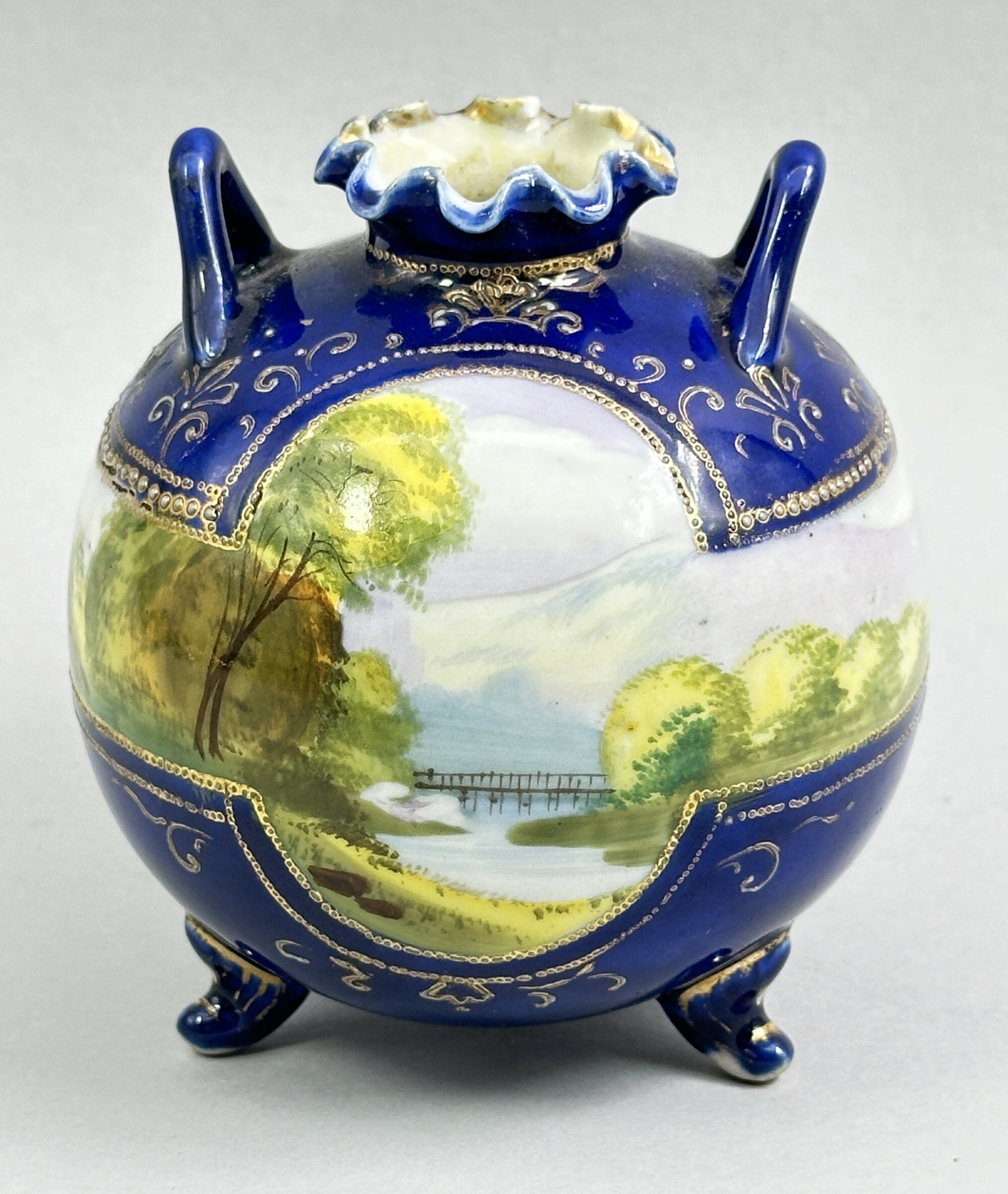
Noritake Vase in the Form of a Pomegranate, marked, Japanese, early 20th Century
Price: £25The Noritake compnay was set up by the Morimura family at Noritake near Nagoya in the early twentieth century. Called at first 'Nippon Toki Kaisha Ltd' on its founding in 1904, the business soon changed its name to 'Noritake' and began the manufacture of porcelains for the domestic and export markets. The mark seen here is interesting. It comprises a 'Komaru' symbol, crowned with "Noritake" and with the mark 'Made In Japan'. The centre symbol said to be taken from the Japanese character "Komaru", meaning "overcoming difficulties". According to the Noritake company tradition this mark was designed when contact with the different culture of the west early in the 20th century caused problems of adaptation. It is also known as the 'tree crest mark' which is the clan crest of the Morimura family. This mark is said to have been registered in London for the UK market by 1908. The curled up ends of the Komaru symbol seen here distinguish this mark from later versions and allow a dating of this piece to the early twentieth century.
Noritake porcelain became synonymous with finely potted tea and breakfast services made in great quantities for export. This vase is a rather more unusual production and shows the factory capable of producing high quality pieces.
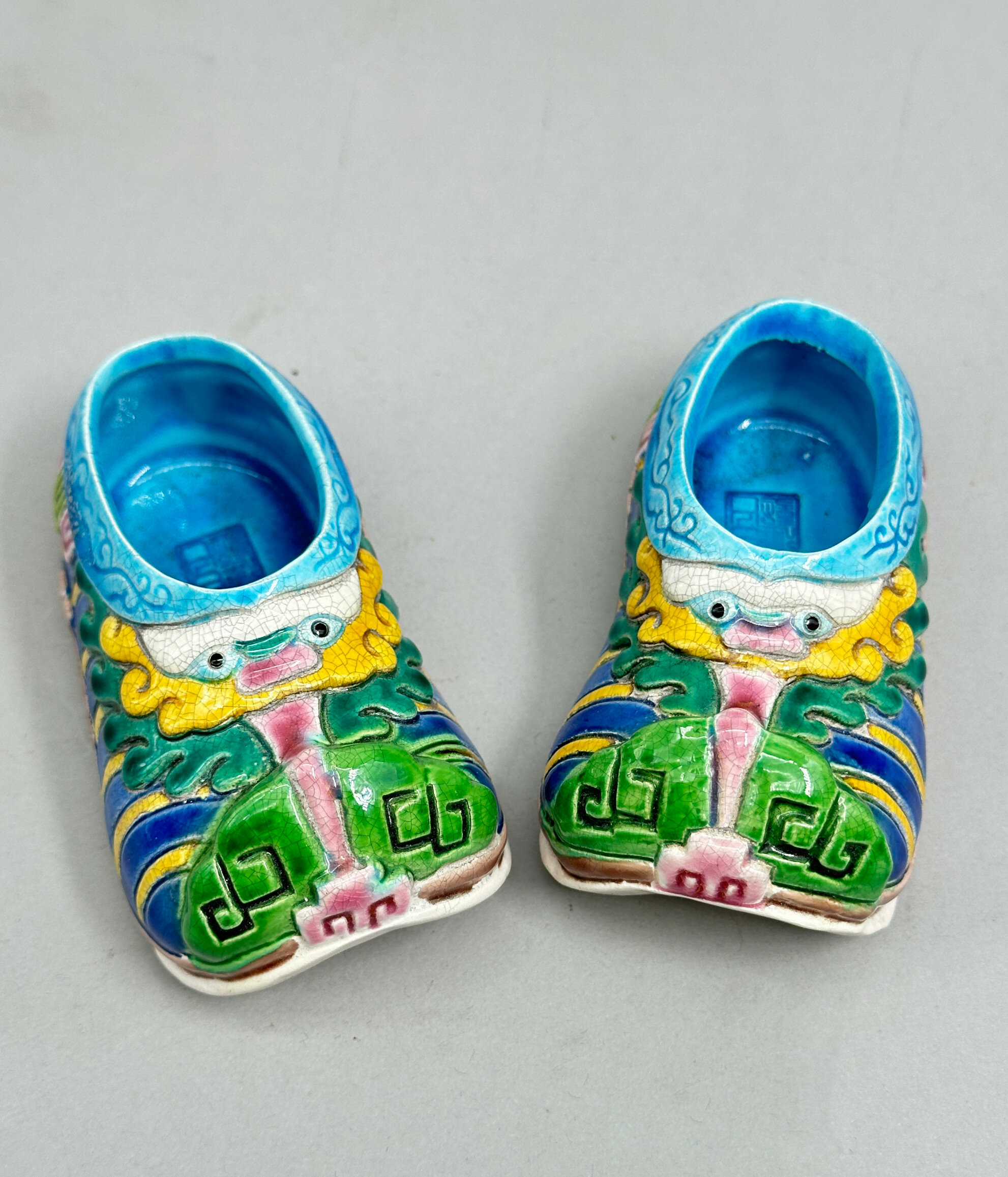
Pair of Chinese Ceramic Shoes, seal mark and with fitted box, C20th
Price: £55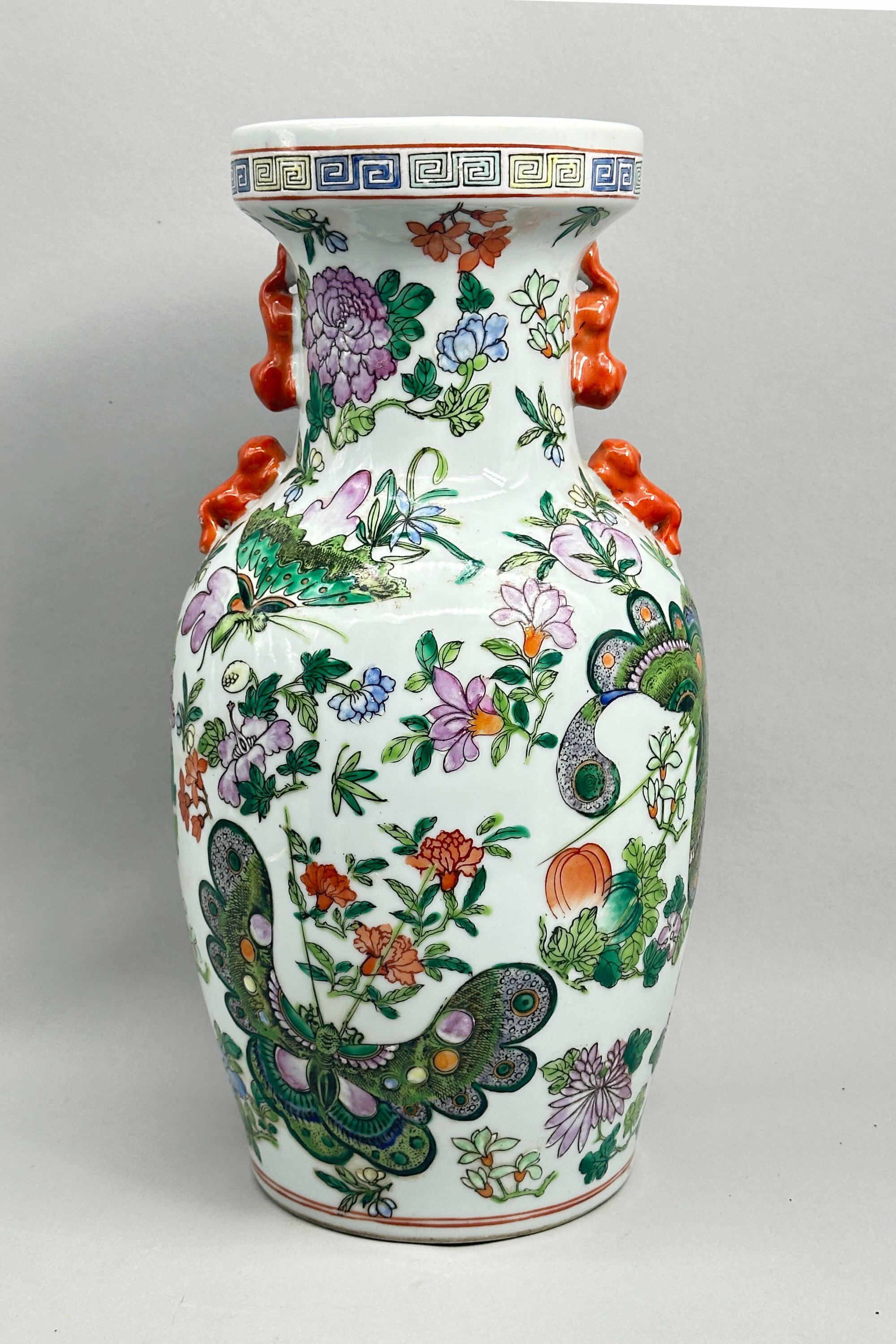
Chinese Cantonese style Vase decorated butterflies, late C20th
Price: £150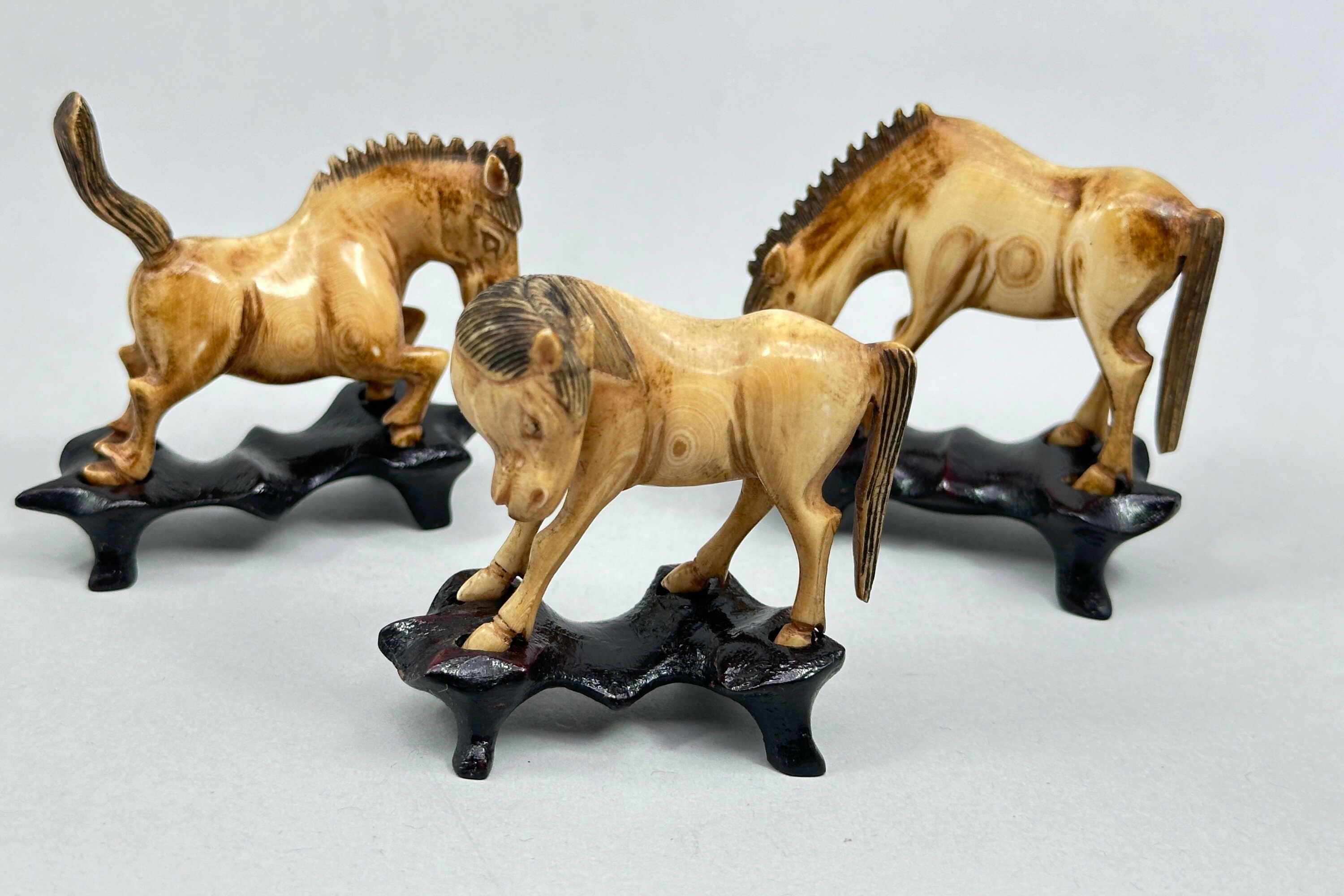
Group of Three Chinese carved bone Horses with wood stands, probably mid C20th
Price: £30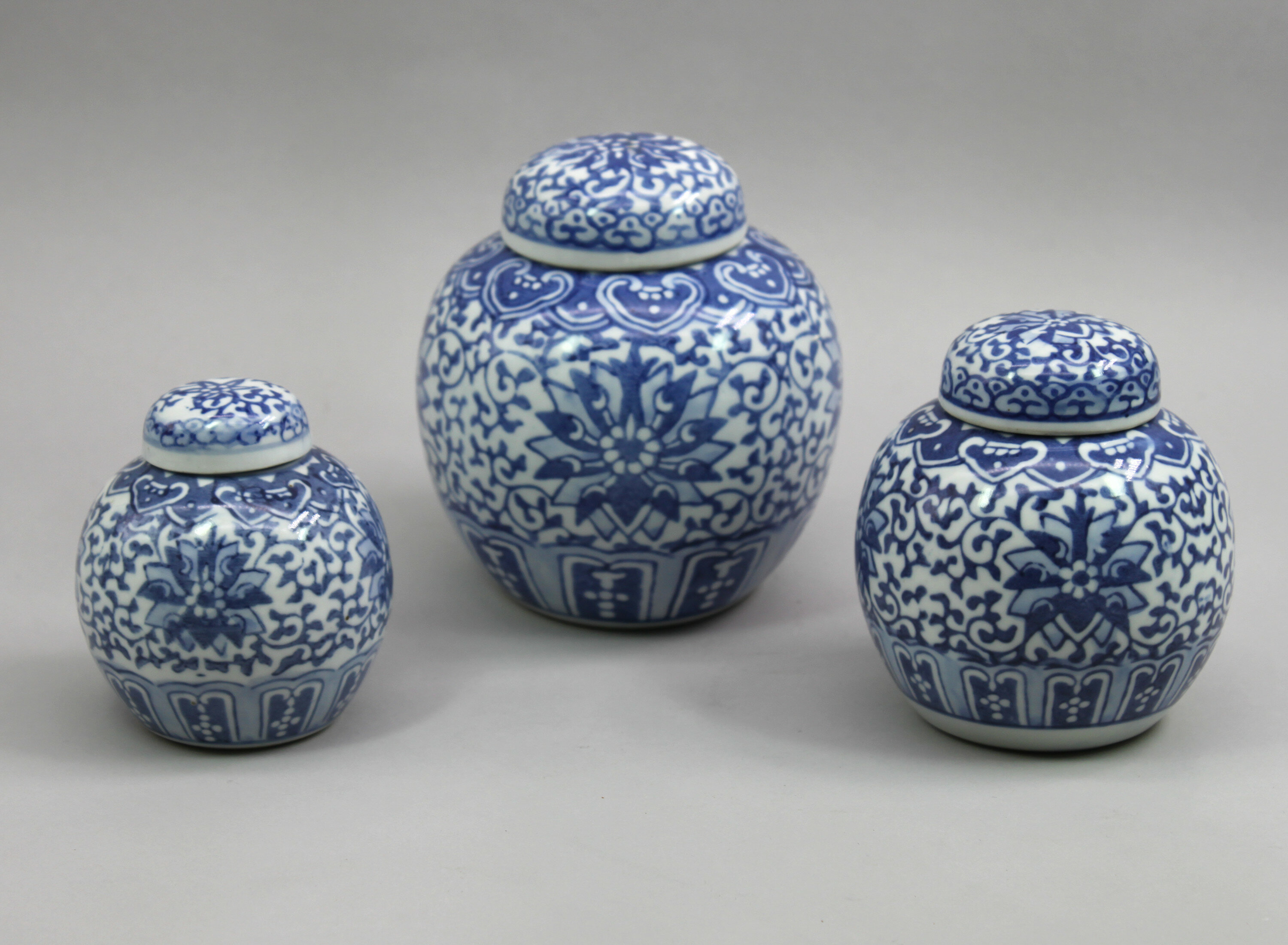
Graduated set of Three Chinese Blue and White Ginger Jars and Covers, 20th Century
Price: £45Although of relatively recent manufacture, the quality of these pieces continues the Chinese ceramic productions of the late nineteenth century and together they form an attractive decorative ensemble for the contemporary interior.
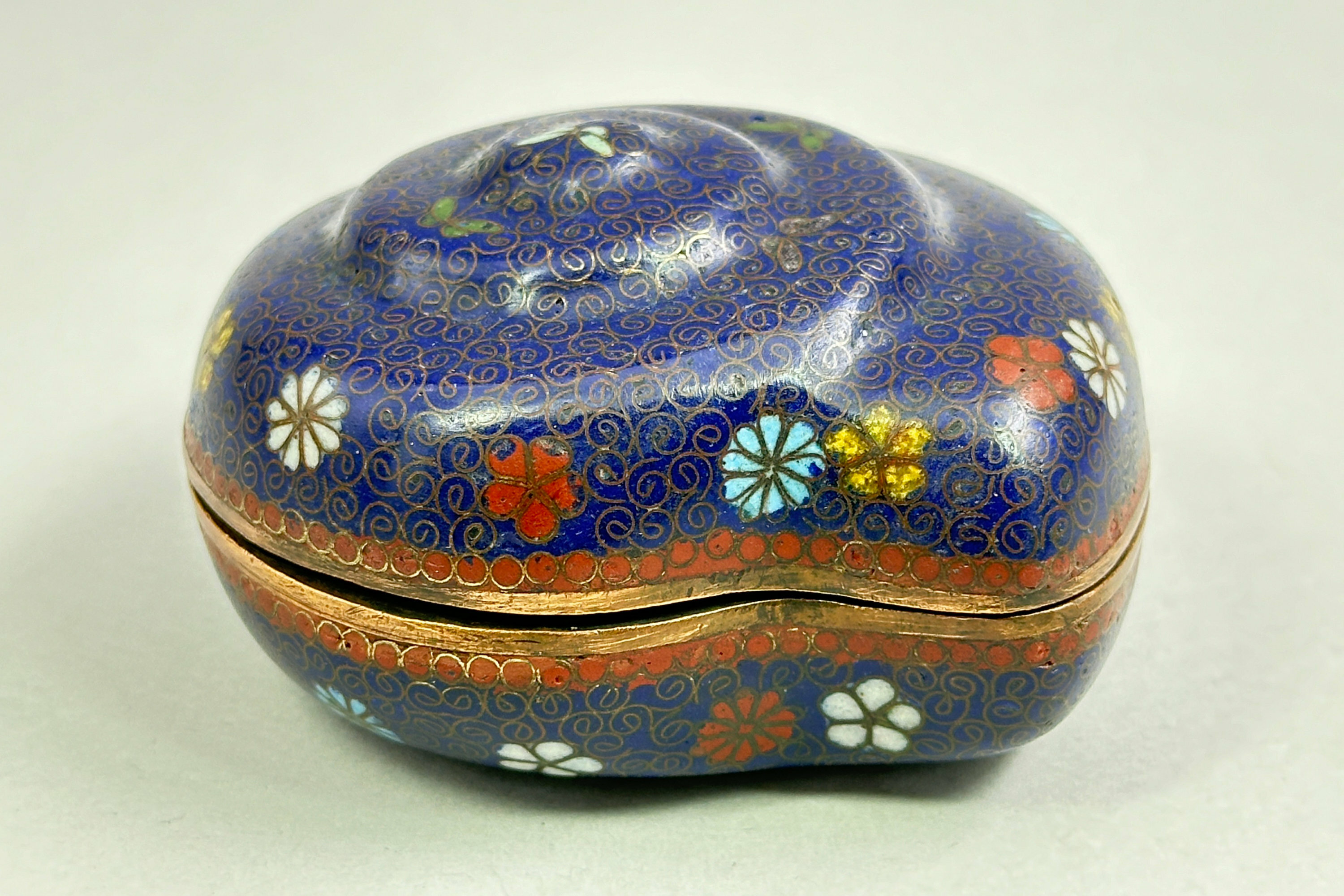
Fine Quality Cloisonne Box and Cover in the form of a Snail, Japanese circa 1880
Price: £95The Japanese produced copies of natural forms in a variety of media. Carved ivory fruit and small animals are well known. Here, cloisonne enamel is used which is less common. The quality of the work speaks for itself and can be judged form the small butterflies on the cover and the green speckle enamel fill at the base. It is typical of the best Meiji period (1868-1912) work and a circa date towards the end of the nineteenth century is most likely.
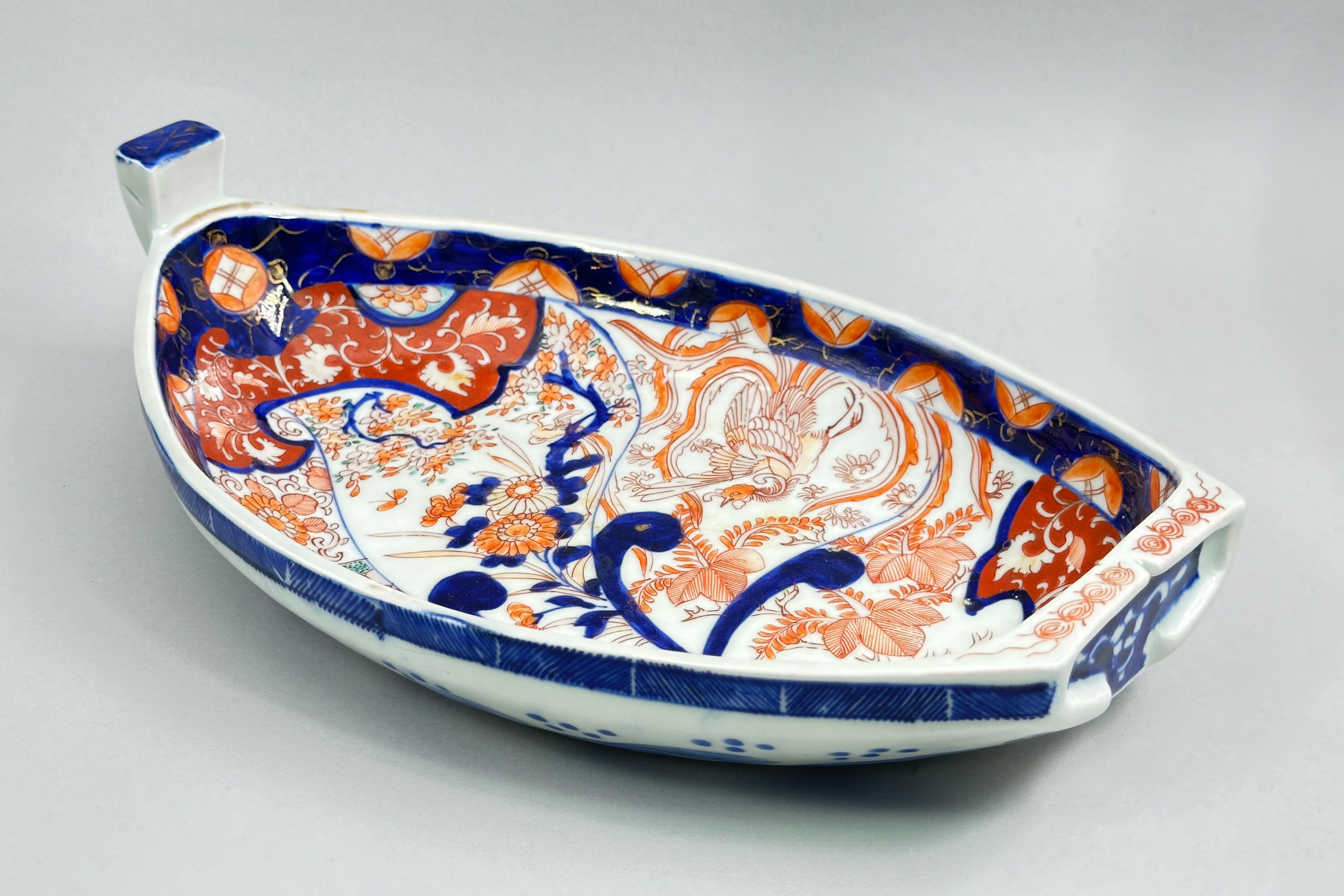
Japanese Imari Dish in the form of a Treasure Boat ‘Takarabune’, Meiji Period, circa 1900
Price: £250In Japanese folklore, the Takarabune or "Treasure Ship", is a mythical ship piloted through the heavens by the Seven Lucky Gods during the first three days of the New Year. Ceramic boat shape dishes were produced during the Meiji period (1868-1912) in both Arita and Imari porcelains. Paste of the foot rim and style of decoration suggest a circa date here towards the end of the nineteenth century.

Chinese Straw Thread Picture on Silk, framed in original box, late C20th
Price: £45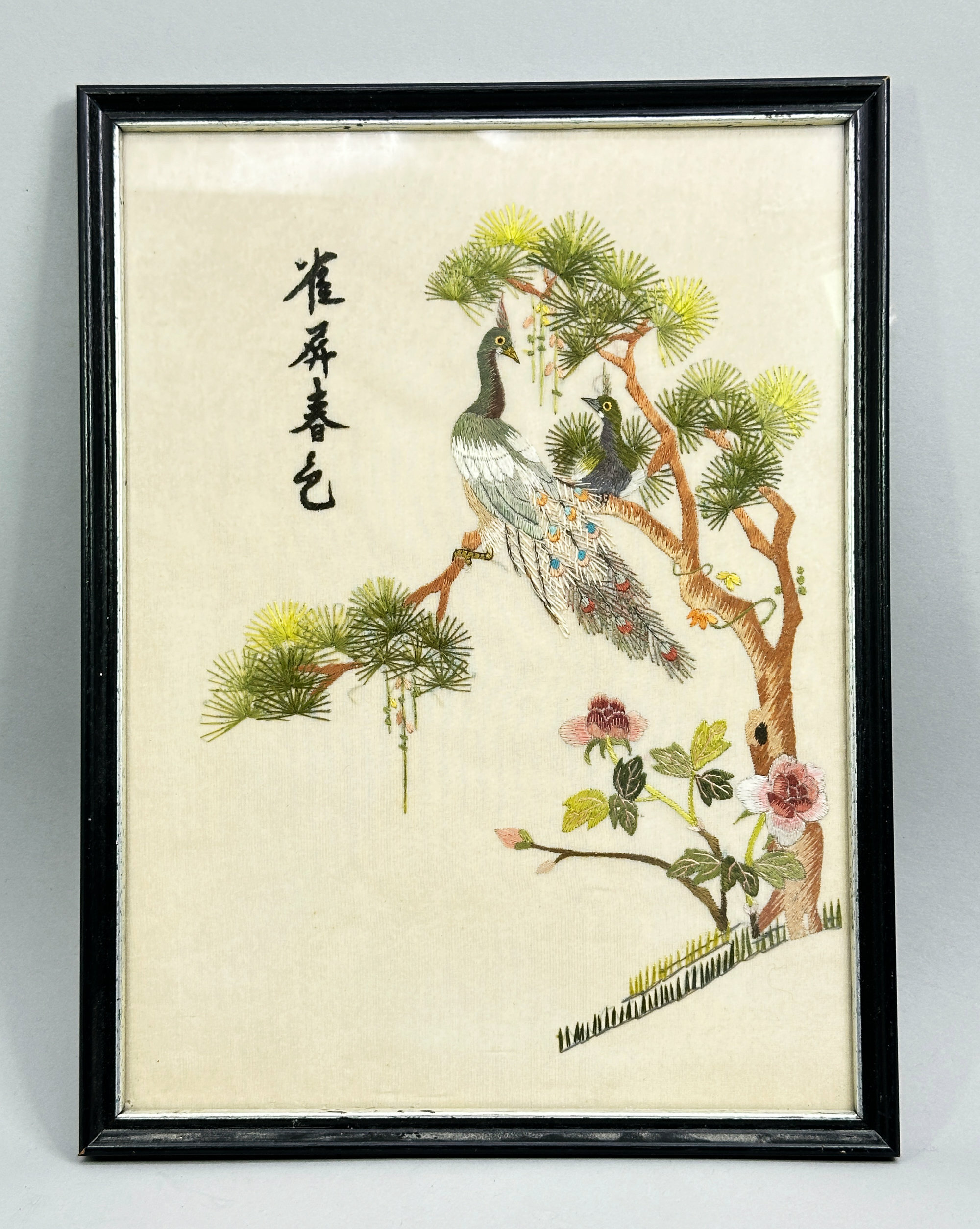
Framed Chinese Embroidery Silk Textile, signed, second half C20th
Price: £25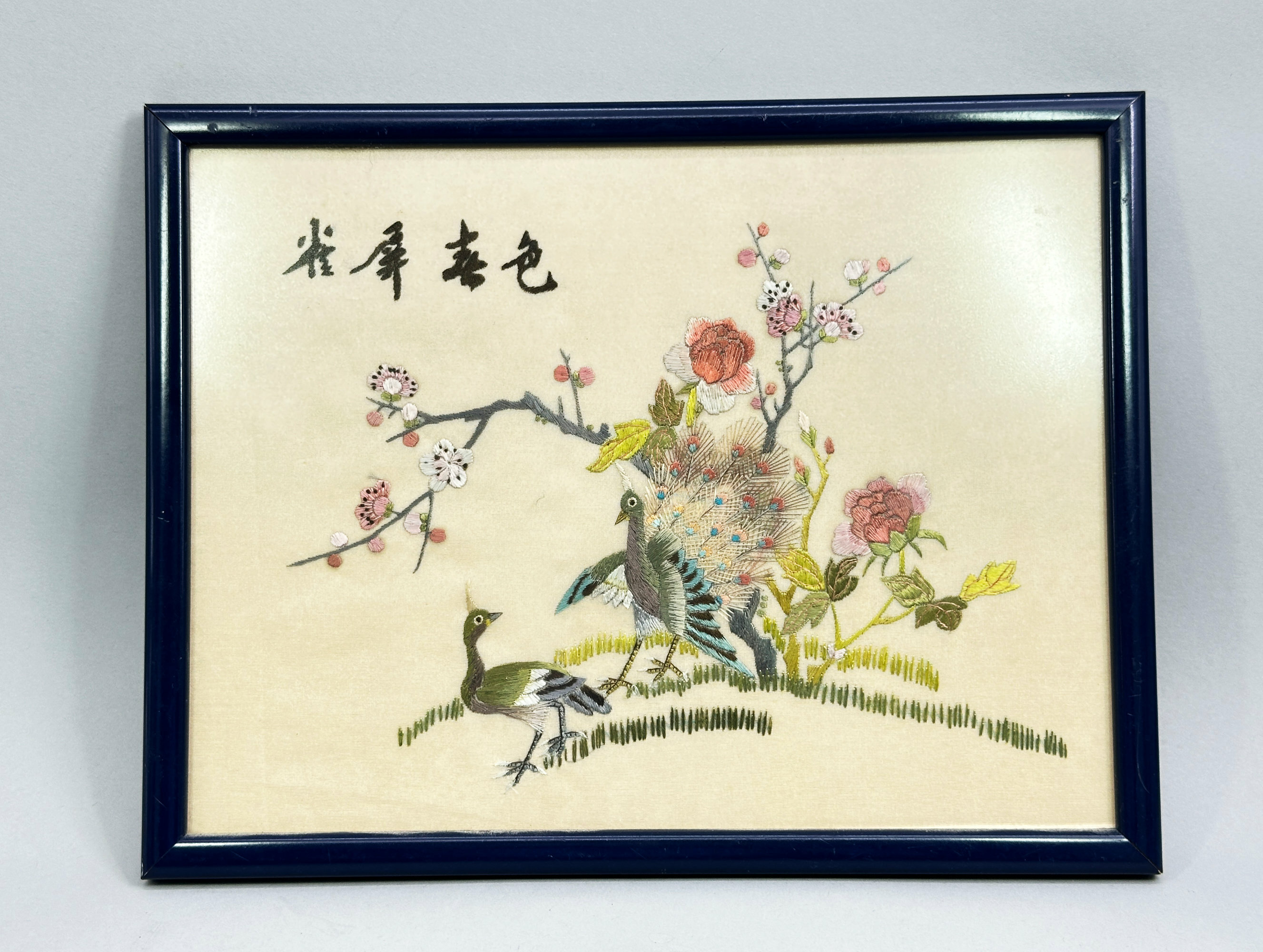
Framed Chinese Embroidery Silk Textile, signed, second half C20th
Price: £25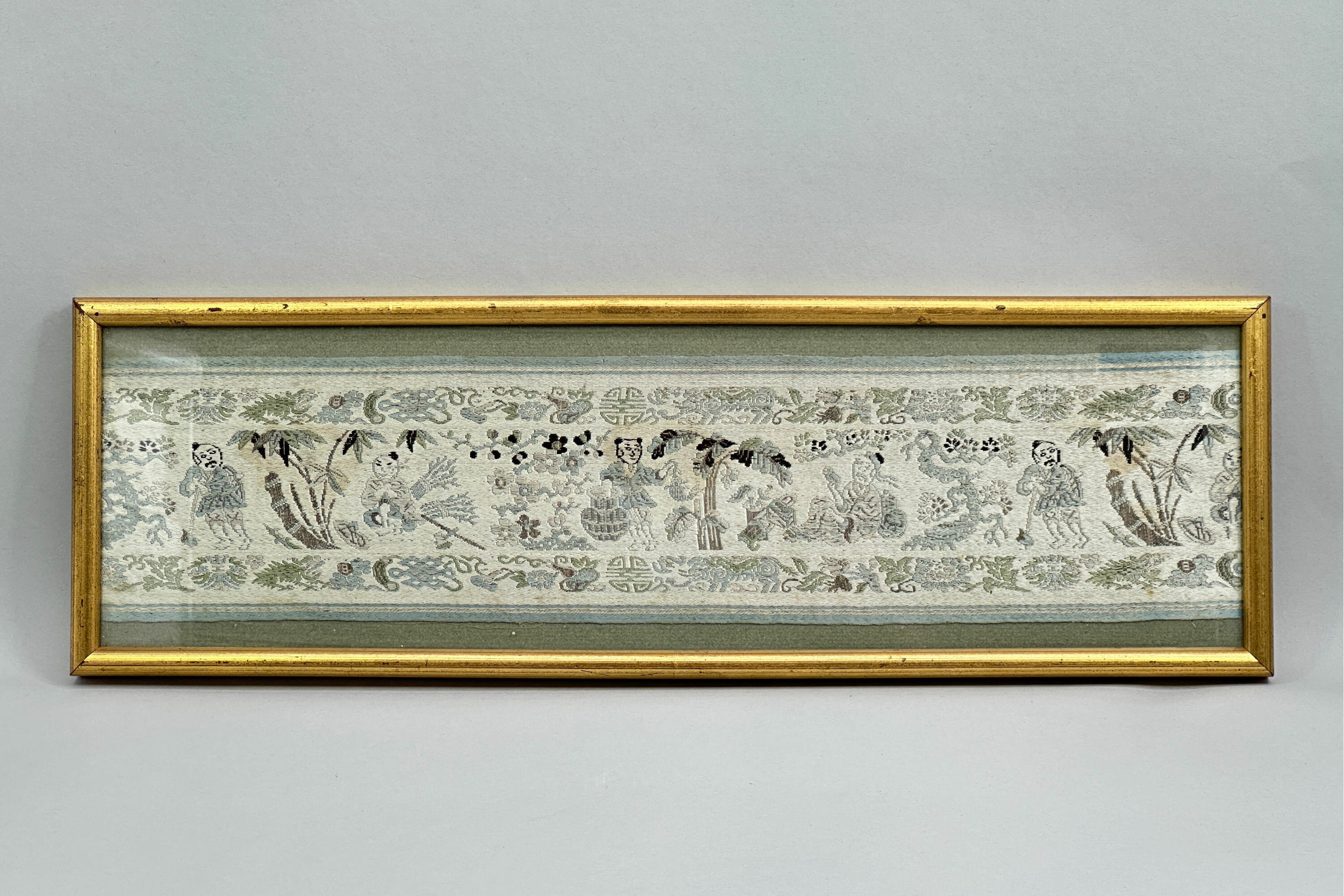
Framed Chinese Silk Embroidered Runner Panel, garden scenes, C20th
Price: £15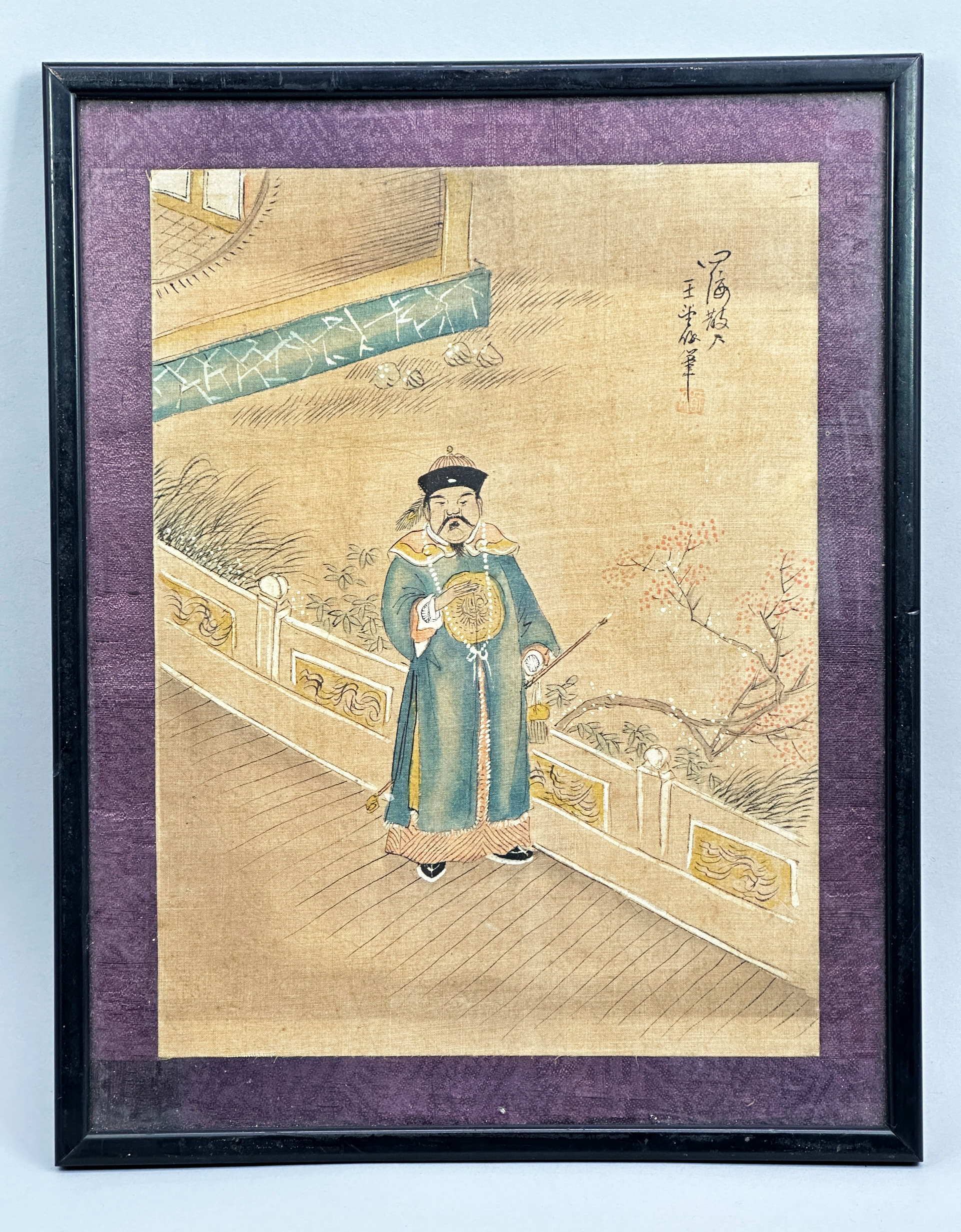
Framed Chinese Painting of a Court Official, C20th
Price: £45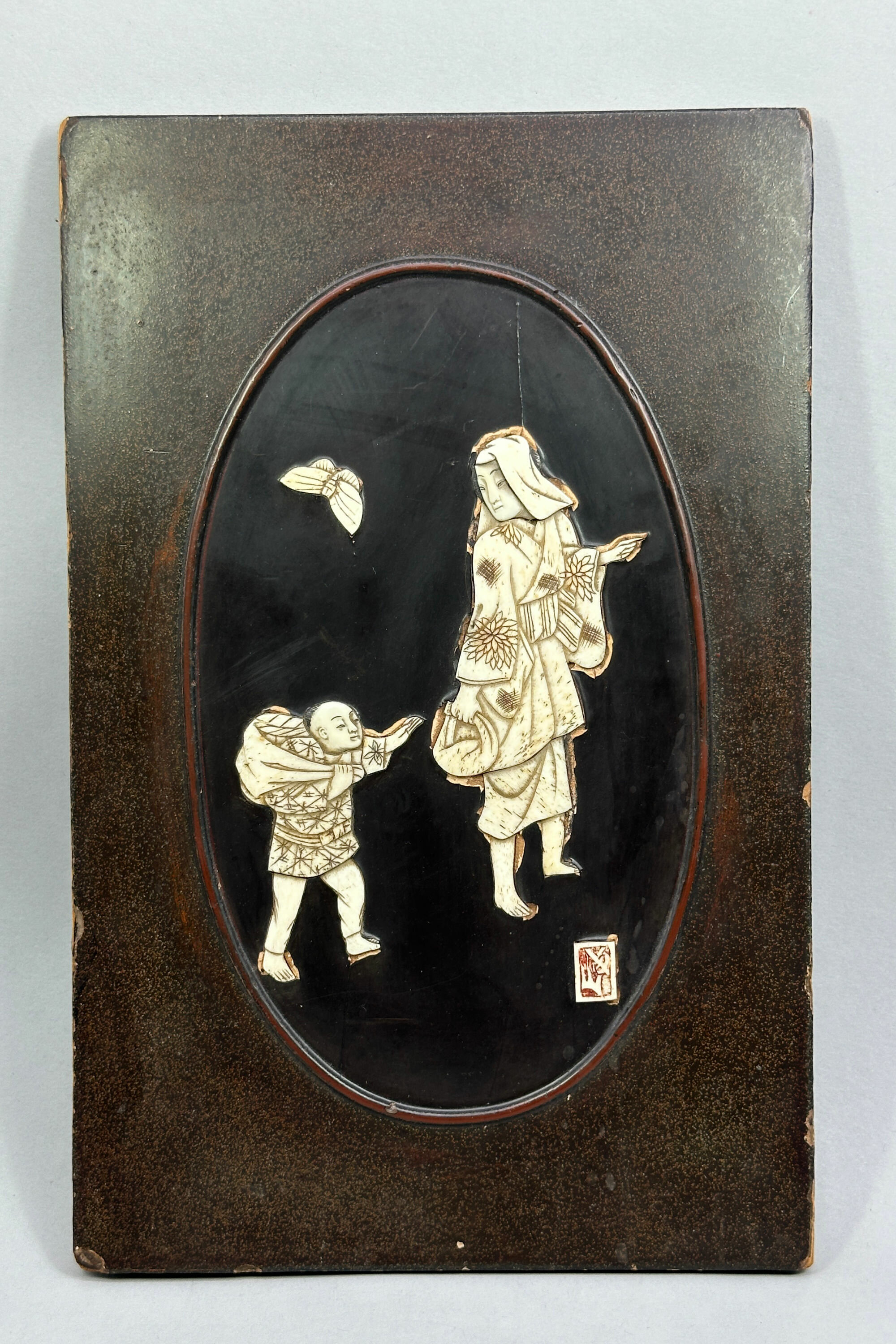
Japanese Bone and Lacquer Plaque, Lady and Boy, signed, late C19th
Price: £45These bone and lacquer plaques were produced in great quantities by Japanese artists in the late nineteenth century for export to the West and became a familiar feature of the European drawing room. The medium was easily subject to damage and loss, especially in respect of the bone inlay, and while this example has some slight damage this is confined to a crack in the lacquer ground of the panel itself and some chipping to the extremities of the panel. The decoration of the figures remains intact (the surround seems to have been cut away in some places to give added definition to the composition) and allows appreciation of the skill with which they were carved, presenting a genre scene of great charm.
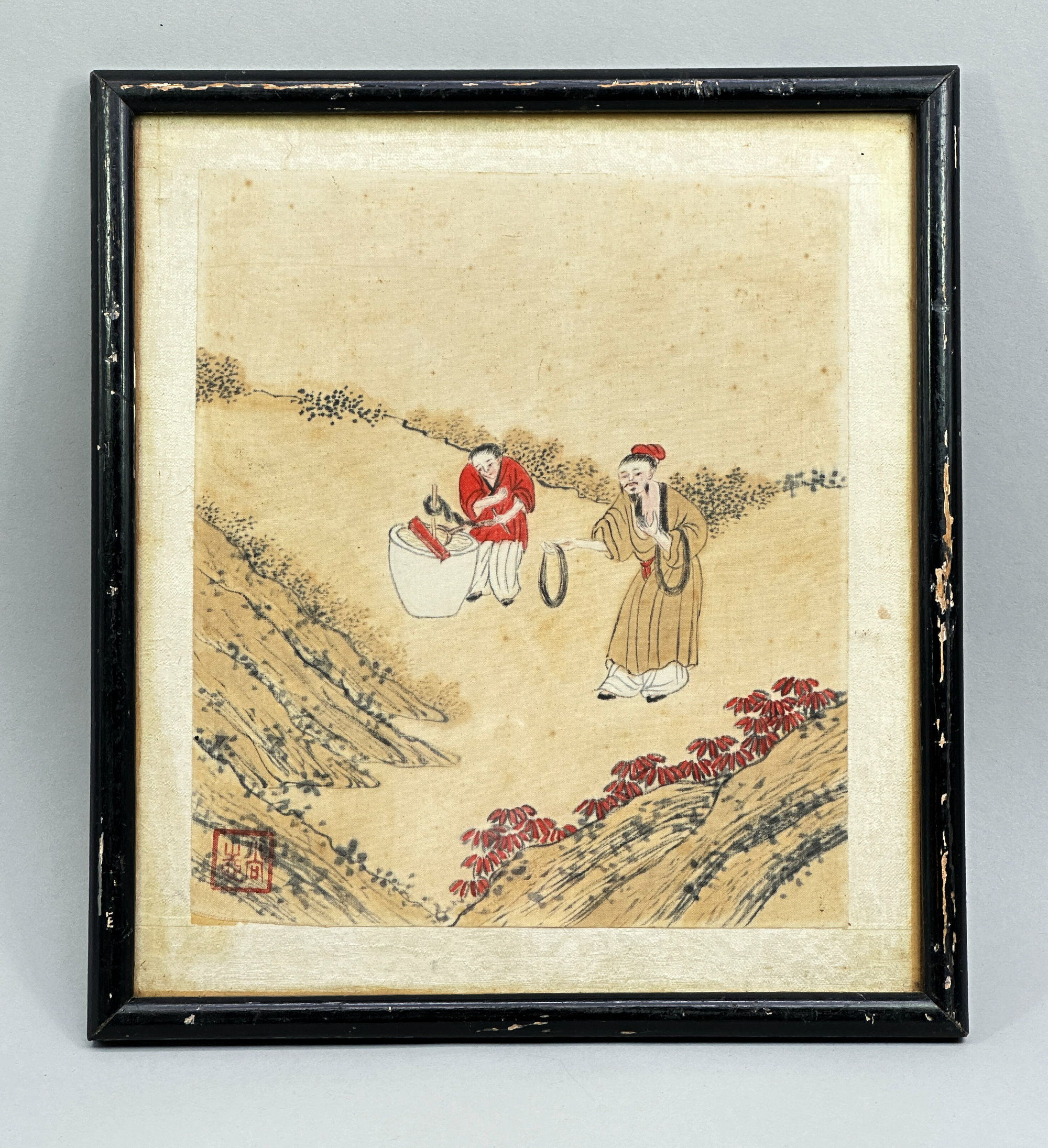
Framed Chinese painting on silk, two Silk Dyers, C19th/C20th
Price: £15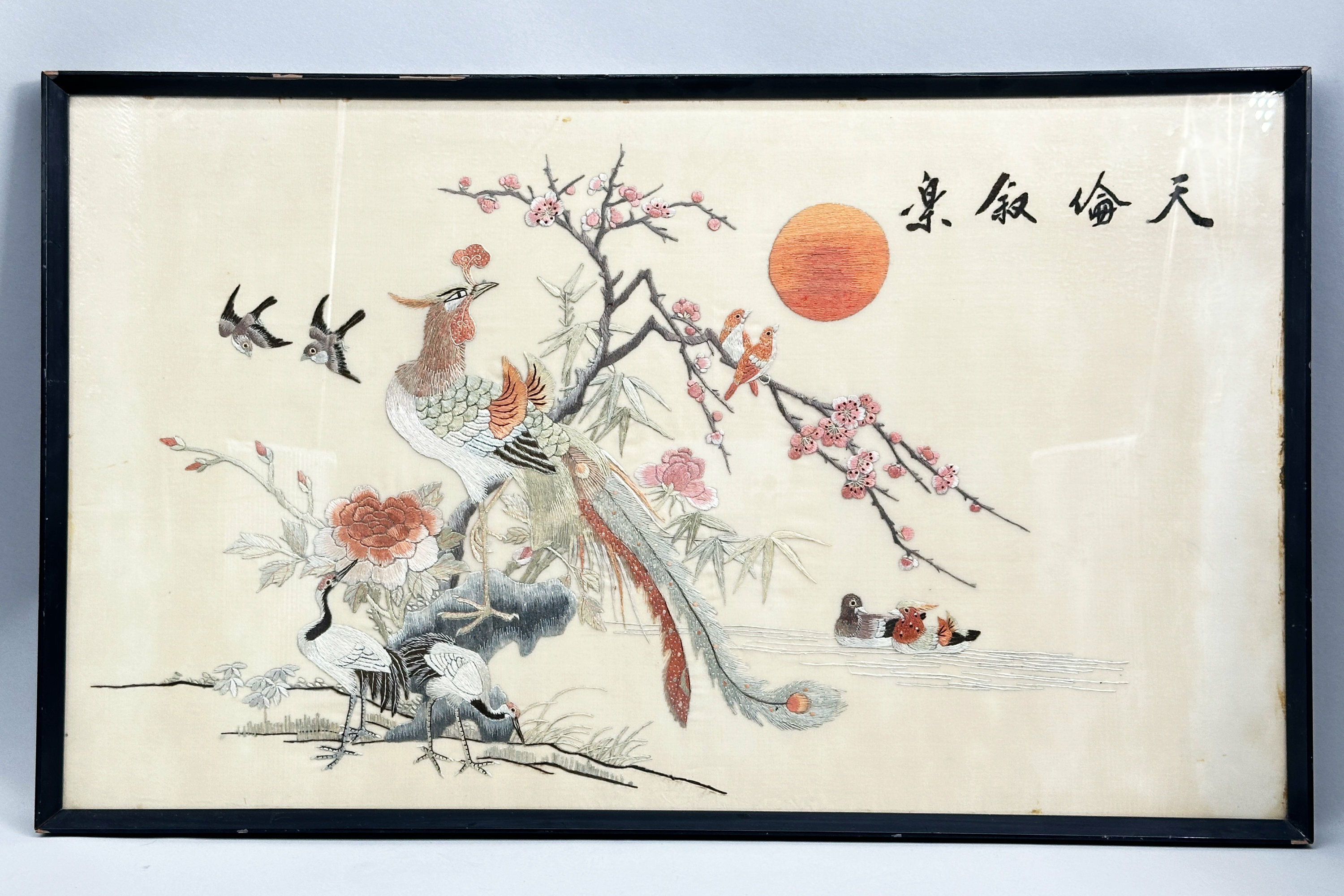
Framed Chinese Embroidery Silk Textile, signed, second half C20th
Price: £45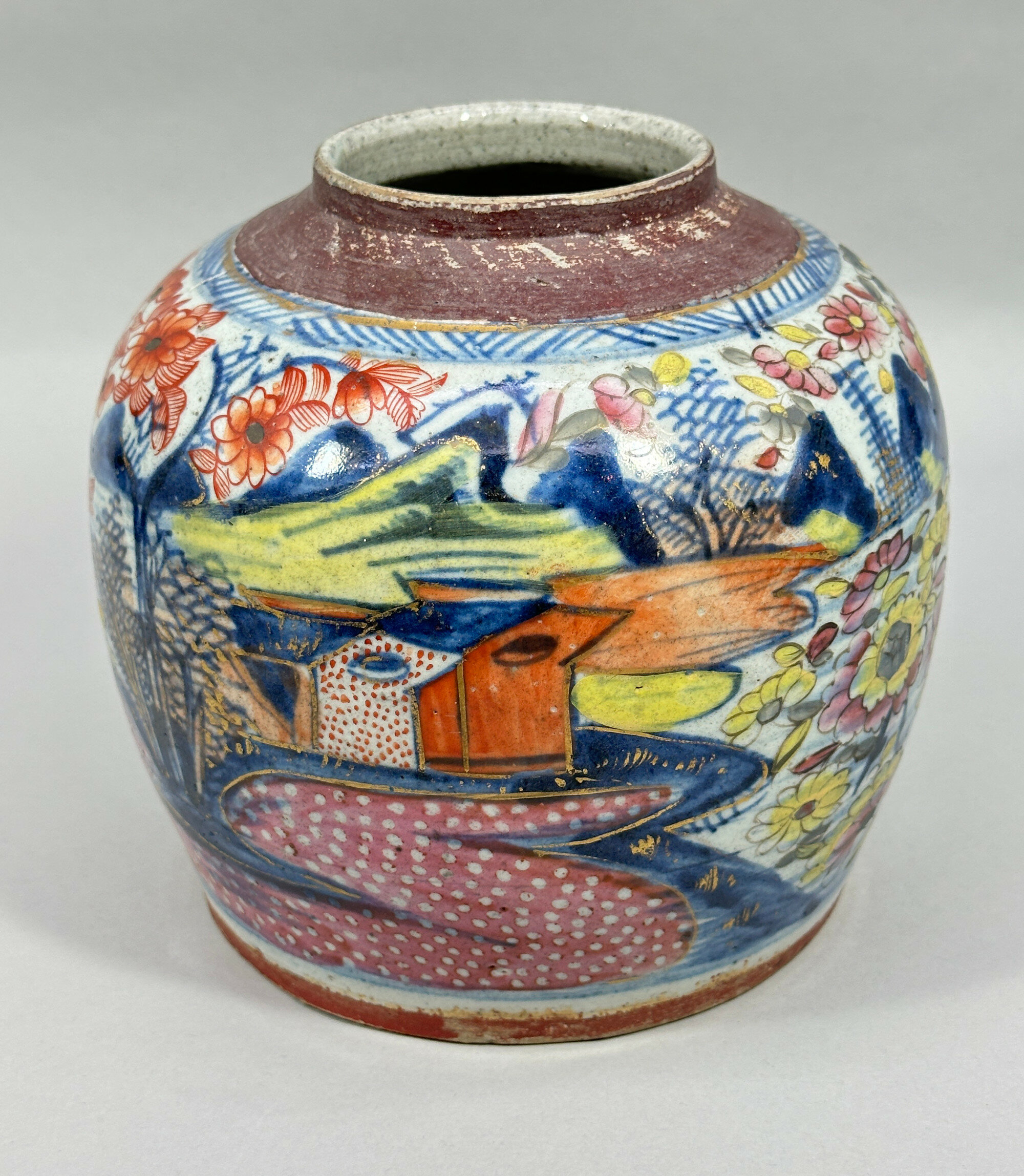
Chinese Ginger Jar Clobbered Decoration circa 1800
Price: £55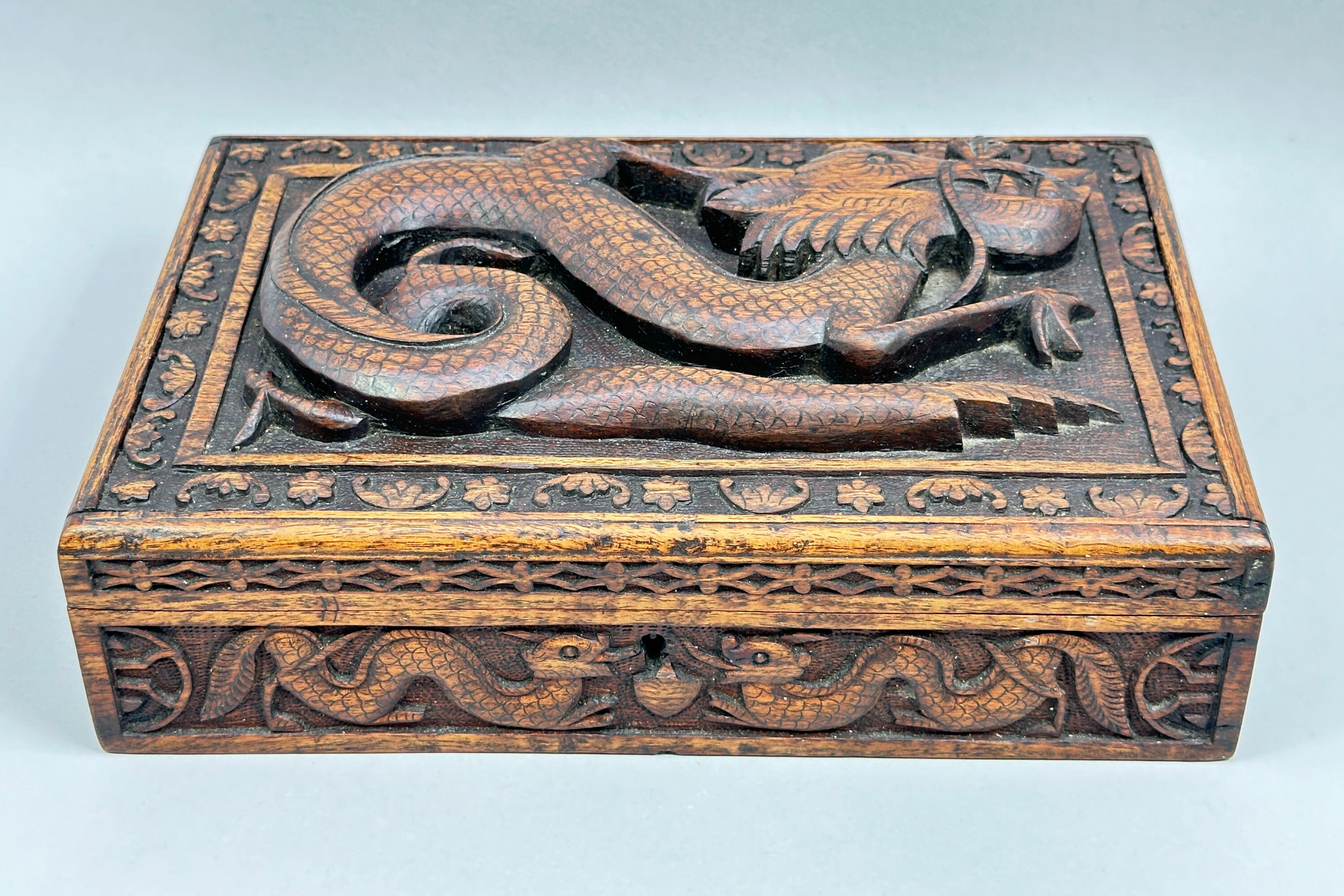
Chinese carved wood Box decorated Dragons, early C20th
Price: £150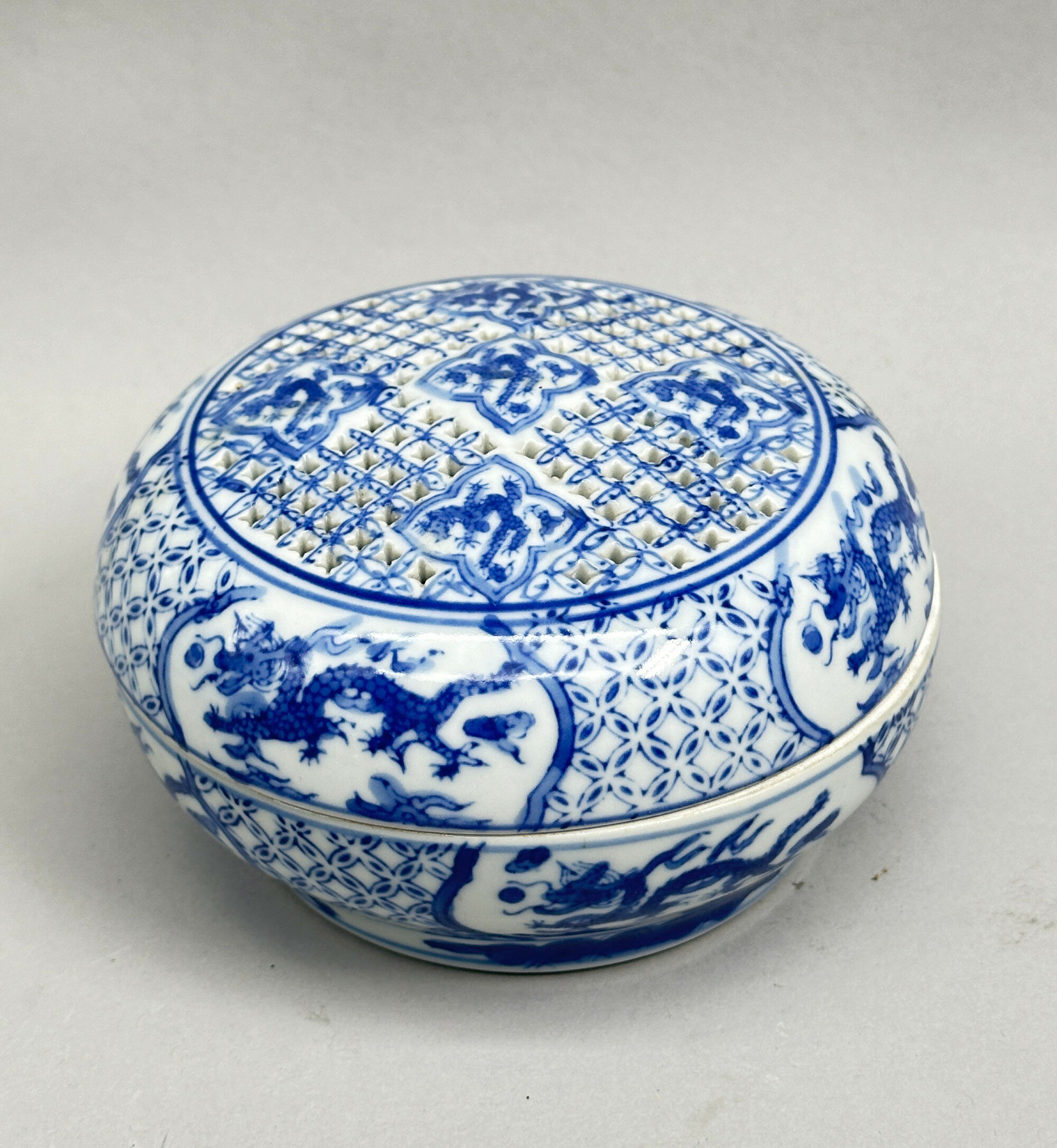
Chinese Blue and White Box and Cover with pierced lid, late C20th
Price: £25The Charles Sadek Import Company was founded in 1936 by the father and son Charles and Norman Sadek and began by importing decorative items from Japan later broadening their range to a wider variety of suppliers including China. These pieces were sold under the ‘Andrea by Sadek’ brand, named after Norman's daughter Andrea. The business continued to a third generation until it was taken over by Fitz & Floyd in 2015.
This box, then, is a typical example of their range of wares, good quality decorative items marketed at an affordable price. The quality of these boxes can vary and this piece seems to be an above average example.
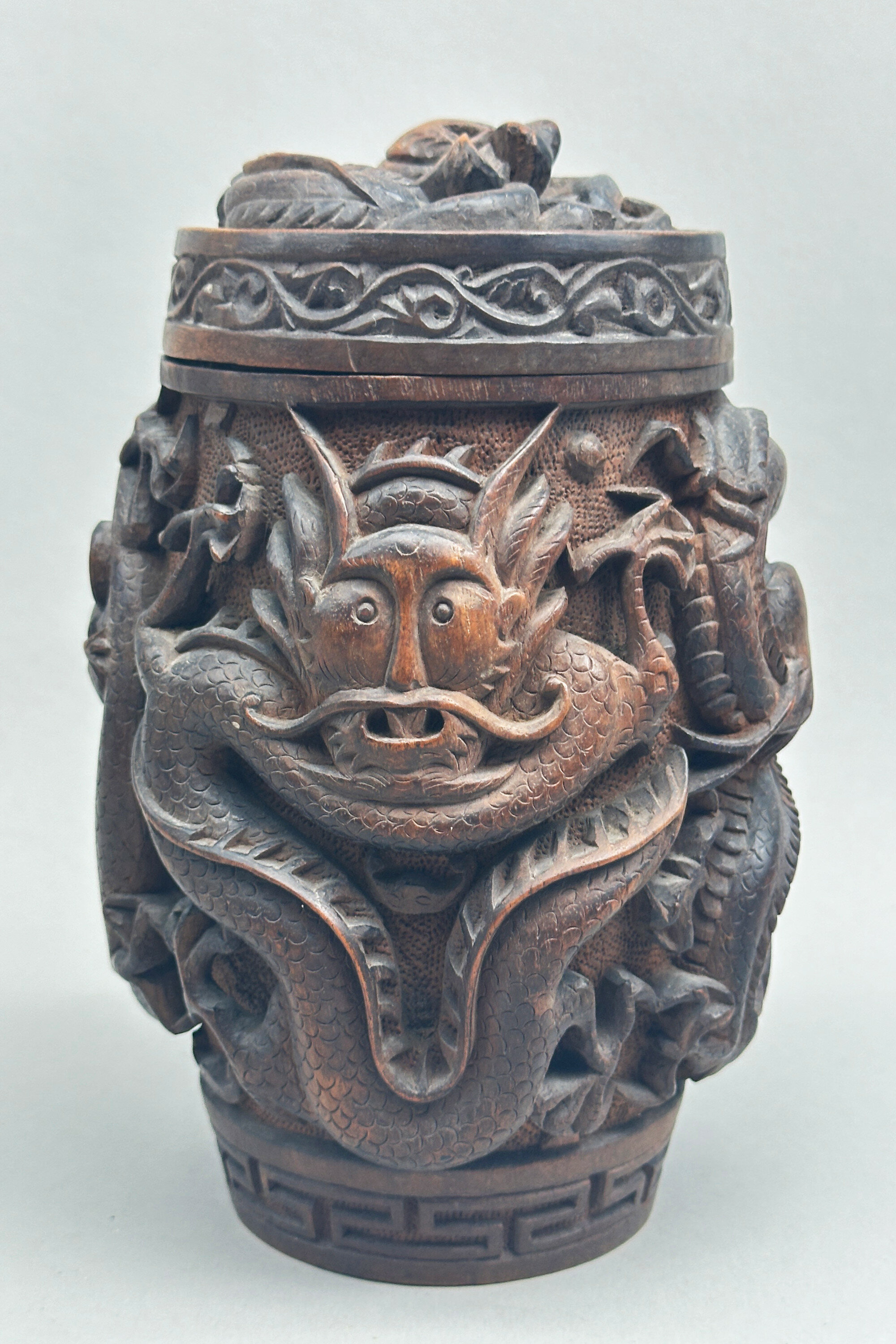
Chinese ovoid carved wood Tobacco Jar decorated dragons, early C20th
Price: £75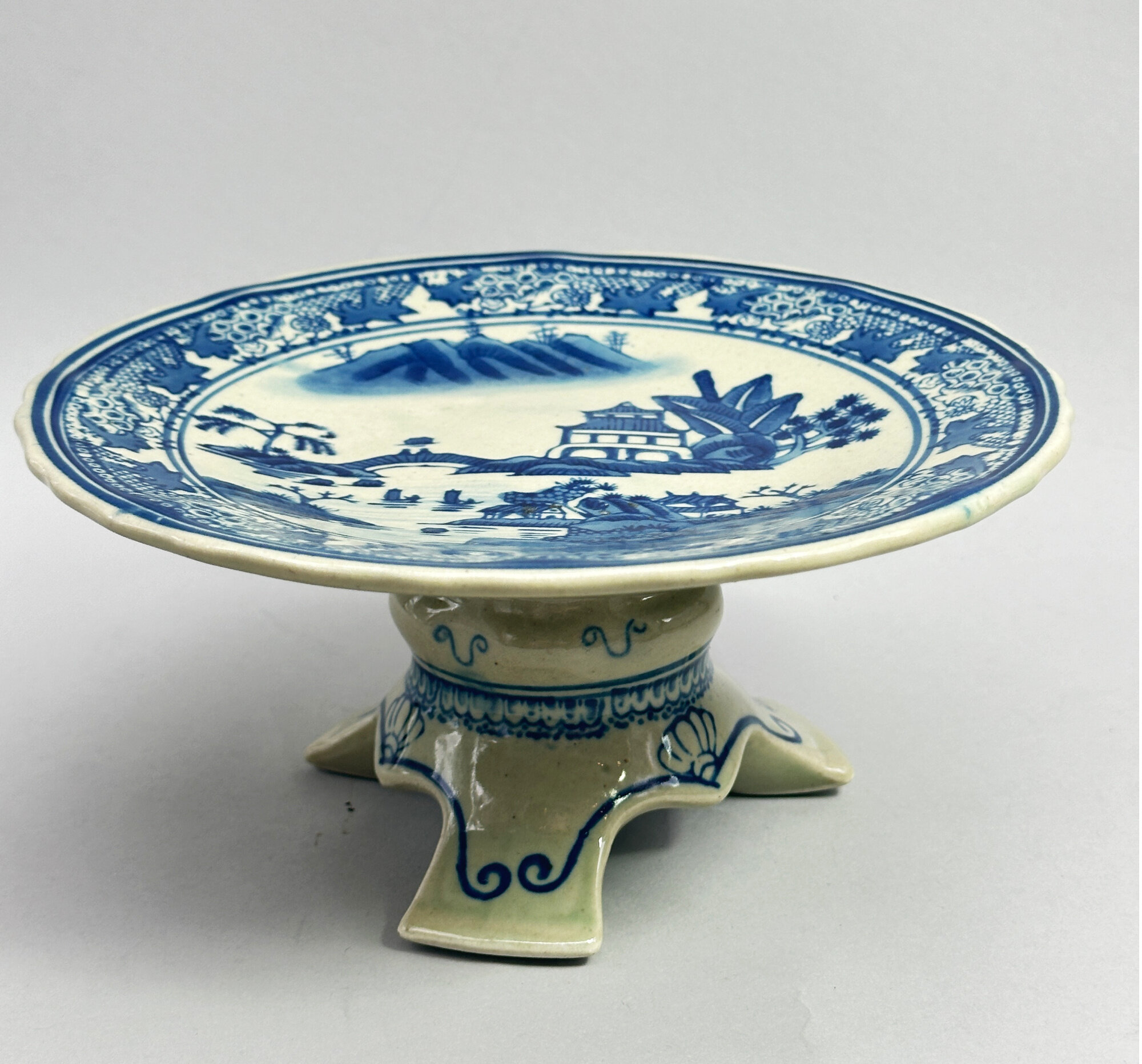
Japanese Celadon Ground Tazza with Chinese Nanking decoration, late C19th
Price: £25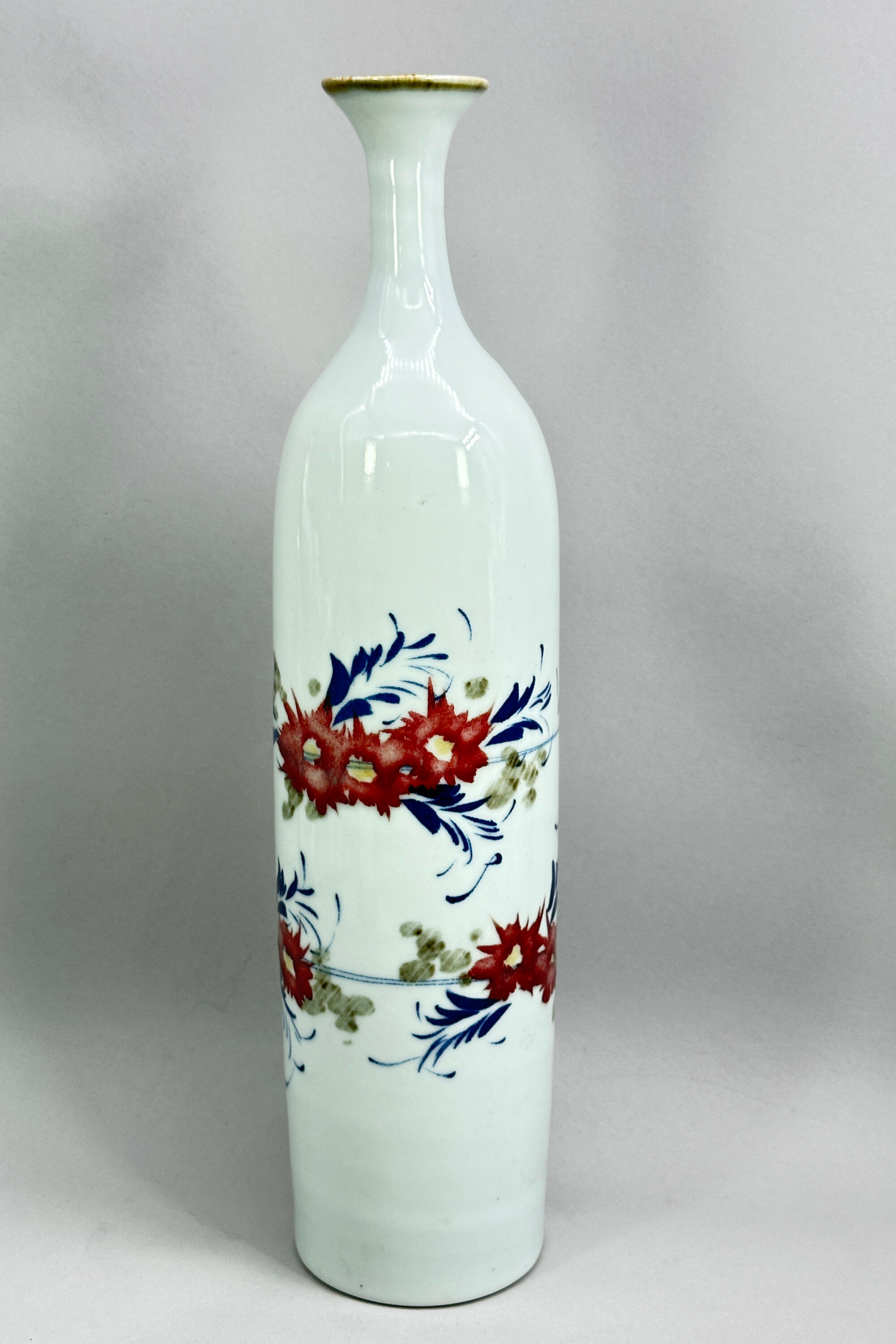
Japanese Studio Pottery Vase, signed, C20th
Price: £75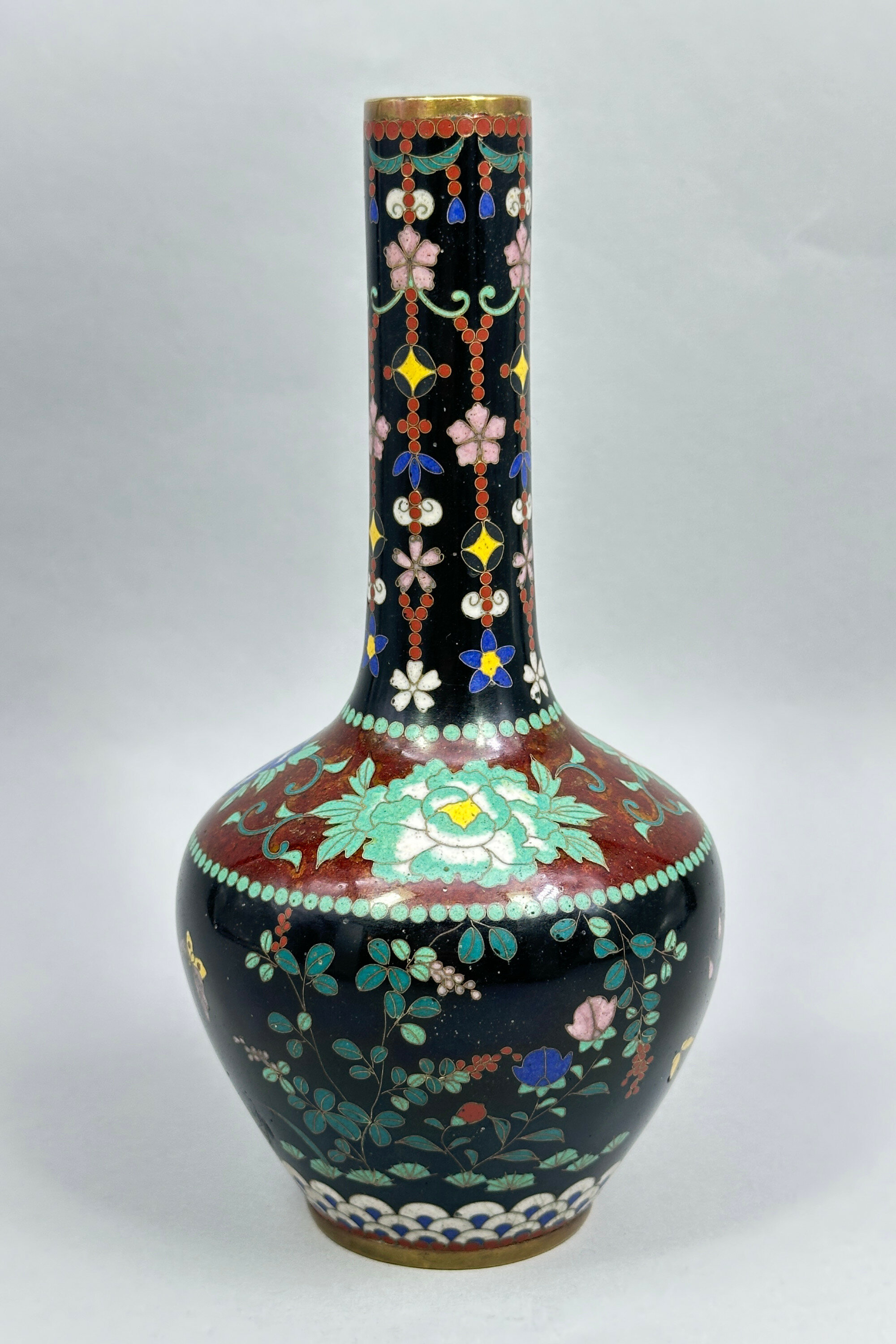
Fine quality Japanese Cloisonne bottle form Vase with black ground, late C19th
Price: £45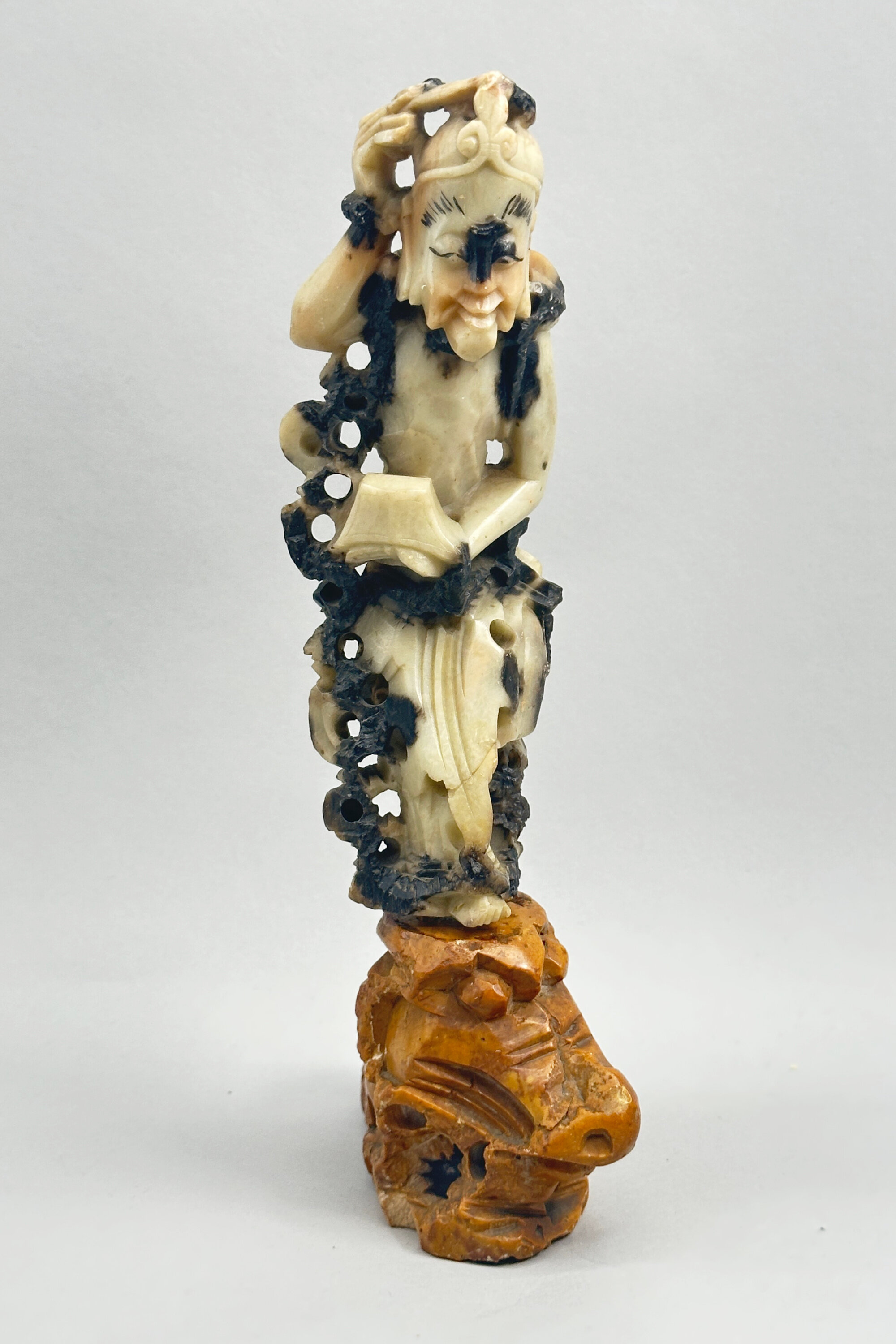
Chinese carving of a Beggar, possibly Shoushan stone, Soapstone stand, C20th
Price: £55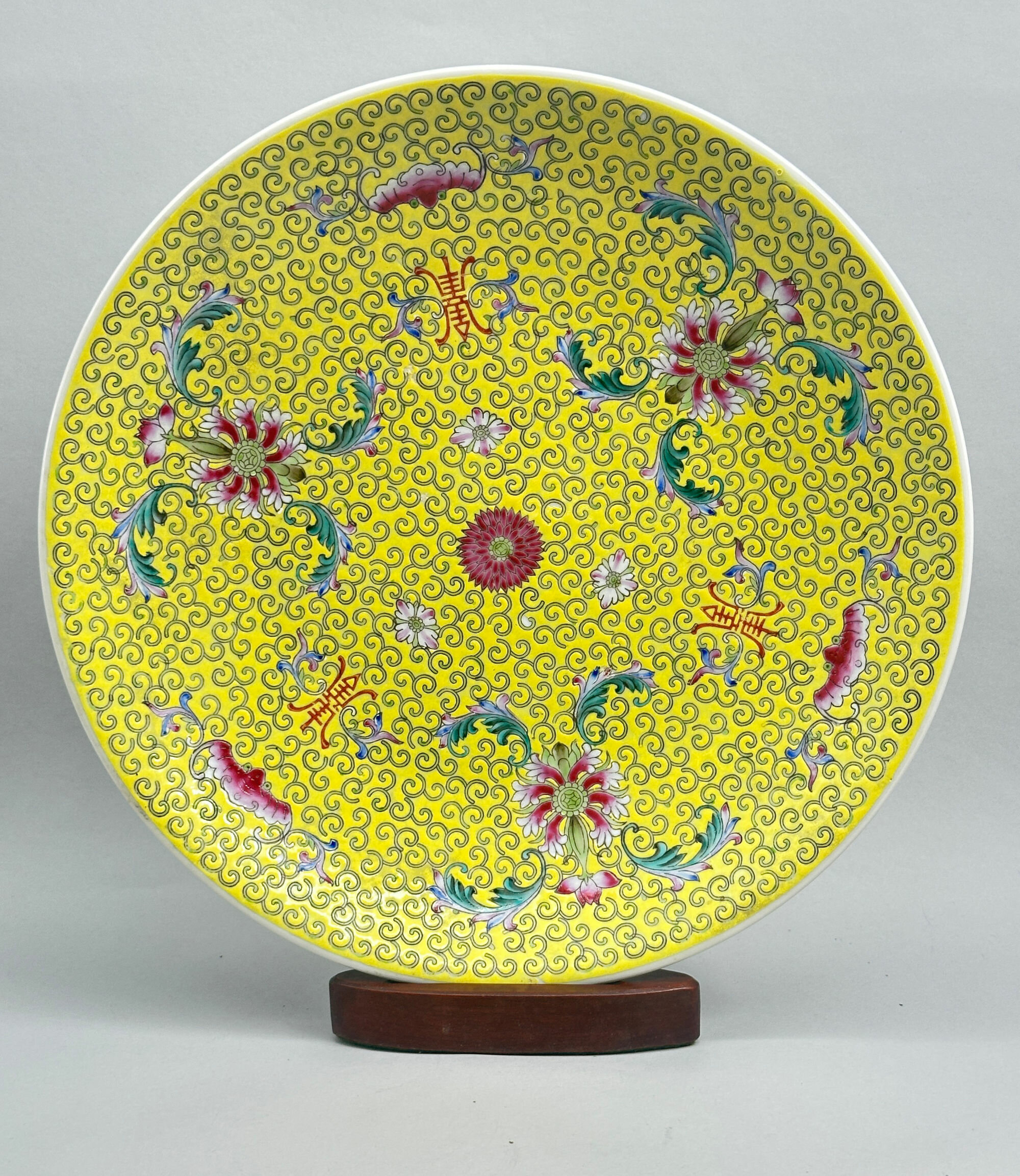
Chinese Yellow Ground Famille Rose Charger, 1950s/early 1960s
Price: £55This is a fine example of the porcelains made at Jingdezhen, for centuries the chief centre of ceramic production in China, in the early years of the People’s Republic of China (1949-). Soon after the communists took control, the kilns at Jingdezhen were organised into co-operatives, each with a number. Many of their pieces were marked and the form of the mark determines the date of production. The circular marks, as here, were the earliest allowing a dating of this charger to the 1950s or possibly the early 1960s. Some of these conglomerates, for the quality can vary, retained the skills of their predecessors and produced works of high quality. This is clearly seen here in the careful and precise enamelling and the general artistry of the design employing ‘imperial’ yellow with the symbolism of happiness (bats), longevity (shou symbols), friendship and a life of ease (chrysanthemum) and fruitfulness and offspring (lotus), all combining to produce a piece well worthy of its many predecessors.
Please note that the wood stand is for display purposes only and is not incuded with this lot.
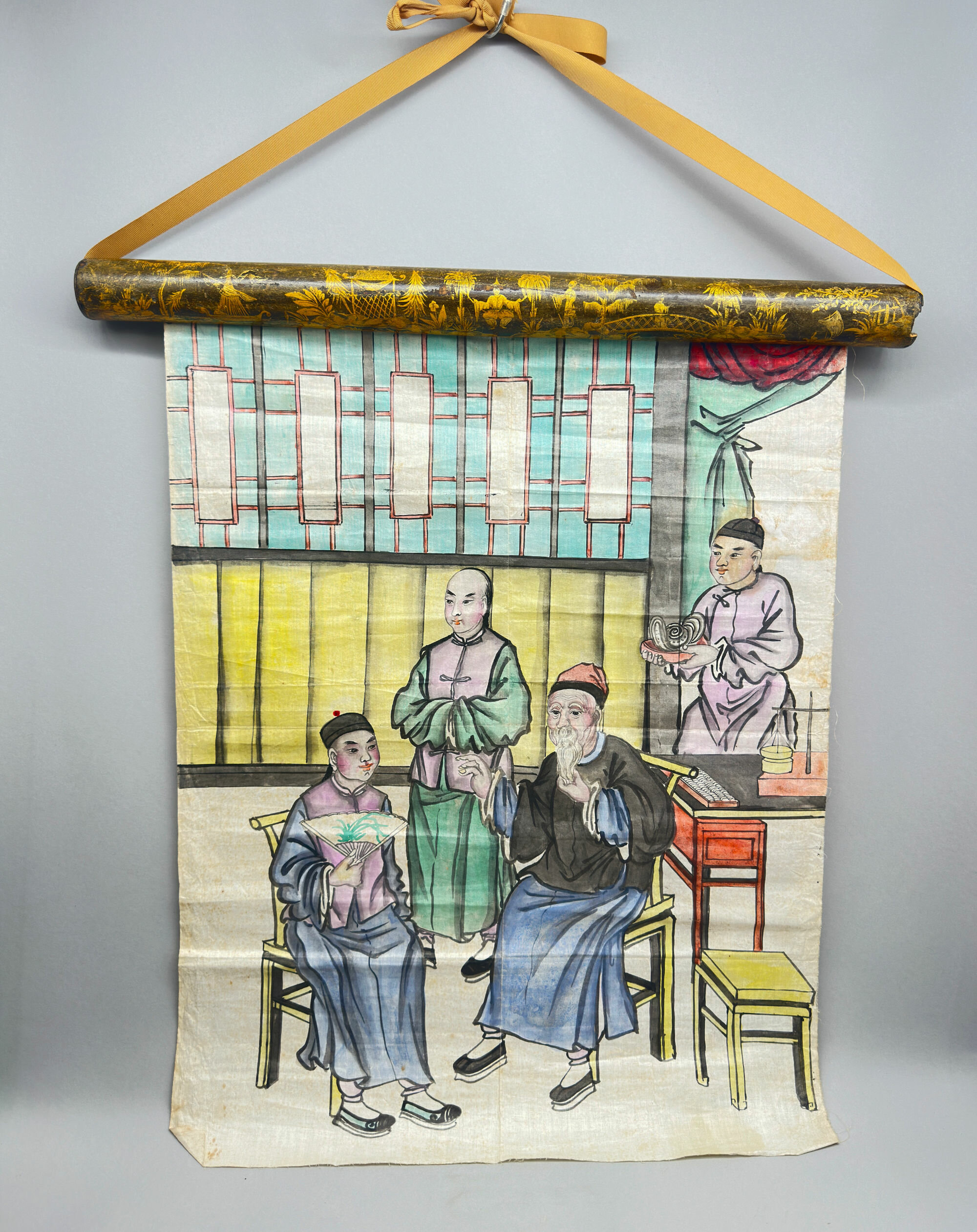
Chinese Scroll Painting of a Merchant and his Client, C20th
Price: £45
Chinese Calligraphy Scroll, Qing Dynasty (1636-1912)
Price: £25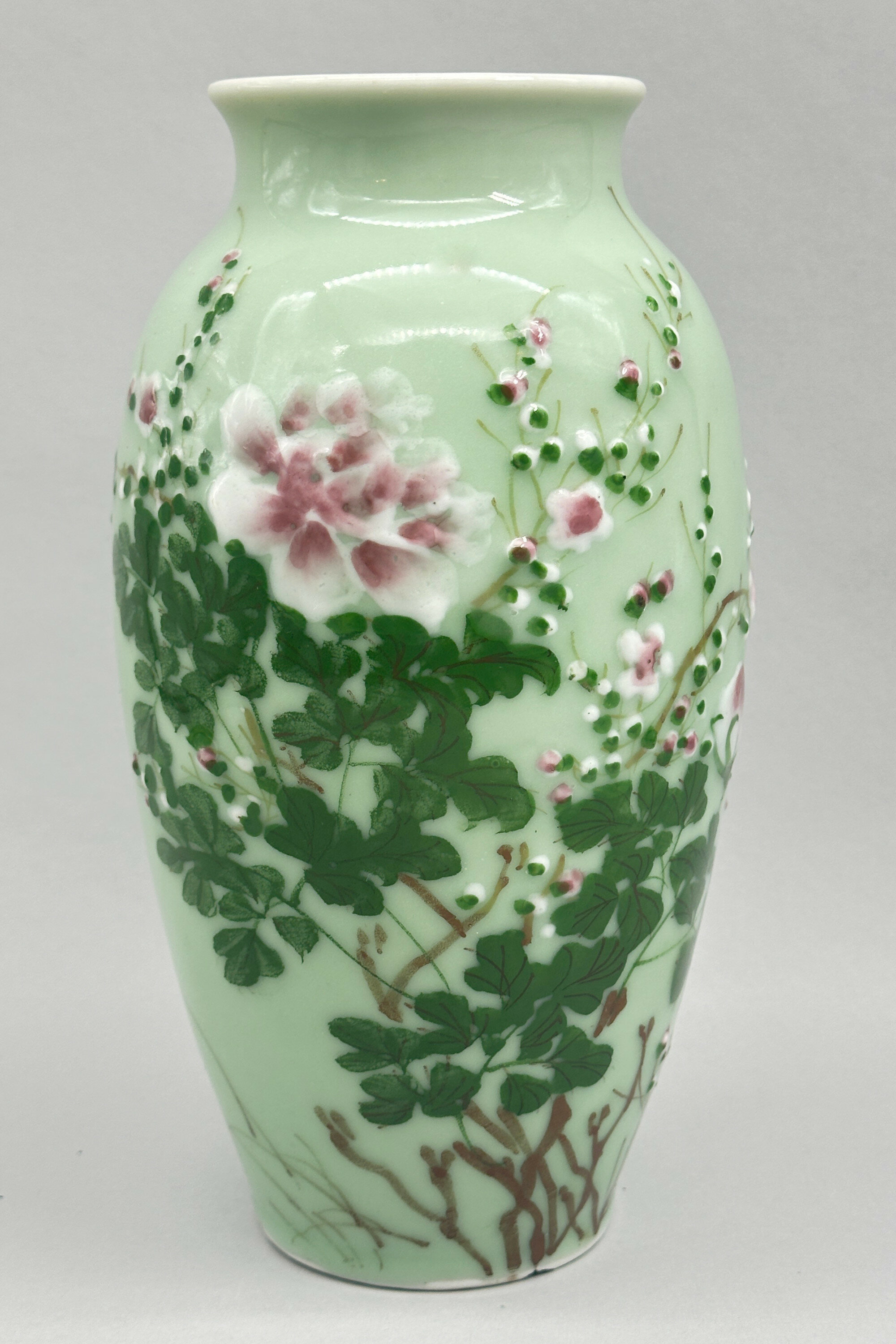
Japanese Celadon glaze vase with enamel decoration, late C19th
Price: £25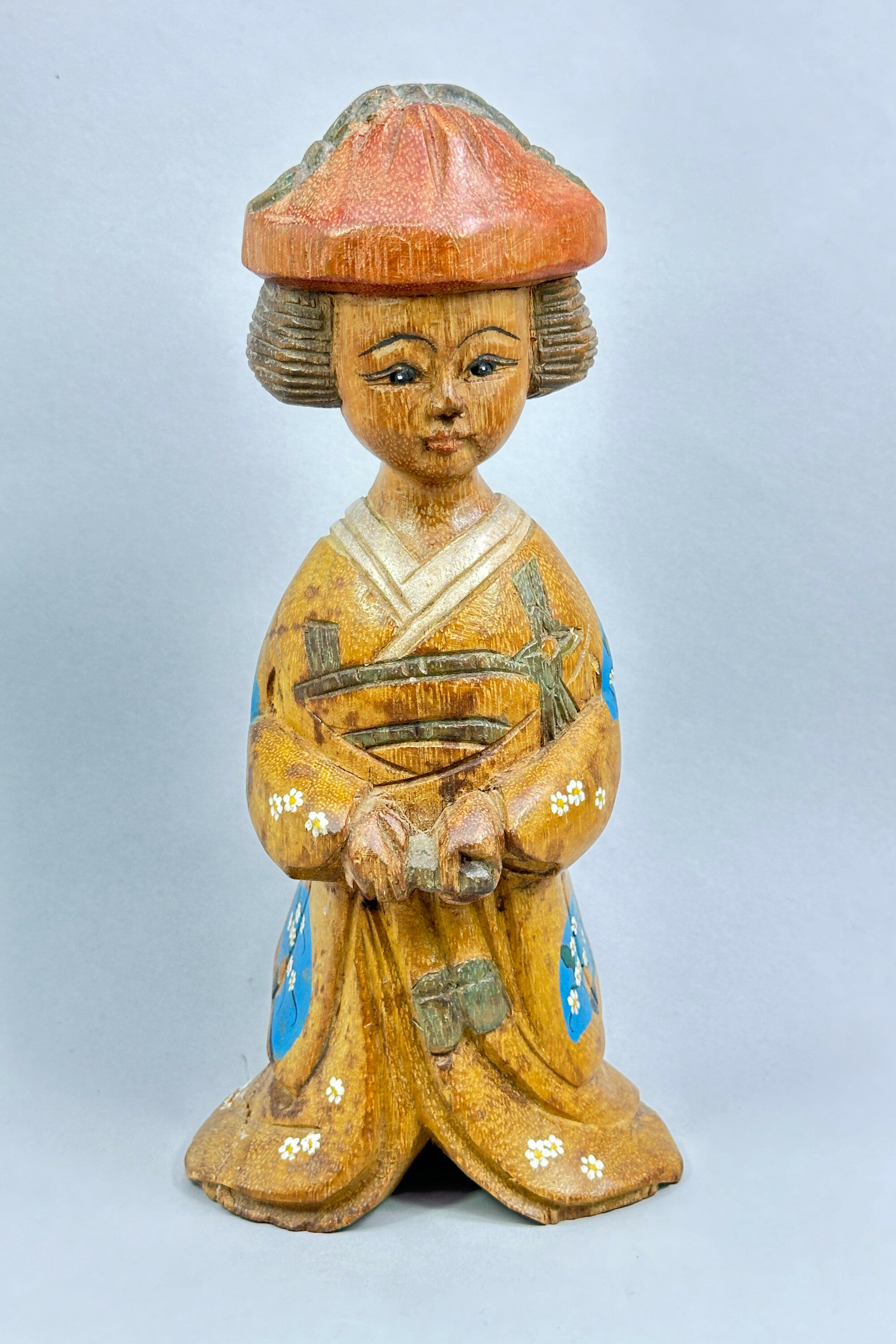
Japanese Carved Wood Figure of a Young girl, Kokeshi doll style, C20th
Price: £45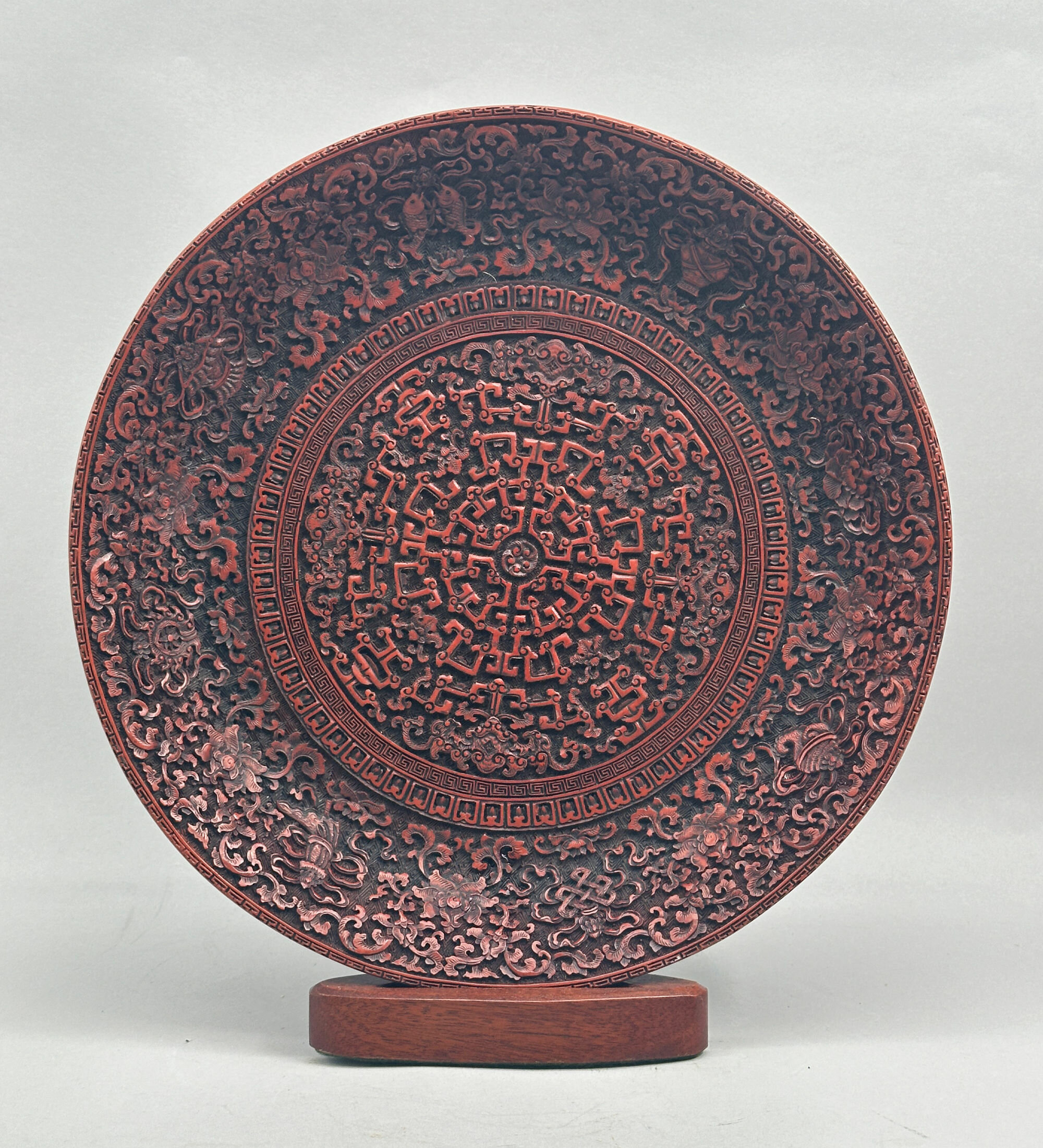
Fine quality reproduction Cinnabar Lacquer Dish with the Eight Treasures, Modern
Price: £180In 1972, the museum commissioned copies of the fifty pieces included in an exhibition of lacquerware held in that year of which this dish was one. These were clearly stamped with the museum’s mark. Examples of these can be found on the market today but, by repute, forgers took moulds from these reproductions and then produced copies of their own without the museum mark. Various examples of the ones created from the museum copy of this dish can also be found on the market today, sometimes at quite high prices. Usually these include the Qianlong mark found on the original which this piece does not. It is also of extremely high quality and it is hard to see that it was created from a mould of a mould copy. Its exact history is therefore uncertain, but if appreciated in itself it is a highly attractive decorative object, in a sense of 'museum quality’. And obtainable at a fraction of the price its original would cost!
Images 13 and 14 show the front and back of the museum exhibit allowing comparisons to be made.
Please note that the wood stand is for display purposes and is included with this lot.
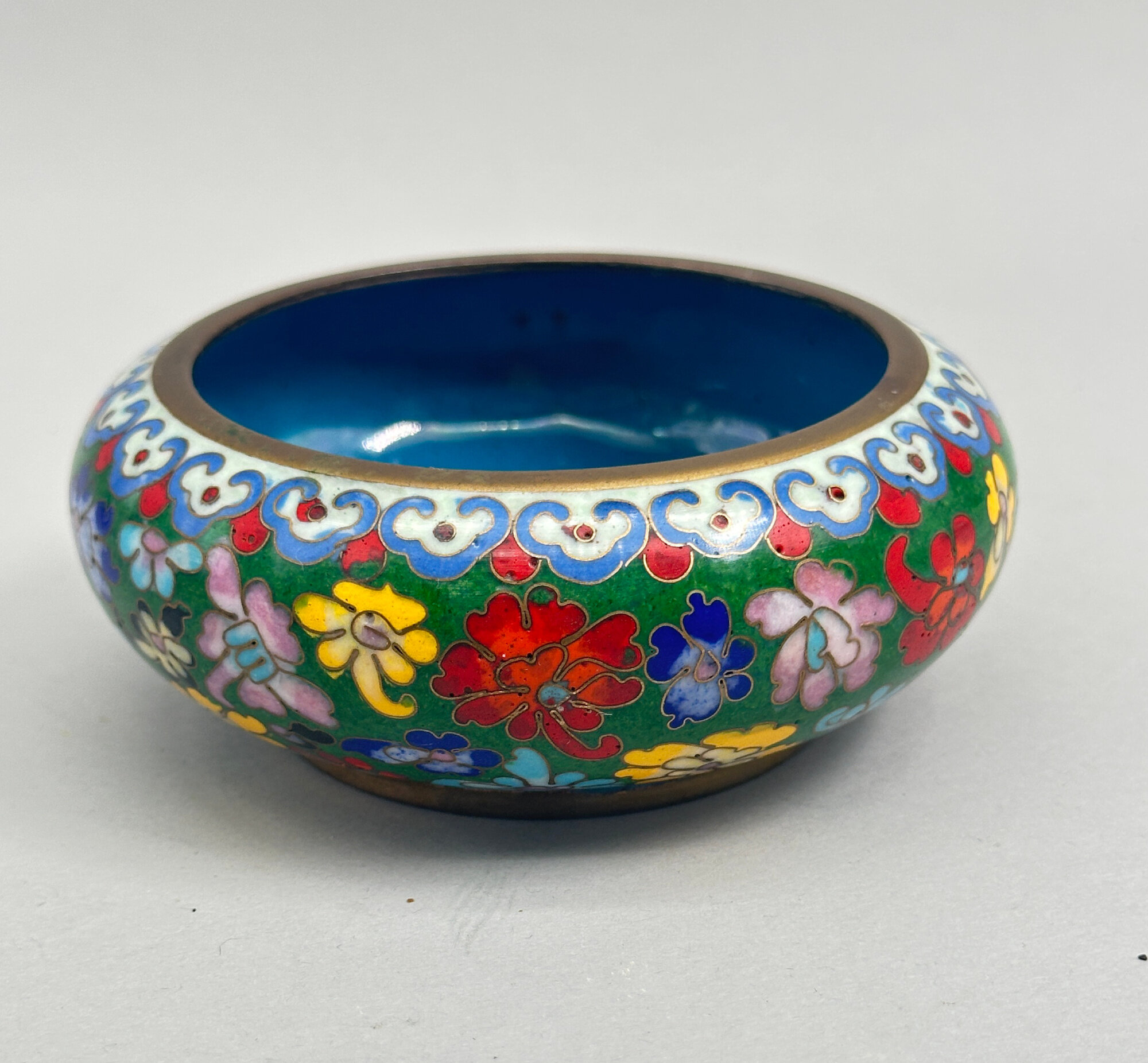
Chinese Cloisonne Shallow Bowl, C19th
Price: £45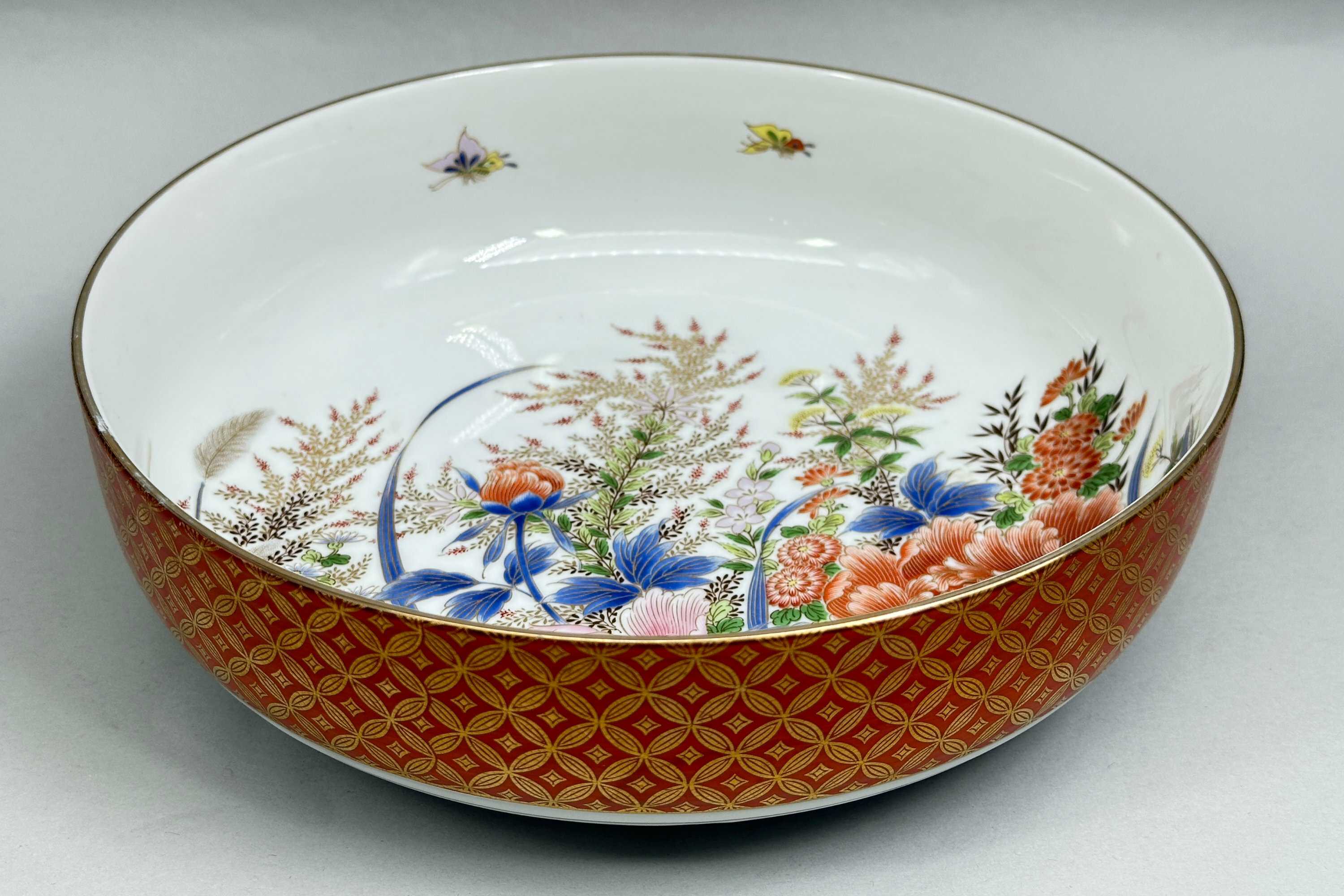
Japanese Polychrome Bowl, Shibata Toki ware, late c20th
Price: £45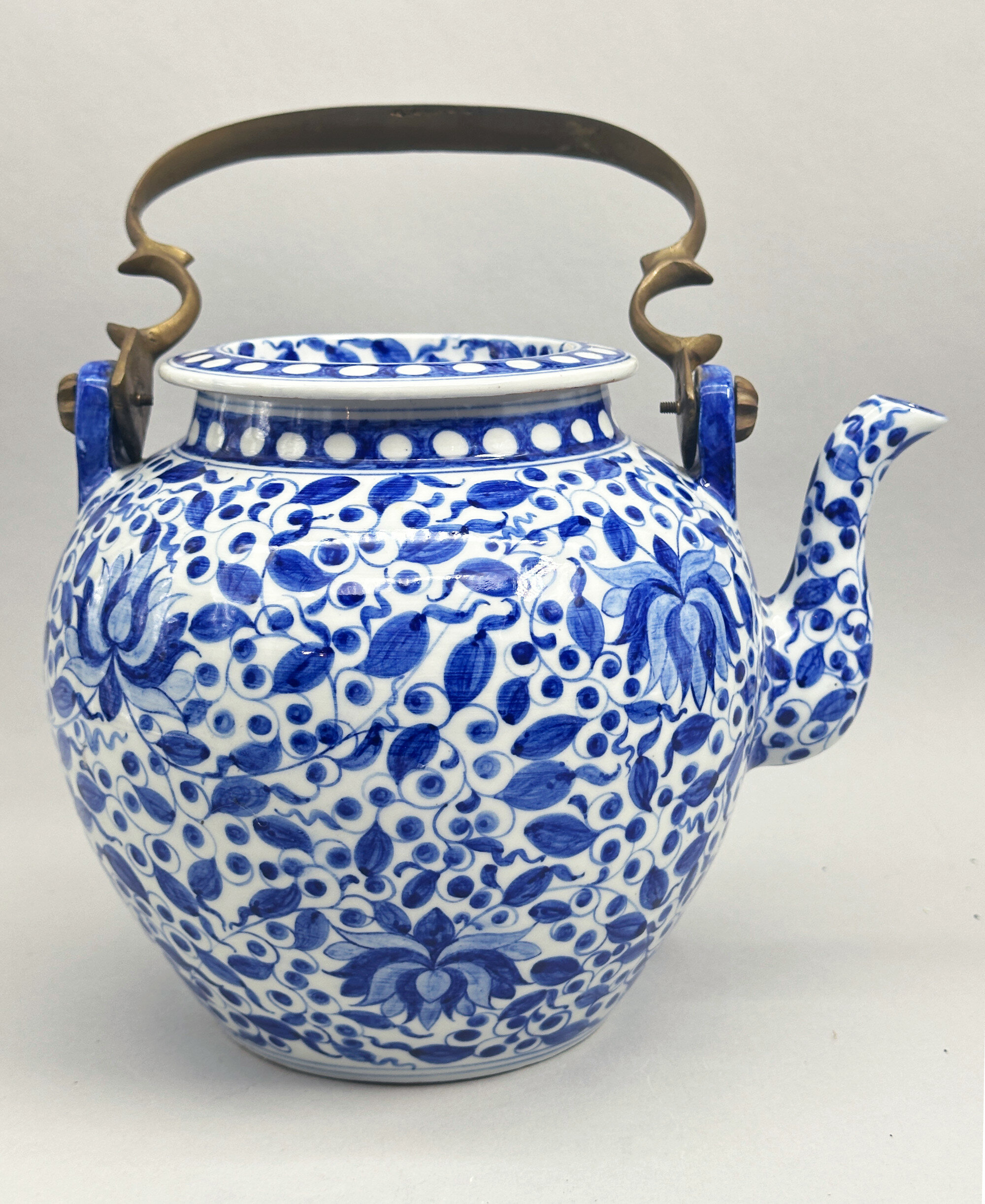
Exceptionally large Chinese Blue and White Teapot with metal handle, C19th
Price: £350The form here, without a ceramic handle but with an attached carrying handle, suggests a travelling teapot, a well known variation of the teapot type produced in China but rarely found on such an epic scale. Presumably this piece was intended for use at a rather large gathering or banquet so that a multitude of guests could be served at once! The paste of the footrim, style of decoration and clearly visible hand thrown potting rings (see images 8 and 9) all point to late nineteenth century work which is confirmed by the minute vertical lines seen on the exterior which are often found on blue and white pieces from that period. It is sometimes suggested that these brass handles, for similar examples can be found, were made in Thailand but there is little evidence for this. However, a local audience rather than an international one seems more than likely since there would have been little call for such a serving item in Western homes.
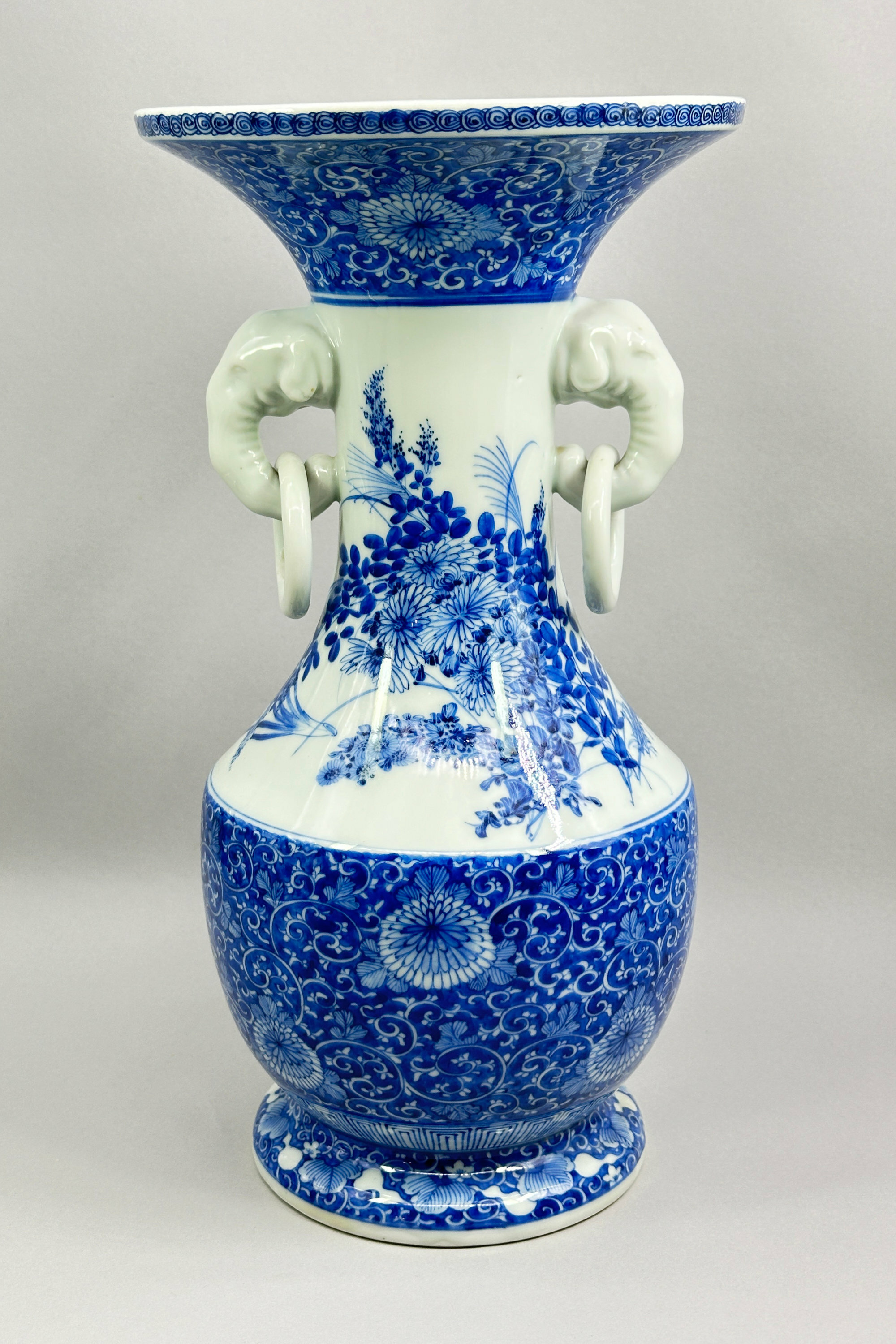
Japanese Seto Ware Blue and White Vase, late C19th
Price: £450A fine quality Japanese porcelain vase, the ovoid body with a curved flaring foot and rising to a tall concave neck with a well defined shoulder, applied elephant and ring handles to the sides and a galleried rim, decorated in bright underglaze blue with two bands of stylised flowering chrysanthemum at the top and bottom between a continuous scene of flowering peony and chrysanthemum, the top rim with repeating whorl design on the exterior and stylised leaf design inside, the stepped base glazed white.
The kilns at Seto in the Aichi prefecture of Japan and situated close to Nagoya form one of the traditional ‘Nihon Rokkoyo’, the six old kilns of medieval Japan. The location of Seto was ideal for the production of ceramics with an abundance nearby of both porcelain clay and forests to provide firewood for the kilns. Production began as early as the Heian period (794-1185) and continued without a break thereafter, the earlier pieces being more pottery forms copying Chinese wares. It was in the early nineteenth century that the kilns turned to producing porcelains decorated in underglaze blue and white, a development initiated by the potter Tamikichi Kato who went to Arita to learn the techniques of its production there, returning to Seto in 1807. Production grew and developed and was directed towards the export market in the Meiji period (1868-1912) with Seto wares being displayed at the European and North American exhibitions and fairs. Their delicately painted designs of birds and flowers proved to be immensely popular and were, in their time, to influence Art Nouveau and Art Deco designs. Some of the forms produced were truly virtuoso creations including, besides vases, screens, jardinieres and even ceramic tables.
Signed pieces are known and besides Tamikichi Kato the distinguished potters included the Kichiemon brothers, Kato Chuji and Kawamoto Jihyoe, and Kawamoto Hansuke. But not all the best pieces carried an artist’s signature as this vase well demonstrates. Formed from fine quality clay, as can be seen from the foot rim (image 10), the complex shape with its spreading base, angled shoulder and galleried rim would have been difficult to create. The handles show remarkable skill with the rings somehow formed so as to hang loose (presumably some form of kiln waster technique was used). The detail and artistry of the painting speaks for itself. Note in particular the shading effects on the peony flowers. While not perhaps an exhibition piece, this vase is definitely of exhibition quality and would be a worthy addition to a collection of nineteenth century Japanese ceramic art.
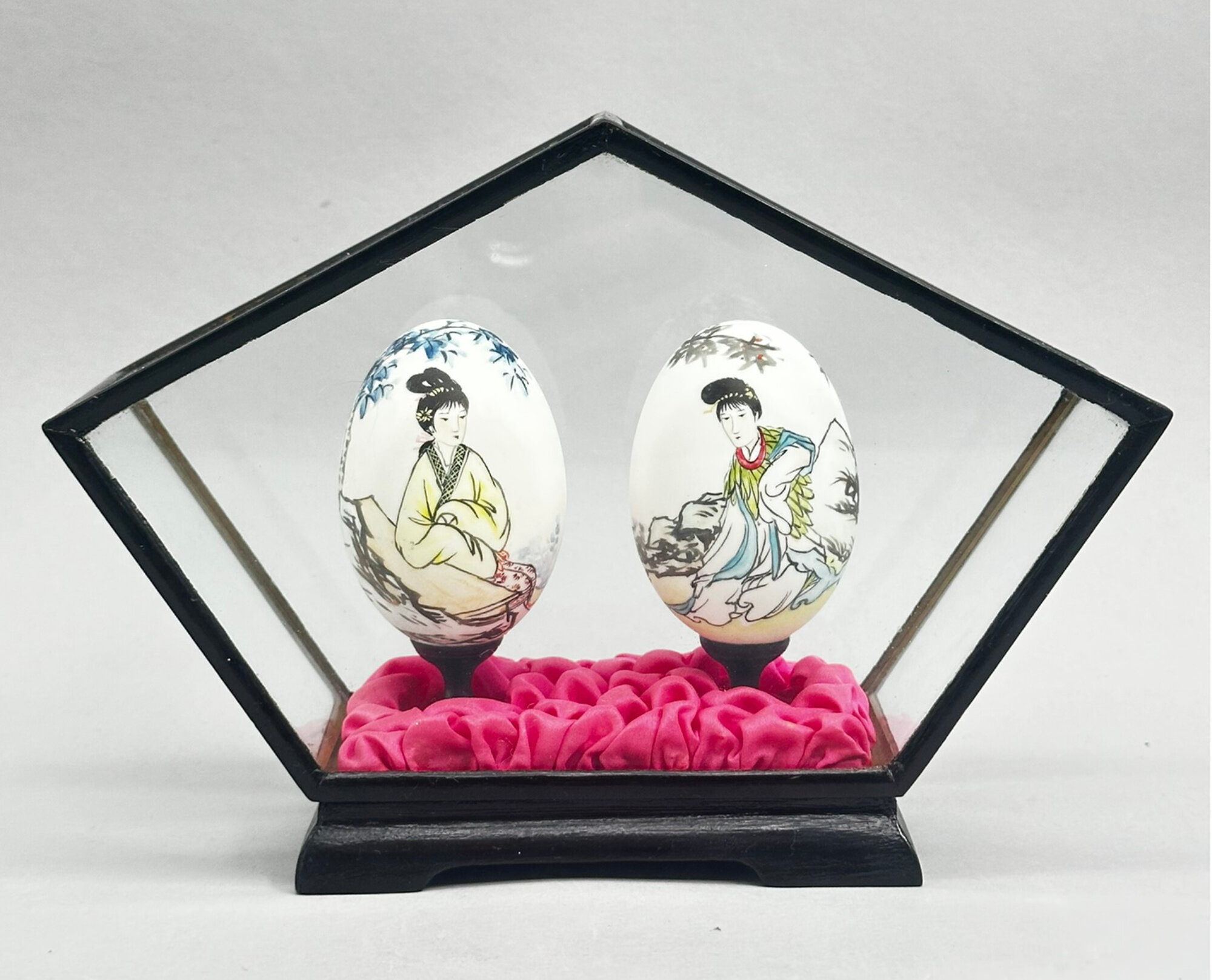
Pair of Chinese Hand Painted Eggs in Case, 1970s
Price: £25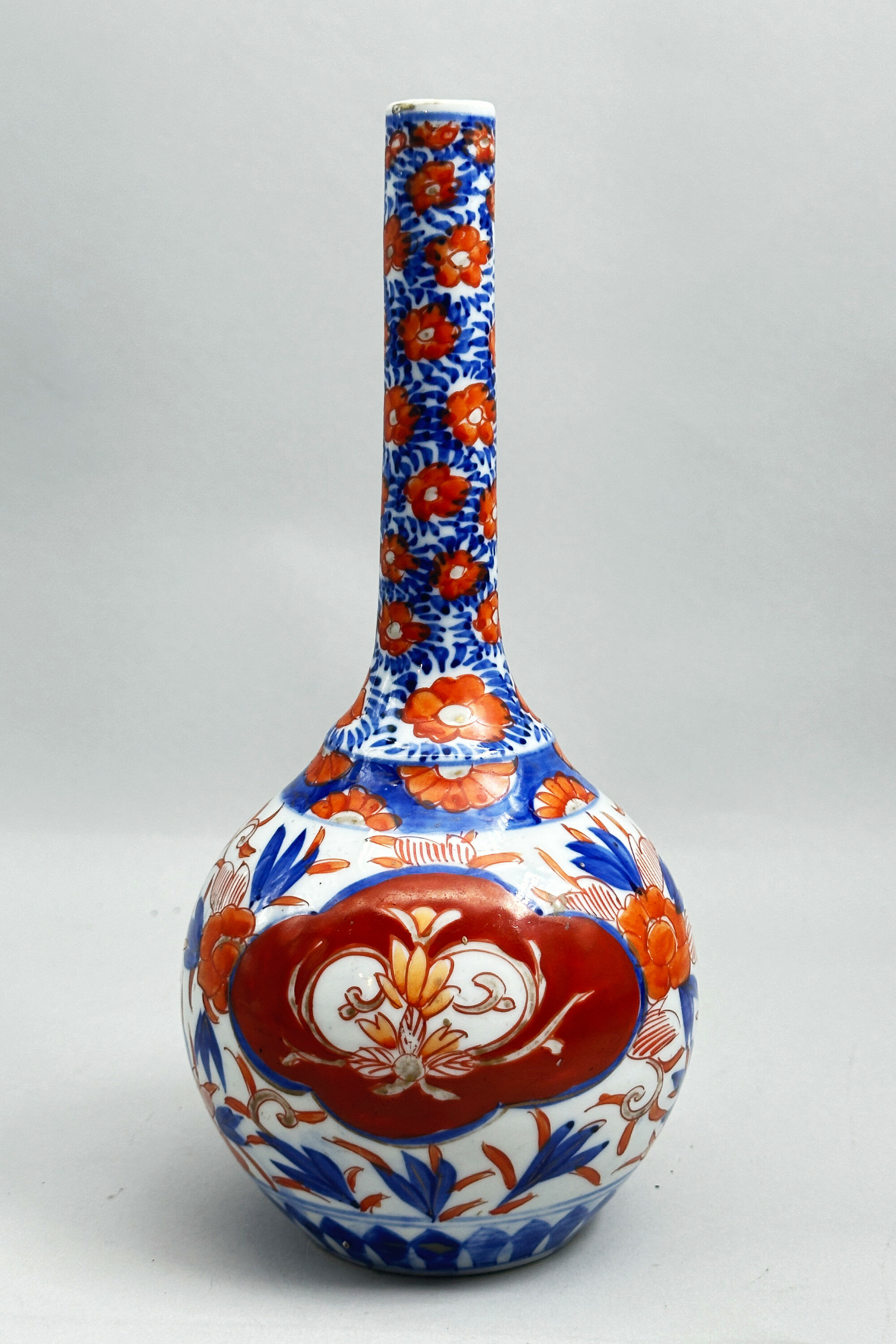
Japanese Imari Bottle Vase, circa 1900
Price: £30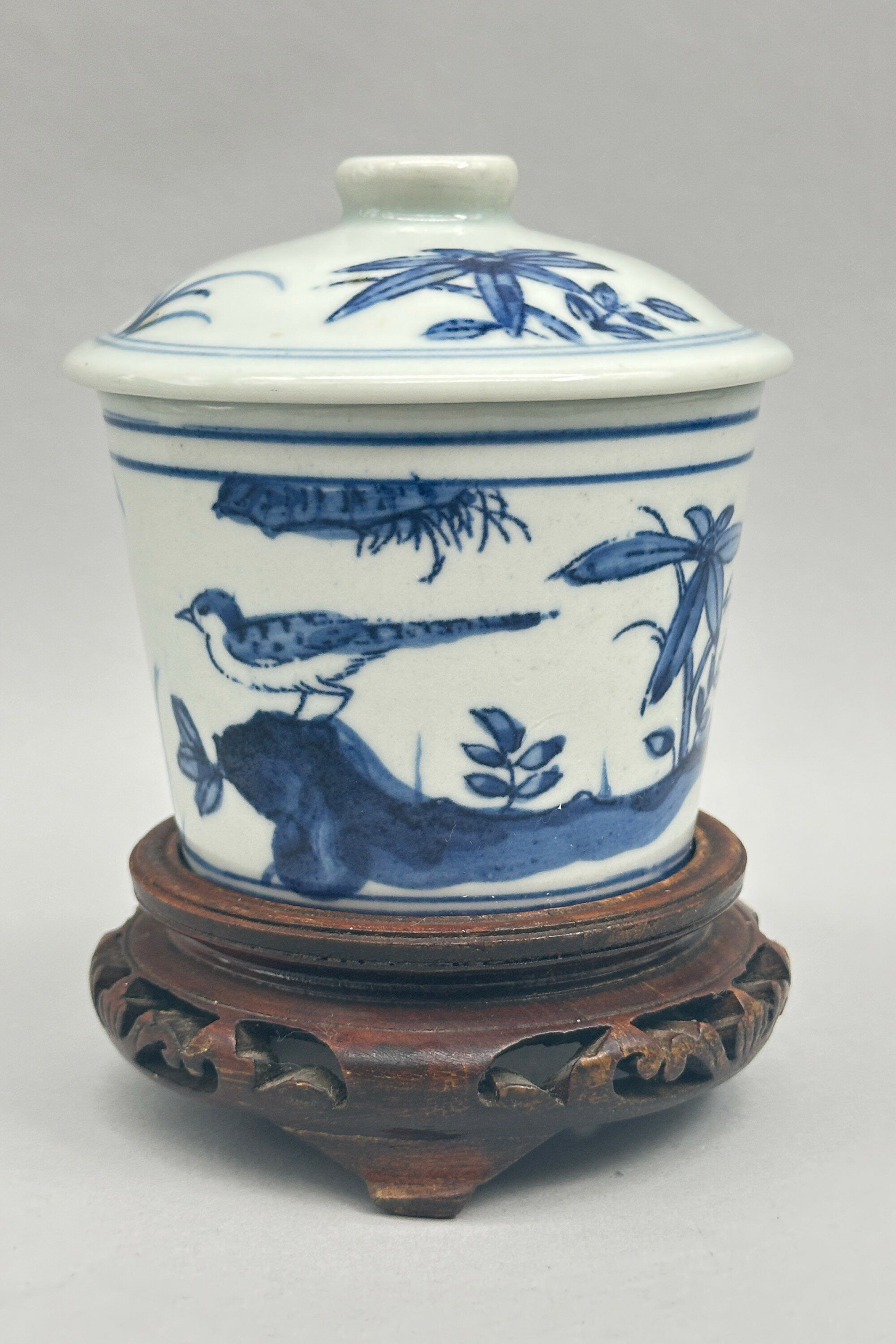
Chinese Small Blue and White Potiche and Cover with wood stand, late C20th
Price: £45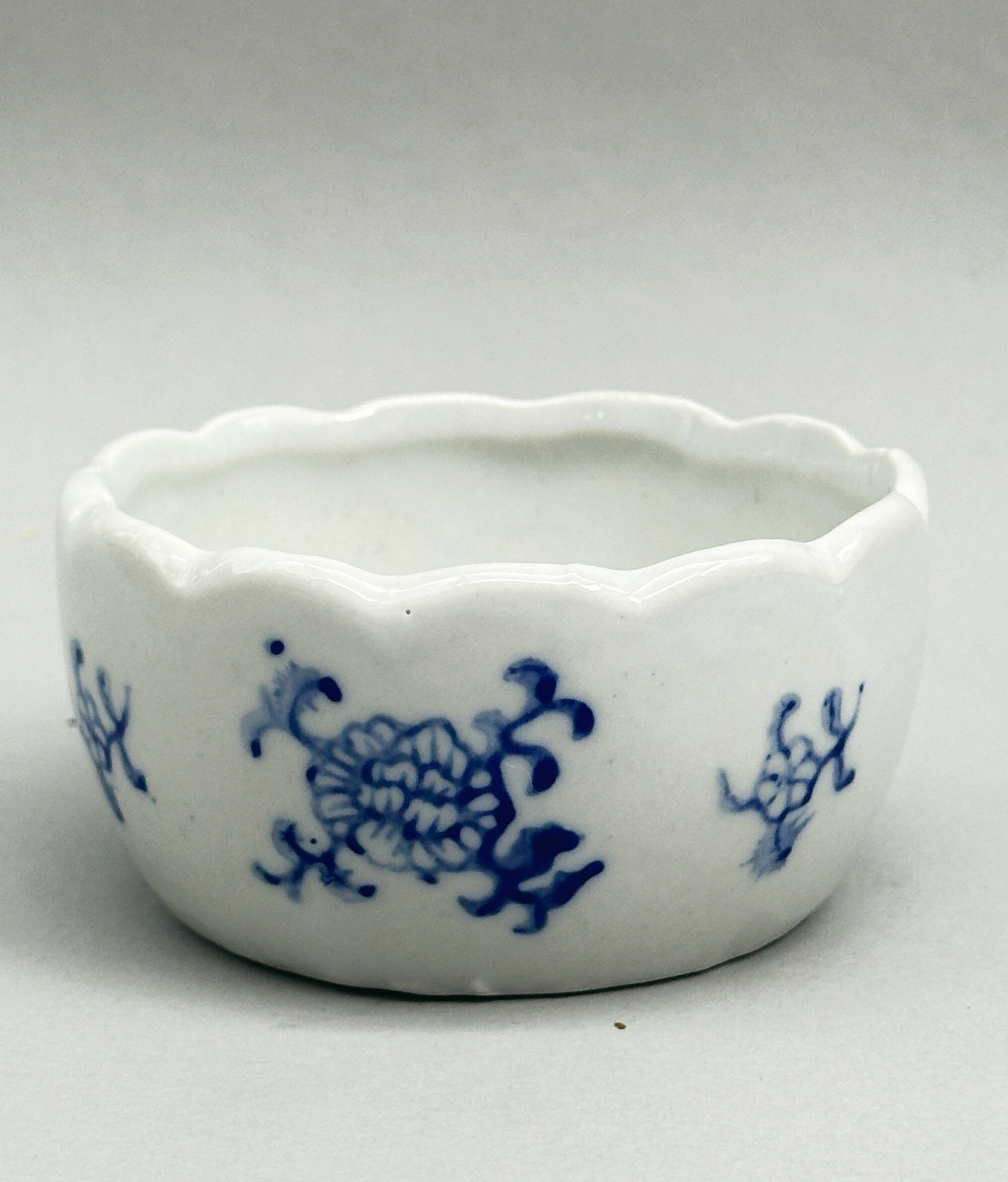
Japanese Arita Brushwasher, C20th
Price: £25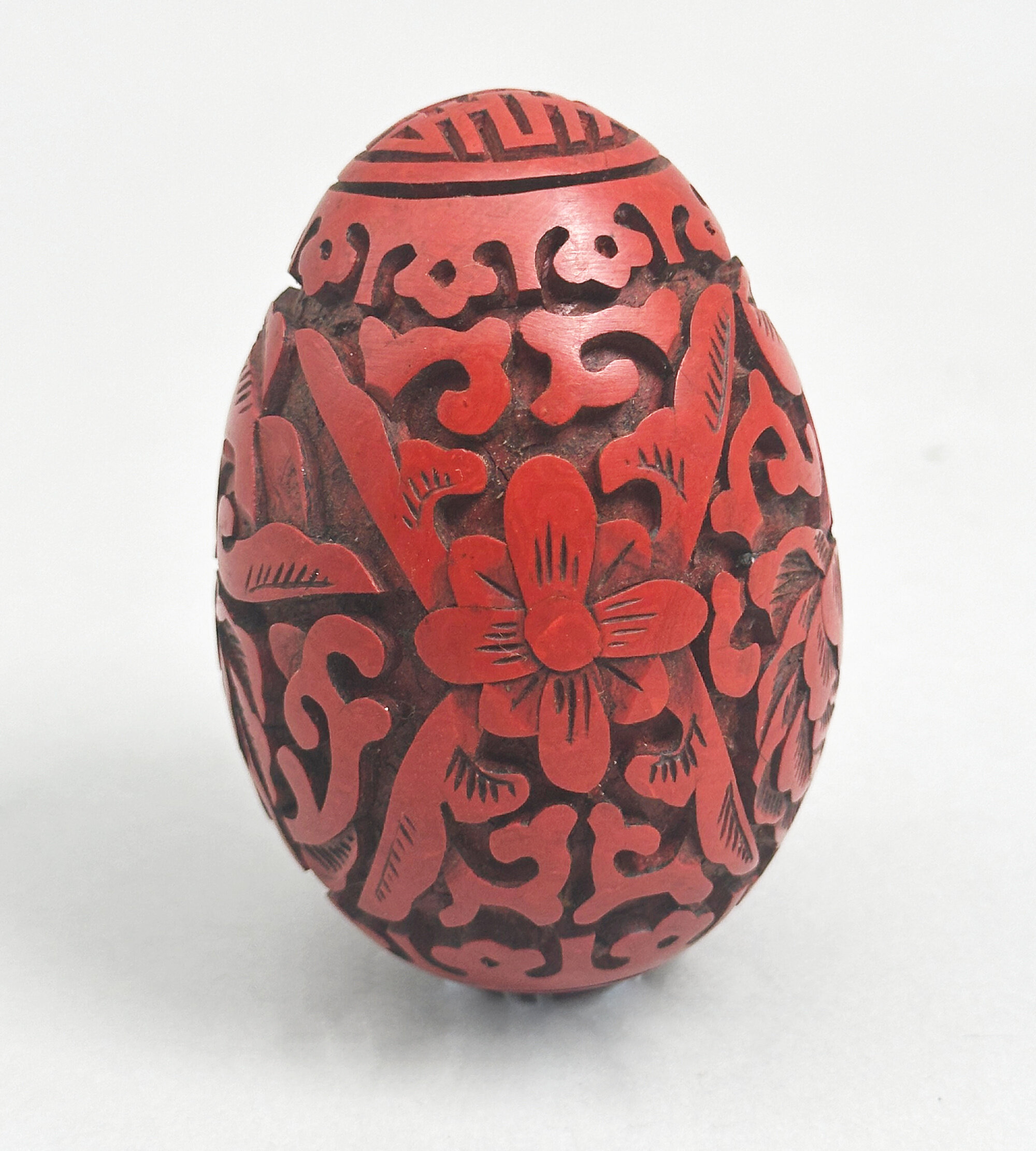
Chinese Cinnabar Lacquer Egg, C20th
Price: £55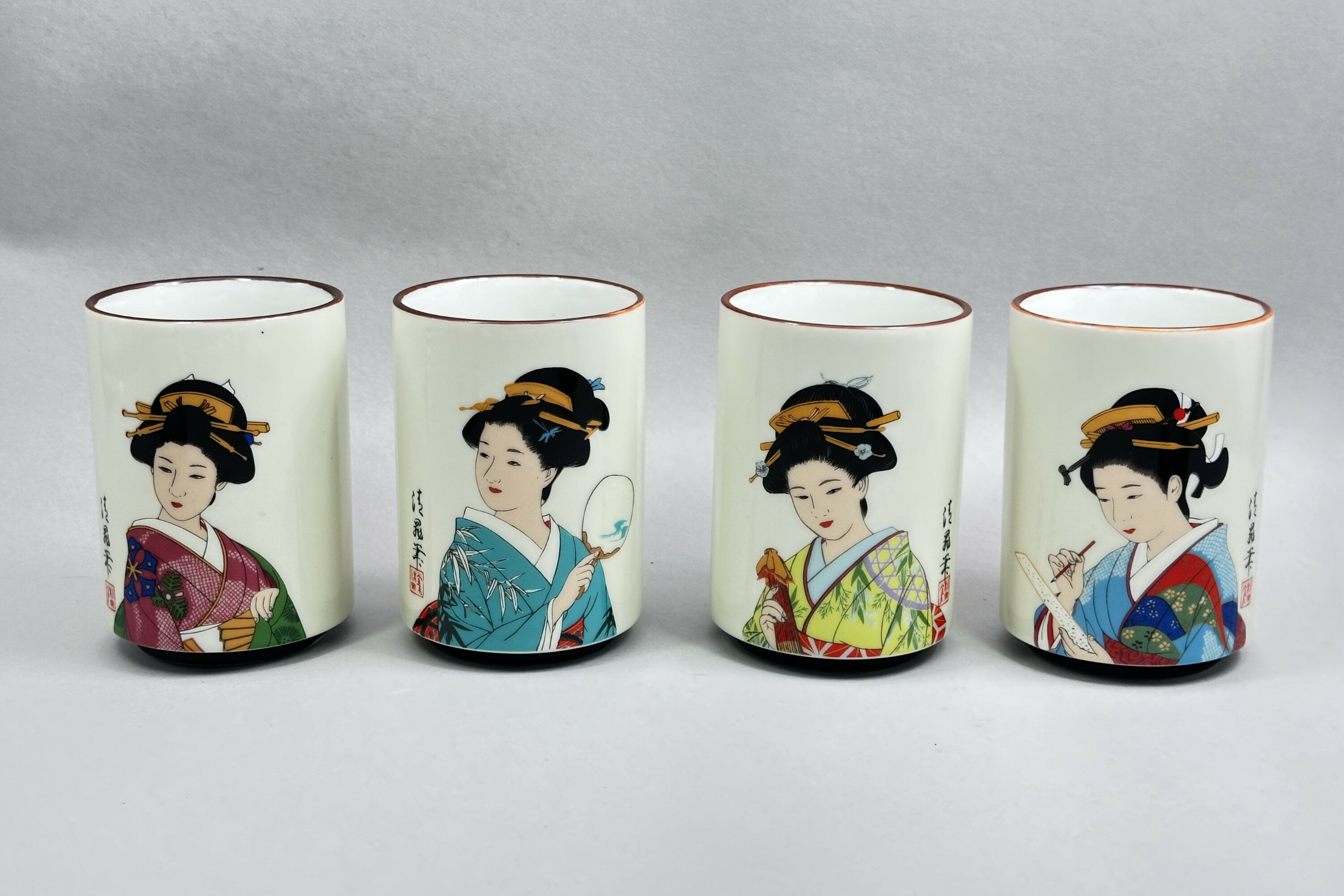
Set of Four Japanese Ceramic Beakers decorated Geisha, late C20th
Price: £40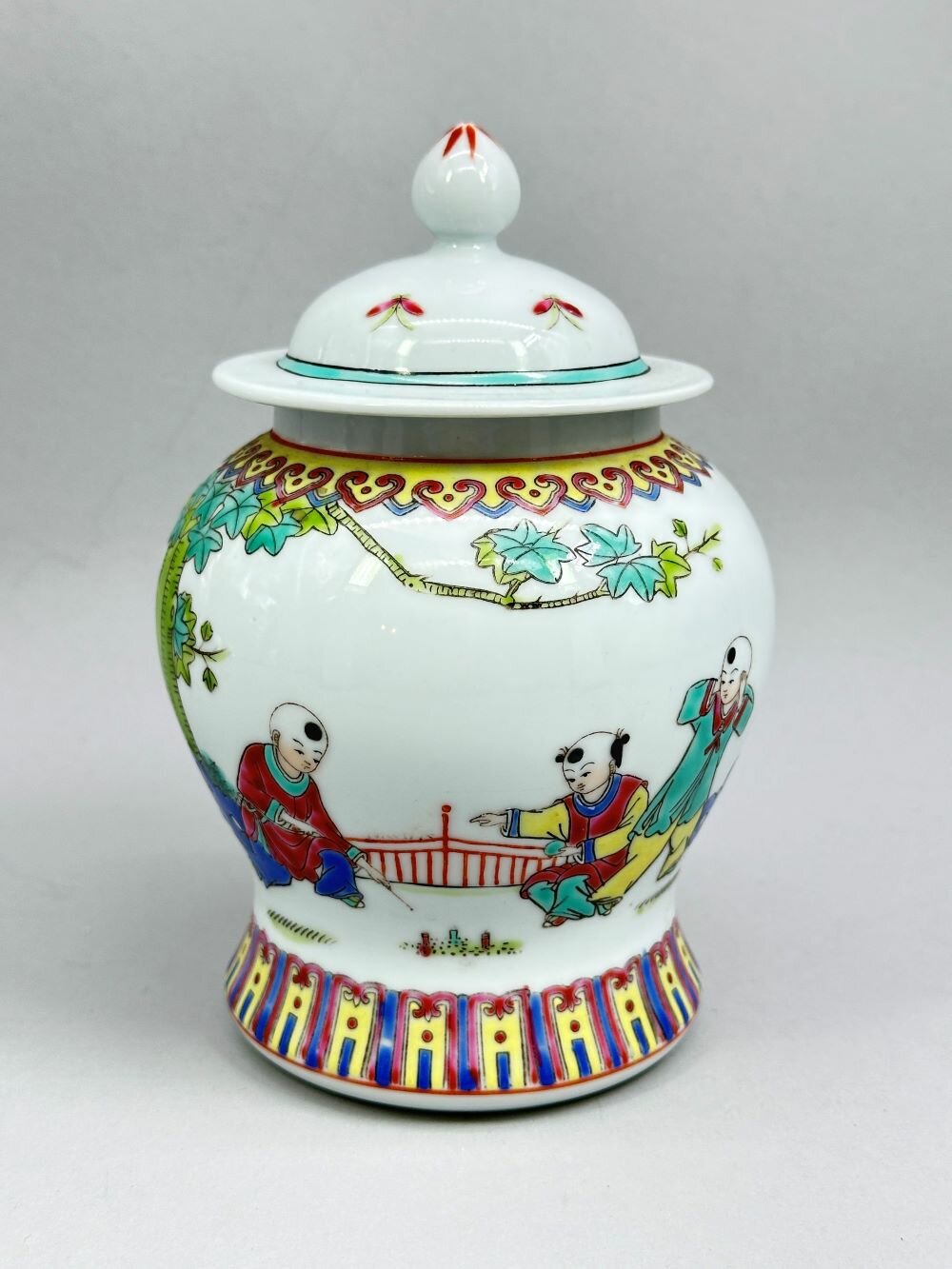
Chinese Republican Style Famille Rose small Baluster Jar and Cover, late c20th
Price: £20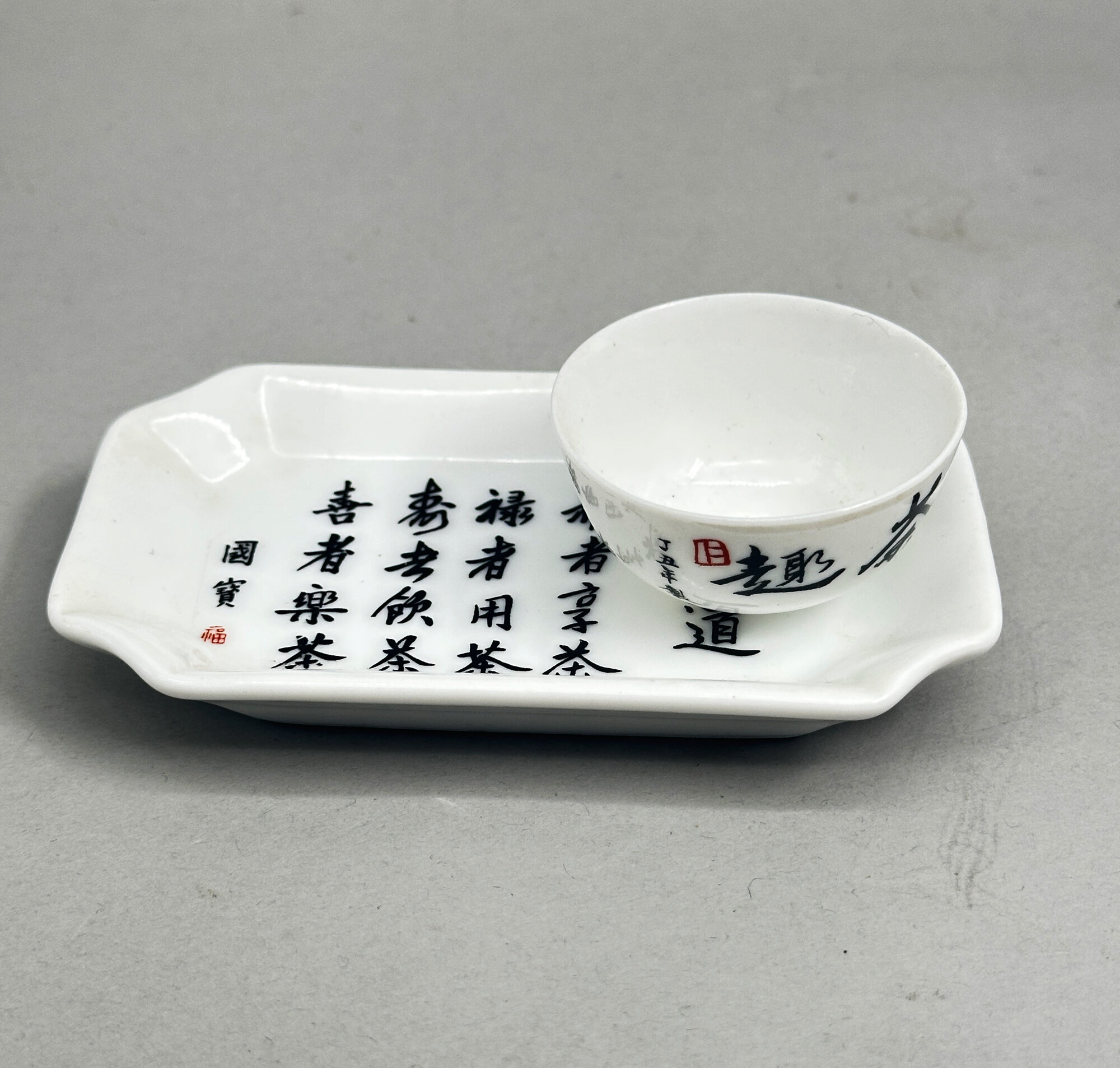
Chinese Porcelain Teabowl and Spoon Tray with calligraphy insciptions, 1997
Price: £15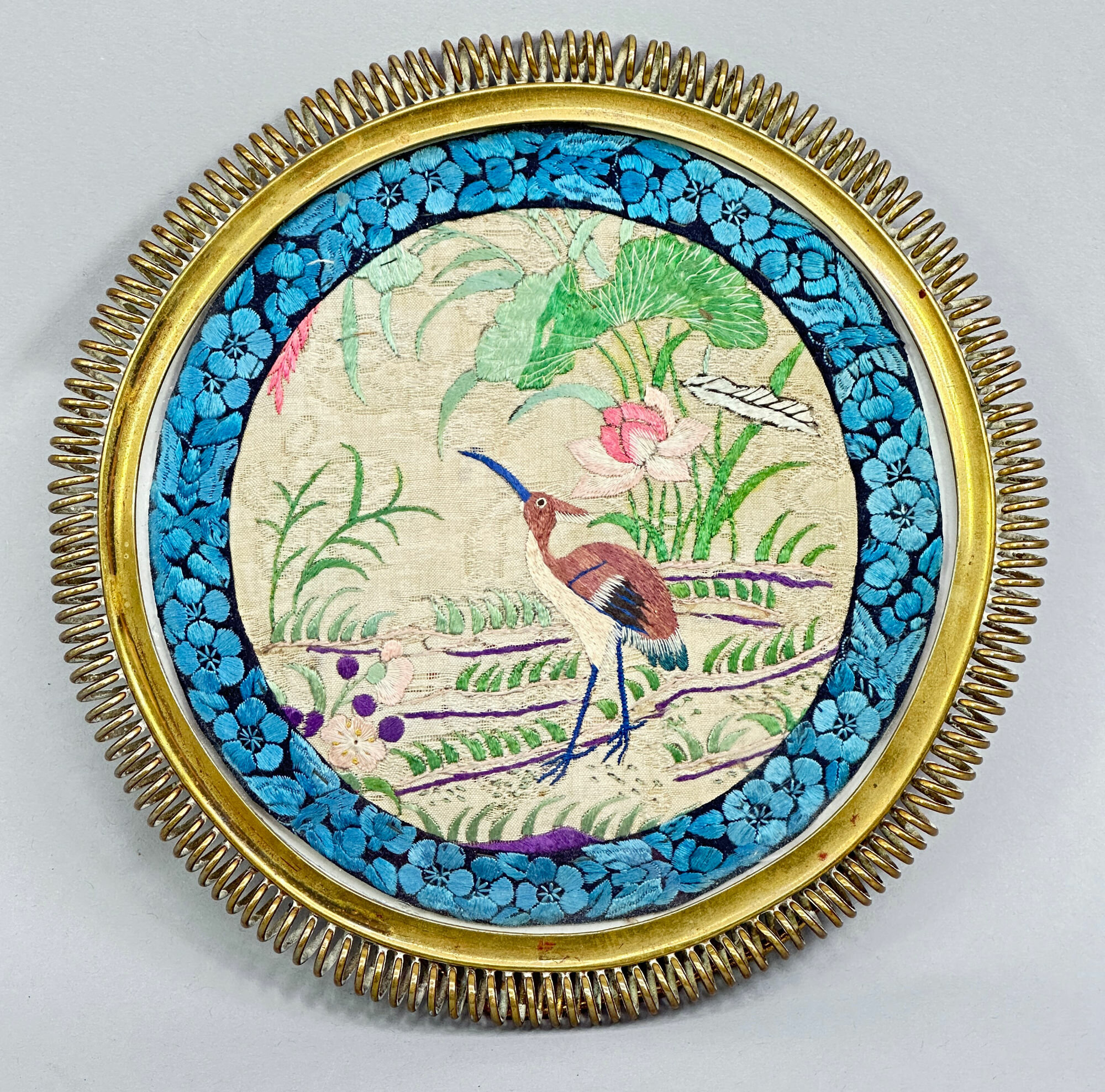
Chinese circular silk textile Panel in later European brass metal Frame, C19th/C20th
Price: £55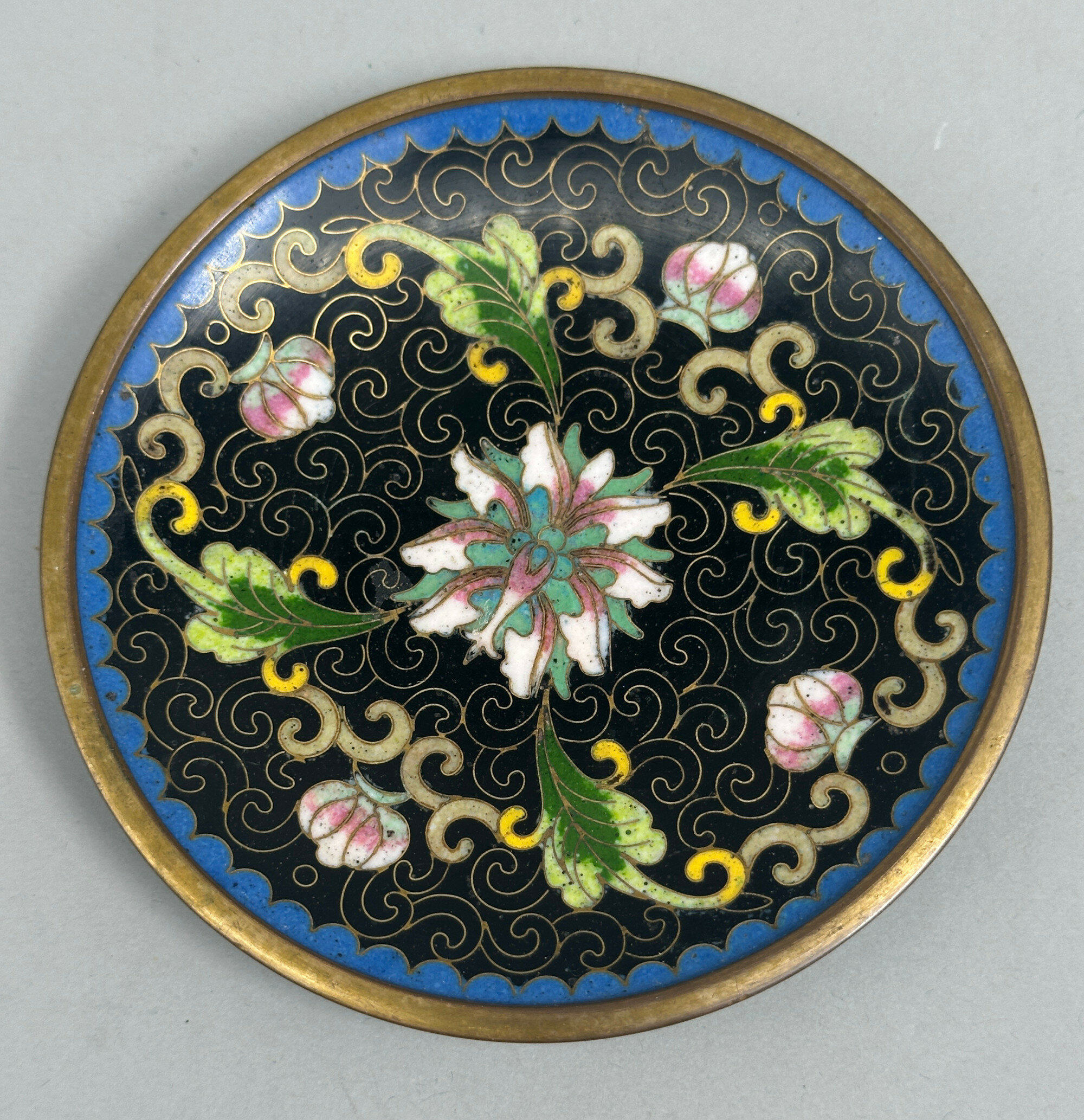
Small Chinese Cloisonné Dish decorated lotus, C20th
Price: £25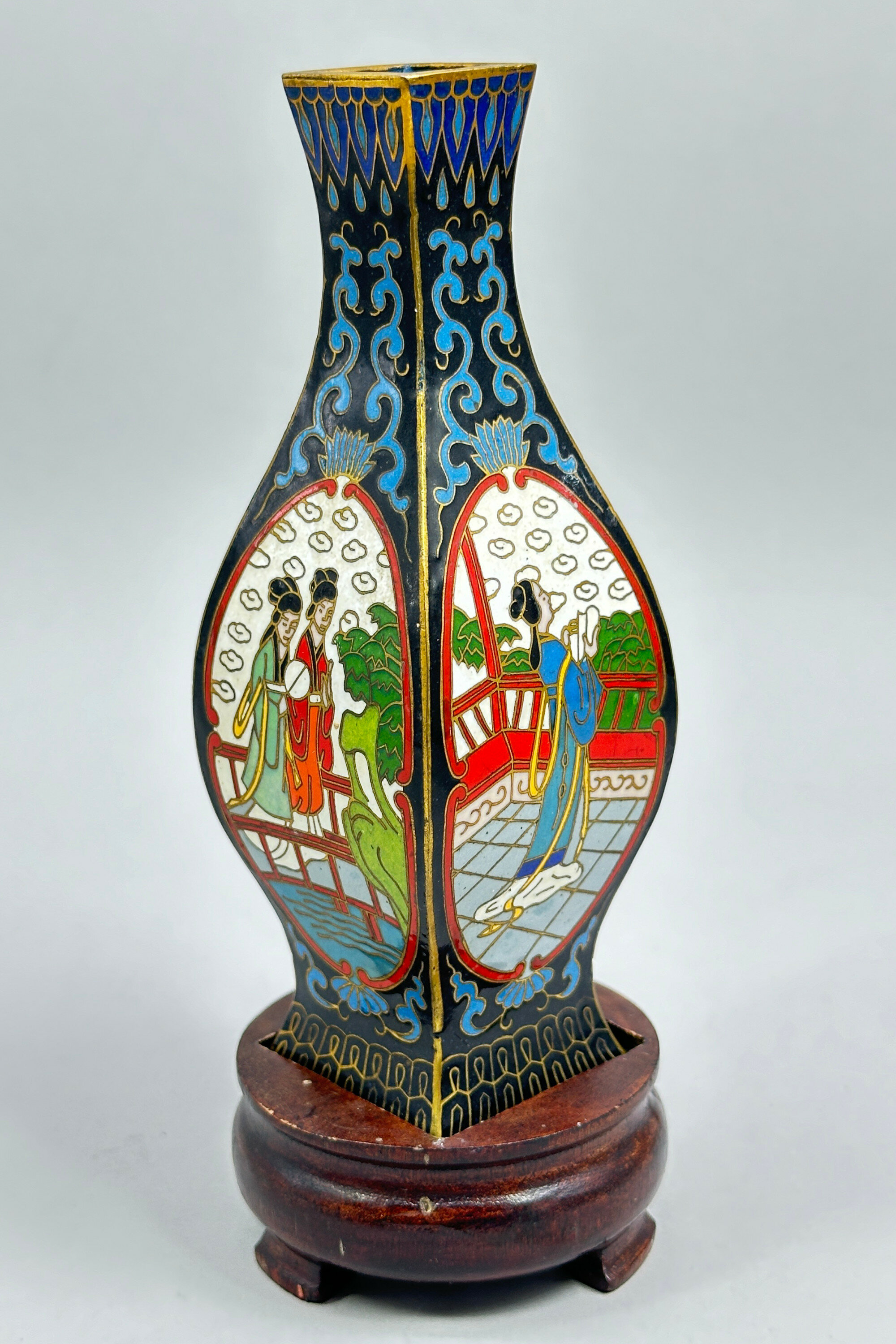
Chinese Cloisonné Square Vase on Stand, C20th
Price: £25The cloisonné technique, in which glass derived enamels were set in wire outlines (the so called ‘cloisons’ from the French word), was developed in China in the early Ming dynasty (1368-1644) and then used throughout, right up until the C20th, indeed pieces are still produced today. The style of enamelling here with fairly bold outlines to the decoration and the use of bright enamel colours suggests a dating here to the mid twentieth century which corresponds to the probable date of the accompanying wood stand. Perhaps intended as a desk ornament or possibly a flower vase, this piece could certainly find a home in a contemporary setting.
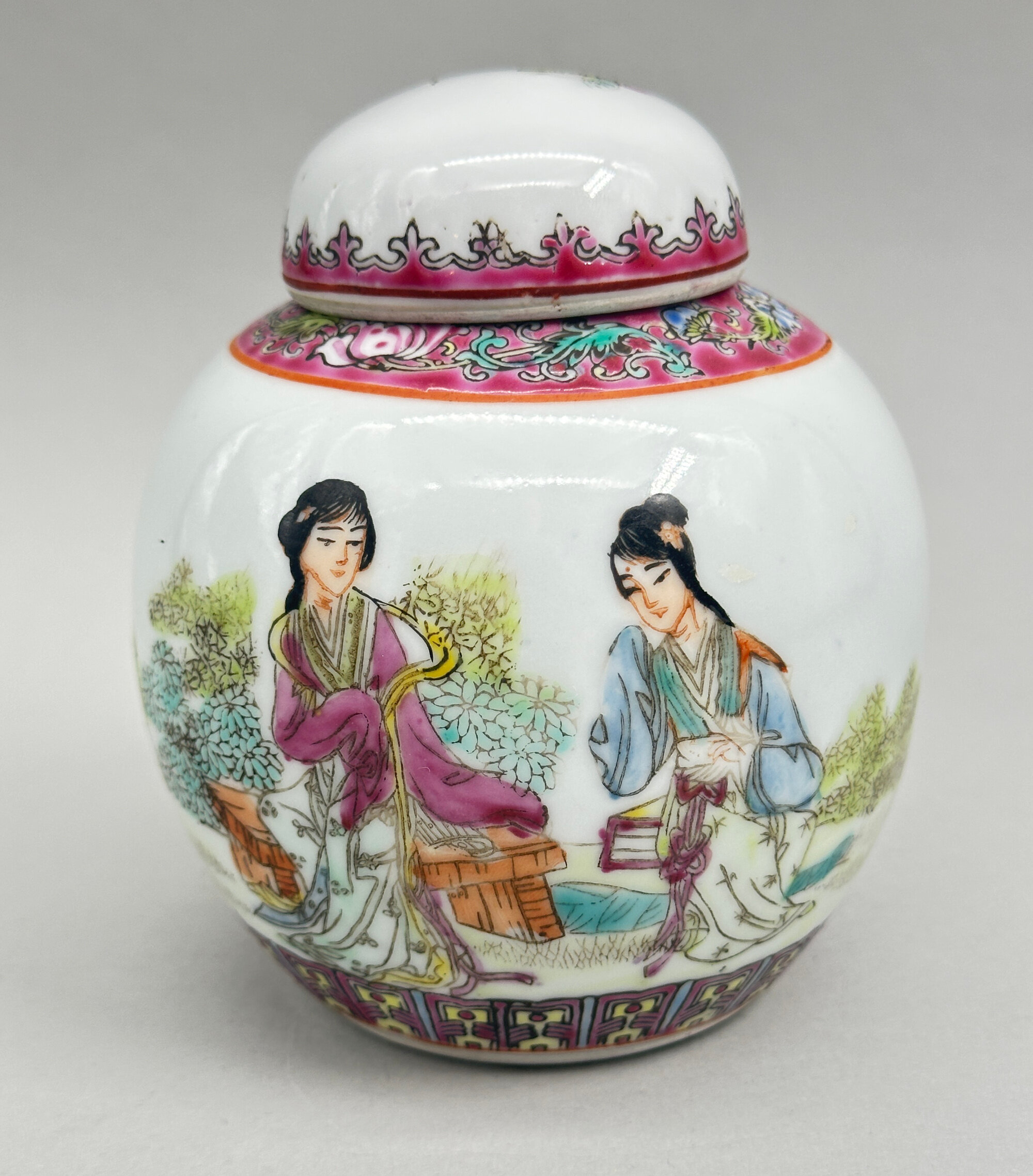
Chinese Republican Style small Famille Rose Ginger Jar and Cover, late c20th
Price: £20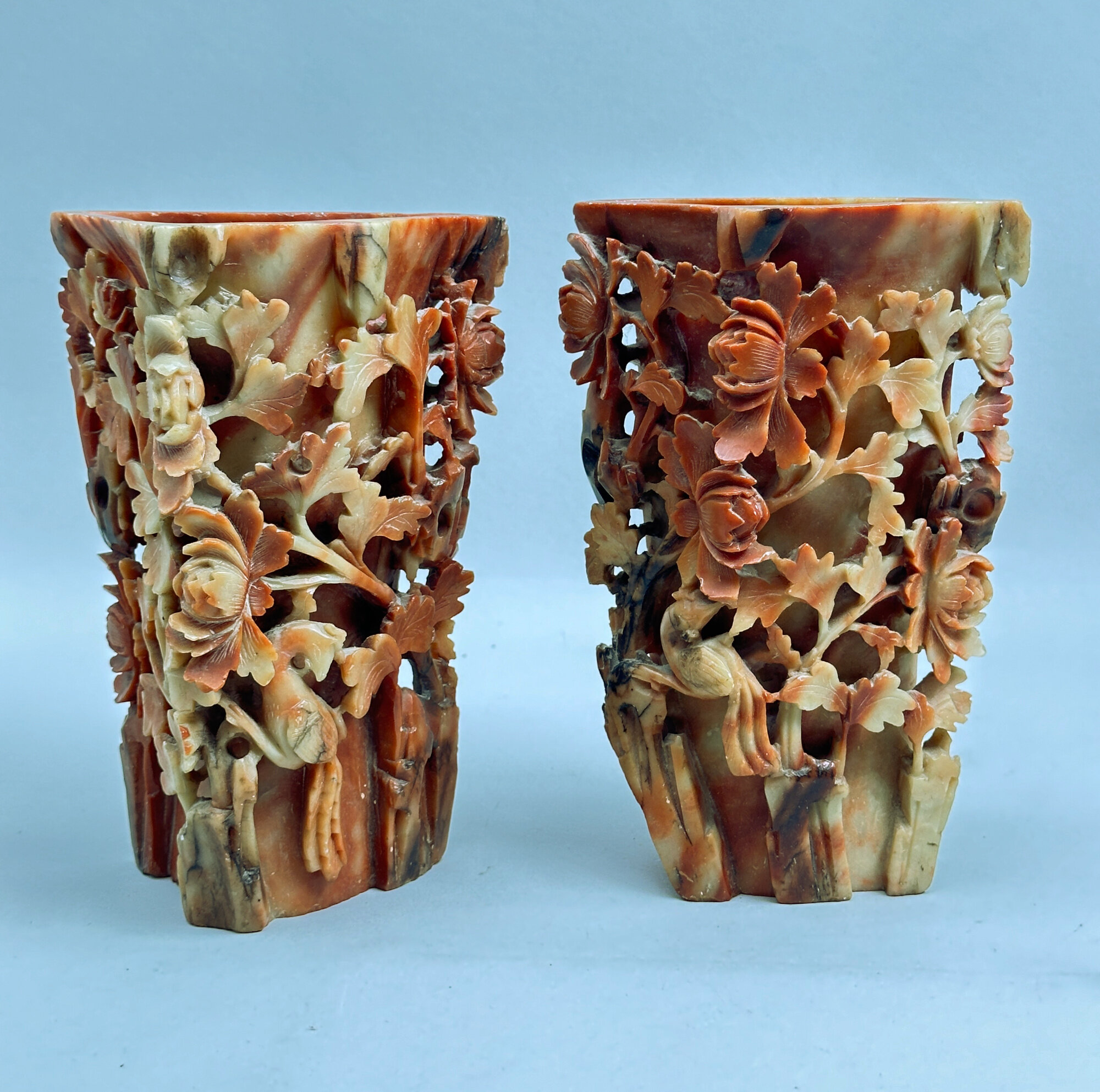
An unusual Pair of Chinese carved Soapstone Vases, circa 1900
Price: £110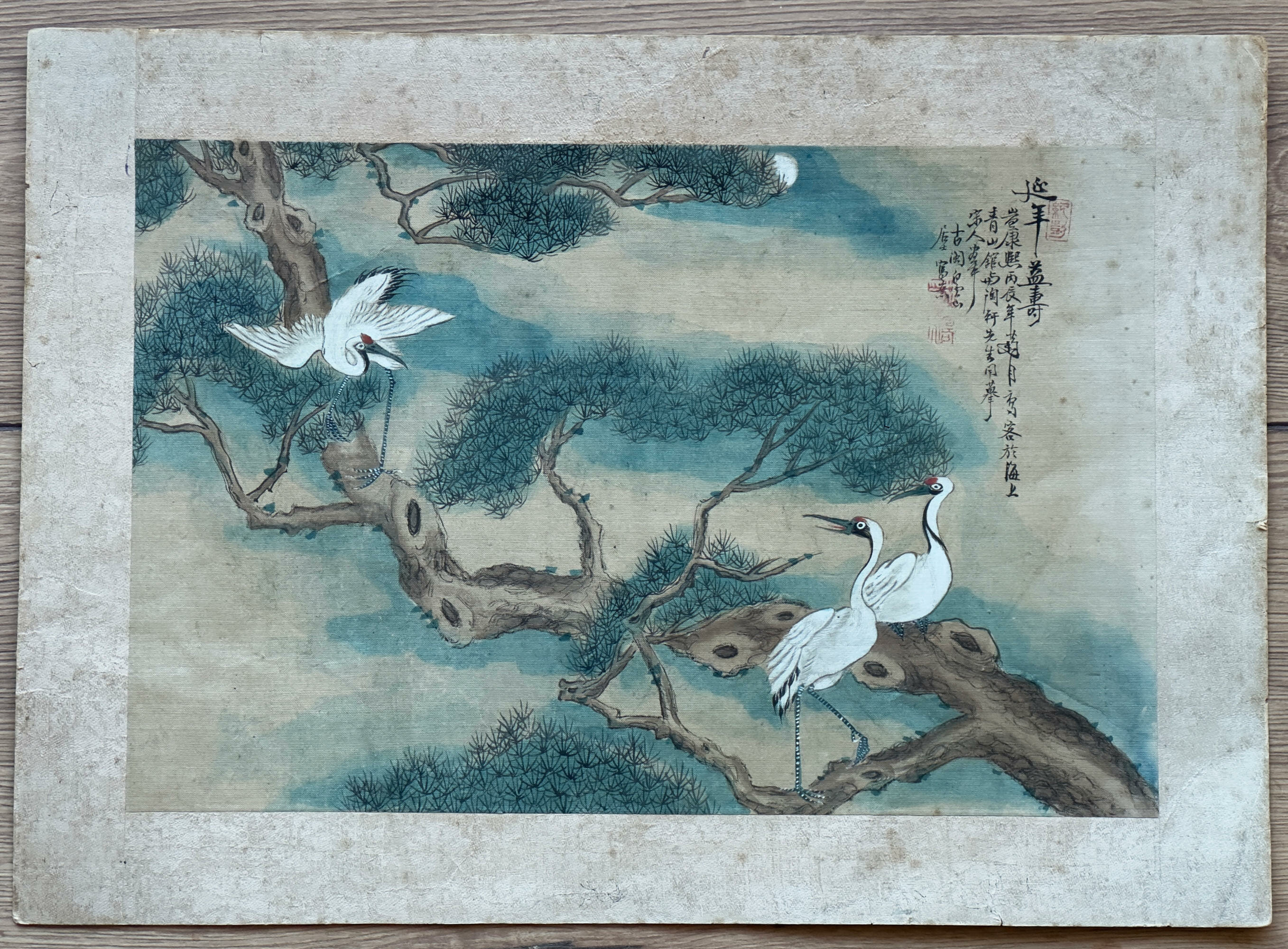
Chinese painting on Silk, Storks and Pine, circa 1900
Price: £25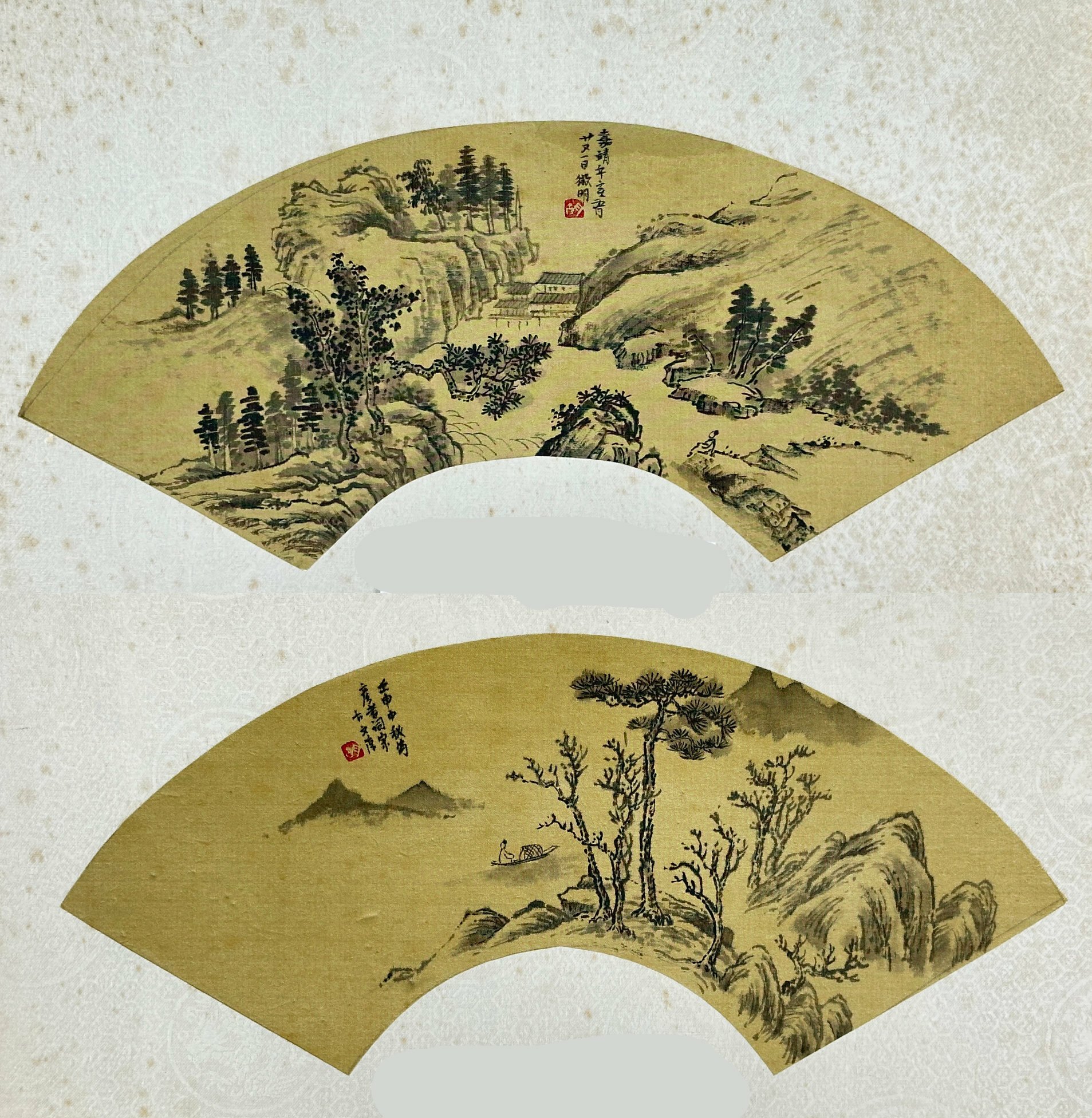
Two Chinese folding Fan Leaves with landscape scenes, now mounted, C20th
Price: £25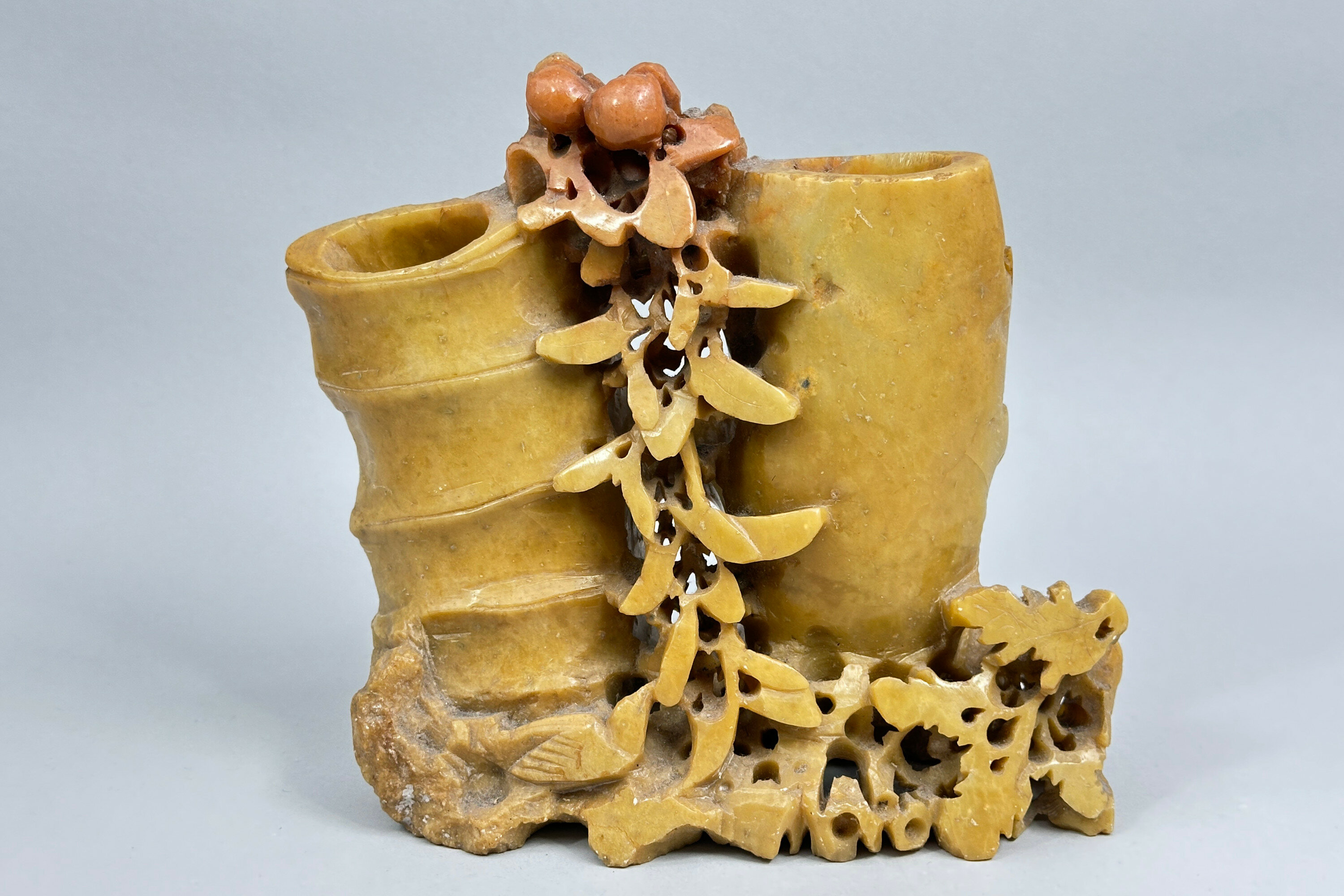
Chinese Soapstone Double Brushwasher, C20th
Price: £45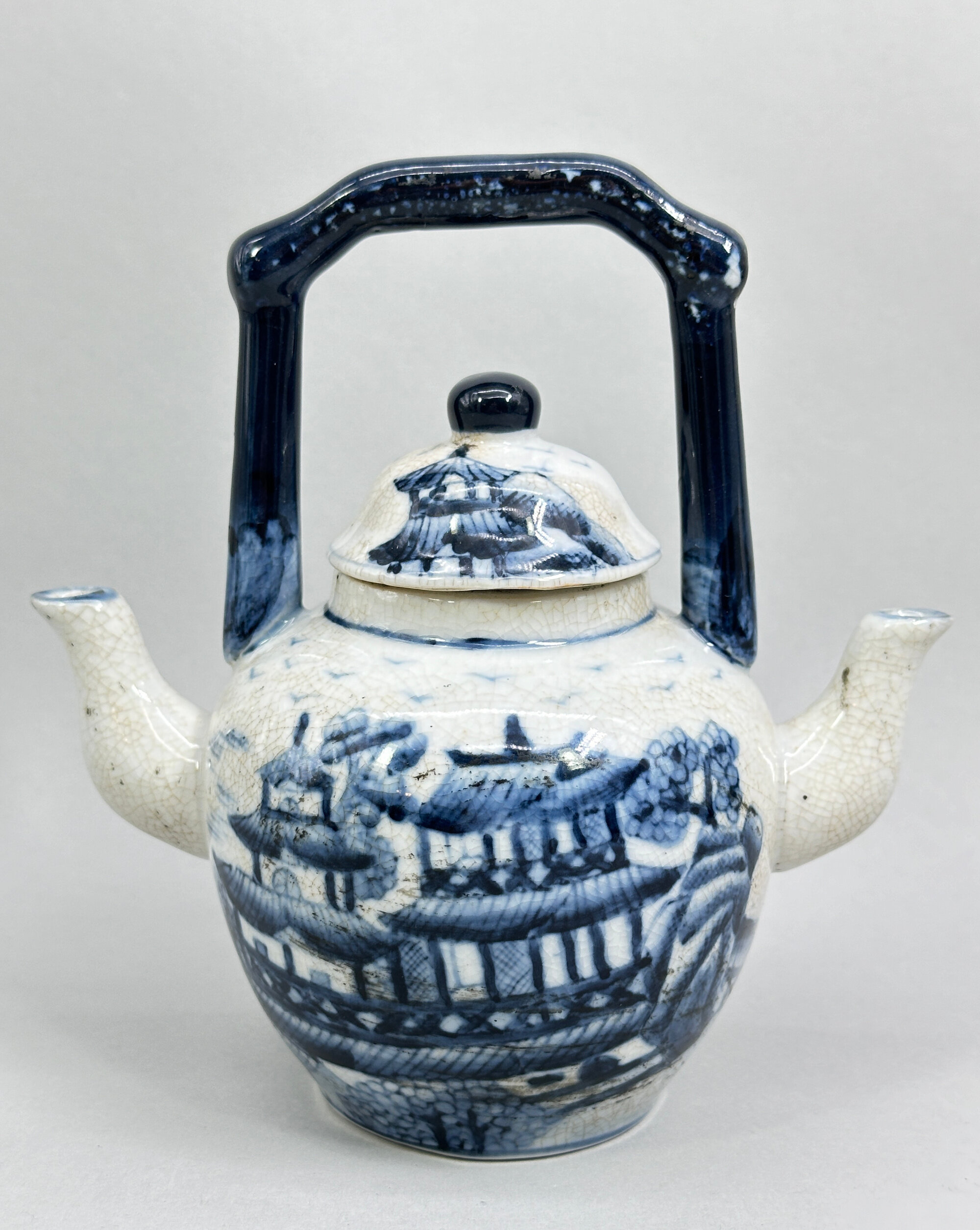
Chinese provincial double spout Teapot, early C20th
Price: £55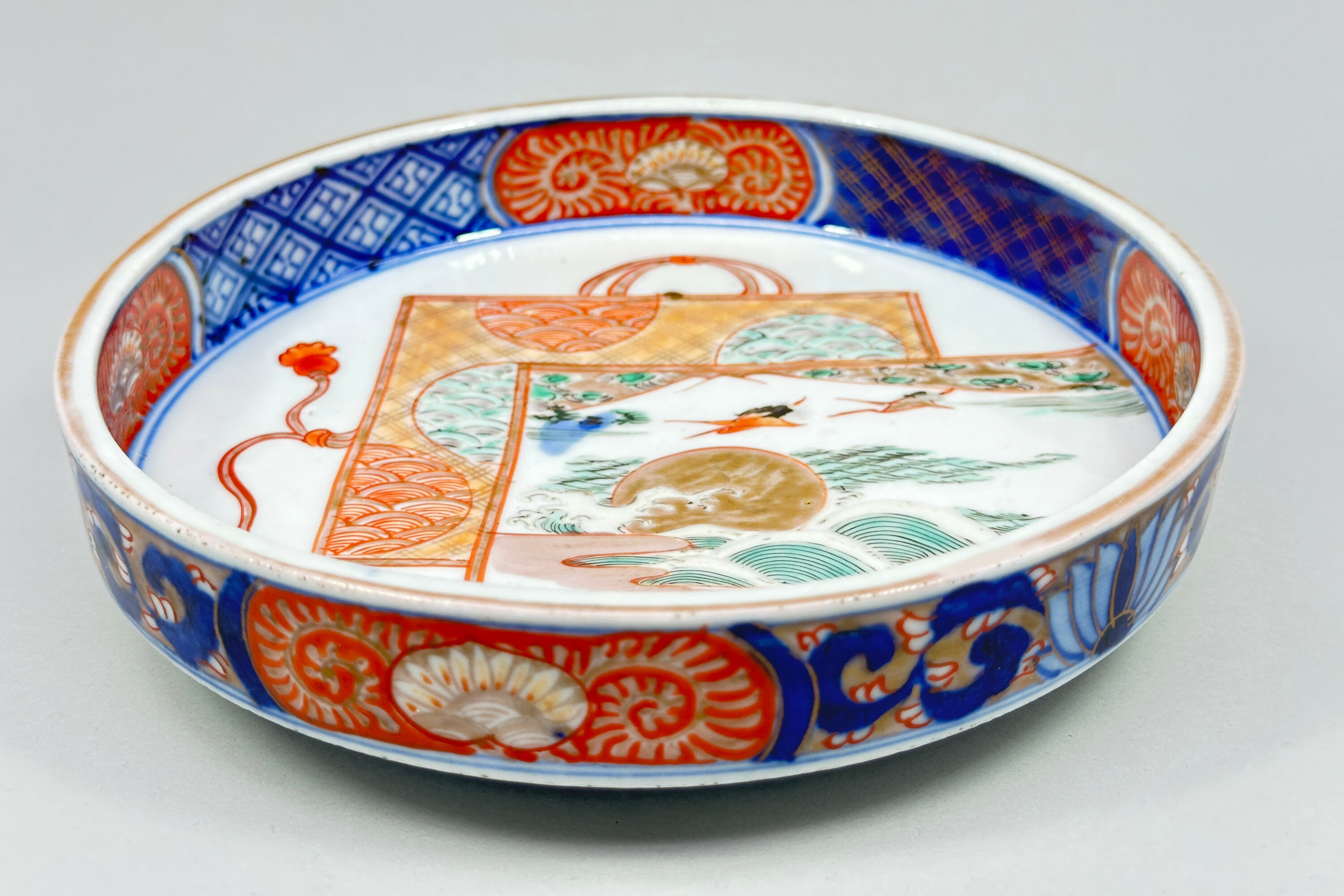
Japanese Arita shallow Bowl circa 1880
Price: £55The town of Arita in the former Hizen Province, northwestern Kyūshū island, was a major centre for the production of porcelains in Japan. Best known for blue and white pieces it also produced polychrome wares as well, including the familiar Imari colourings. While similar to Imari, the wider palette of colours used here is usually termed ‘Arita’ and this bowl employs not only the colourings but also many of the decorative elements found in these wares. The angular form, though, is unusual. Dating is to the Meiji era (1868-1912) probably around 1880.
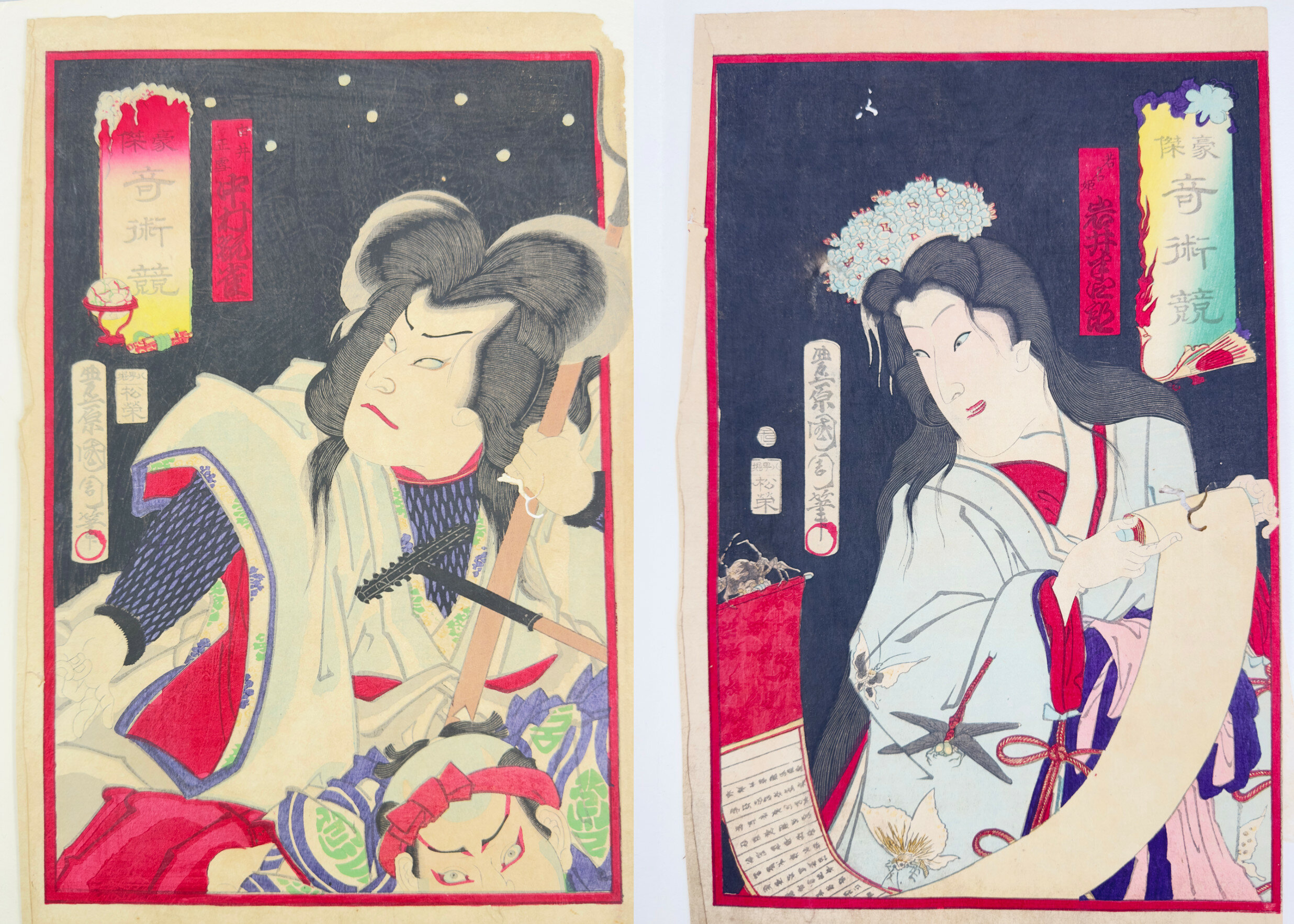
Two Japanese Woodblock Prints by Toyohara Kunichika, second half C19th
Price: £75Toyohara Kunichika achieved great fame and distinction a Japanese print artist. Born in 1835 he studied under Toyohara Chikanobu and then Utagawa Kunisada (also known as Utagawa Toyokuni III) eventually using a combination of both his teacher’s names to create his own professional one. At first he worked within Kunisada’s studio and when his teacher died in 1865 was asked to design two memorial portraits of him. The beginning of the Meiji era (1868-1912) saw Kunichika issuing his own prints, often in themed series and he became known in particular for his portrayals of kabuki actors, indeed he regarded the theatre as almost his second home. A contemporary once wrote ‘"Print designing, theatre and drinking were his life and for him that was enough.’ He achieved great fame and was rated as one of the masters of woodblock printing. Contemporary observers noted Kunichika's skilful use of colour in his actor prints, but he was also criticized for some of his choices for unlike most artists of the period, he made use of strong reds and dark purples rather than the softer colours used previously, exploiting the recent import of new dyes from Germany. Red, for the Japanese, meant progress and enlightenment so there was probably hidden meaning here. Eventually Kunichika’s lifestyle took its toll and he died in poor health, aged 65. It had been a Japanese custom for people of high cultural standing to write a poem before death. Kunichika's own, inscribed on his grave, reads ‘Since I am tired of painting portraits of people of this world, I will paint portraits of the King of hell and the devils.’ For many years his prints fell out of favour but interest has now revived and Kunichika is regarded as one of the eminently collectible Japanese artists in the field and these two prints are an excellent example of his work.
Each print is accompanied by a printed text on fine paper which presumably describes the character represented. The second of them is accompanied by two sheets one of which has become attached in one small place to the print itself but could probably fairly easily be detached by a restorer. In general there are some typical signs of age with minor losses (illustrated), tears and folding but the colours remain bright and fresh.

Japanese Fukagawa Jug and Stand decorated lotus, signed, circa 1900
Price: £45The Fukagawa kilns produced the best quality Imari items made in Japan in the late nineteenth century for export to the West. Their history starts with Ezaiemon Fukagawa who in 1856 became head of his family's porcelain business and in 1875 founded Koransha (The Company of the Scented Orchid) in Arita, Japan, to produce tableware for export. In 1894 the modern Fukagawa company was founded by Chuji Fukagawa, with the Fukagawa trade mark of Mount Fuji and a stream, as its trade mark. Dating of these pieces is therefore towards the end of the Meiji period (1868 - 1912) probably around 1900. While the decoration is similar to that found on other Fukagawa pieces there are few, if any parallels, and tea ware pieces by the firm are not very often seen.
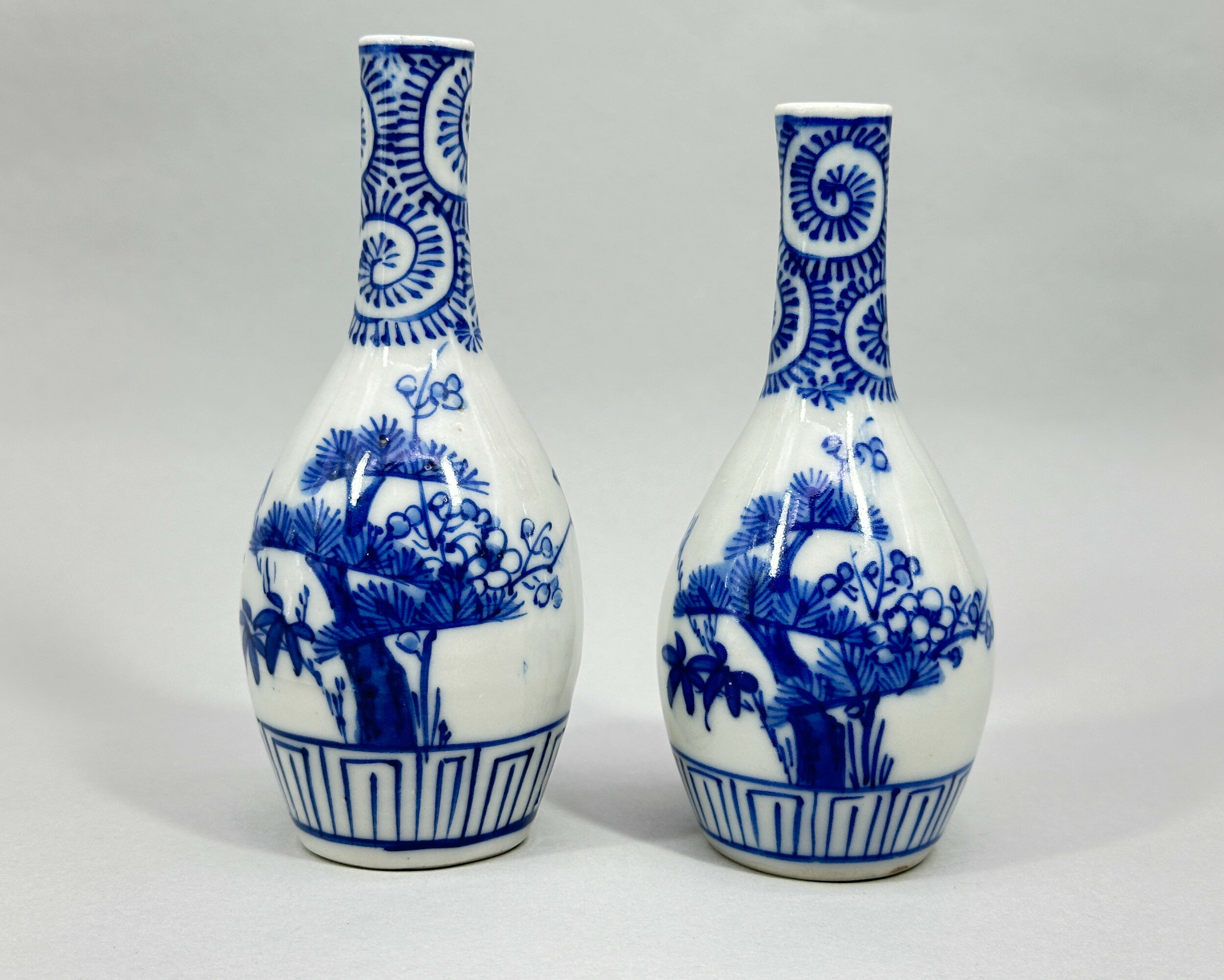
Pair of small Japanese Arita Blue and White Bottle Vases, circa 1880
Price: £55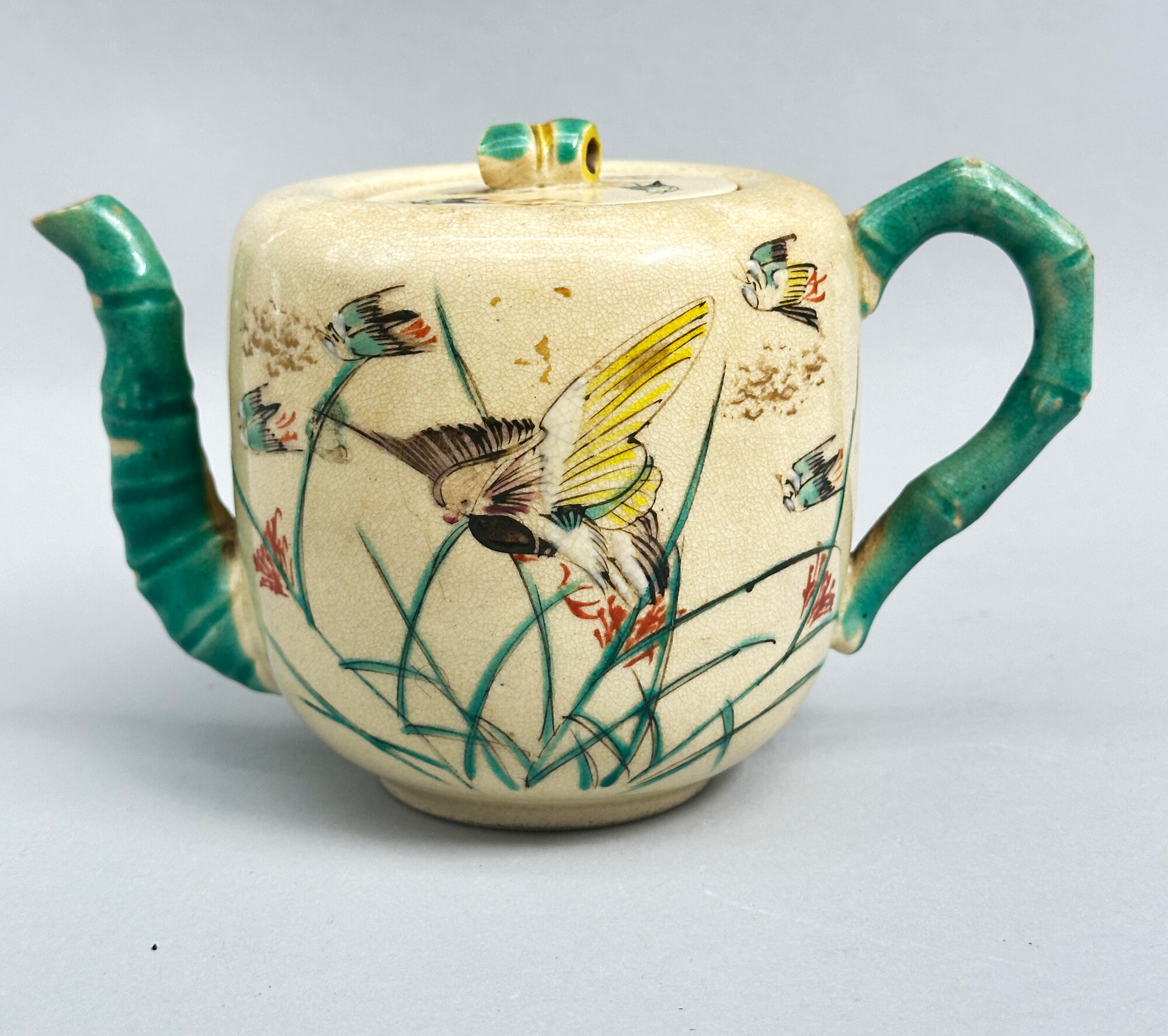
Japanese Awata ware Teapot and Cover, signed, circa 1900
Price: £25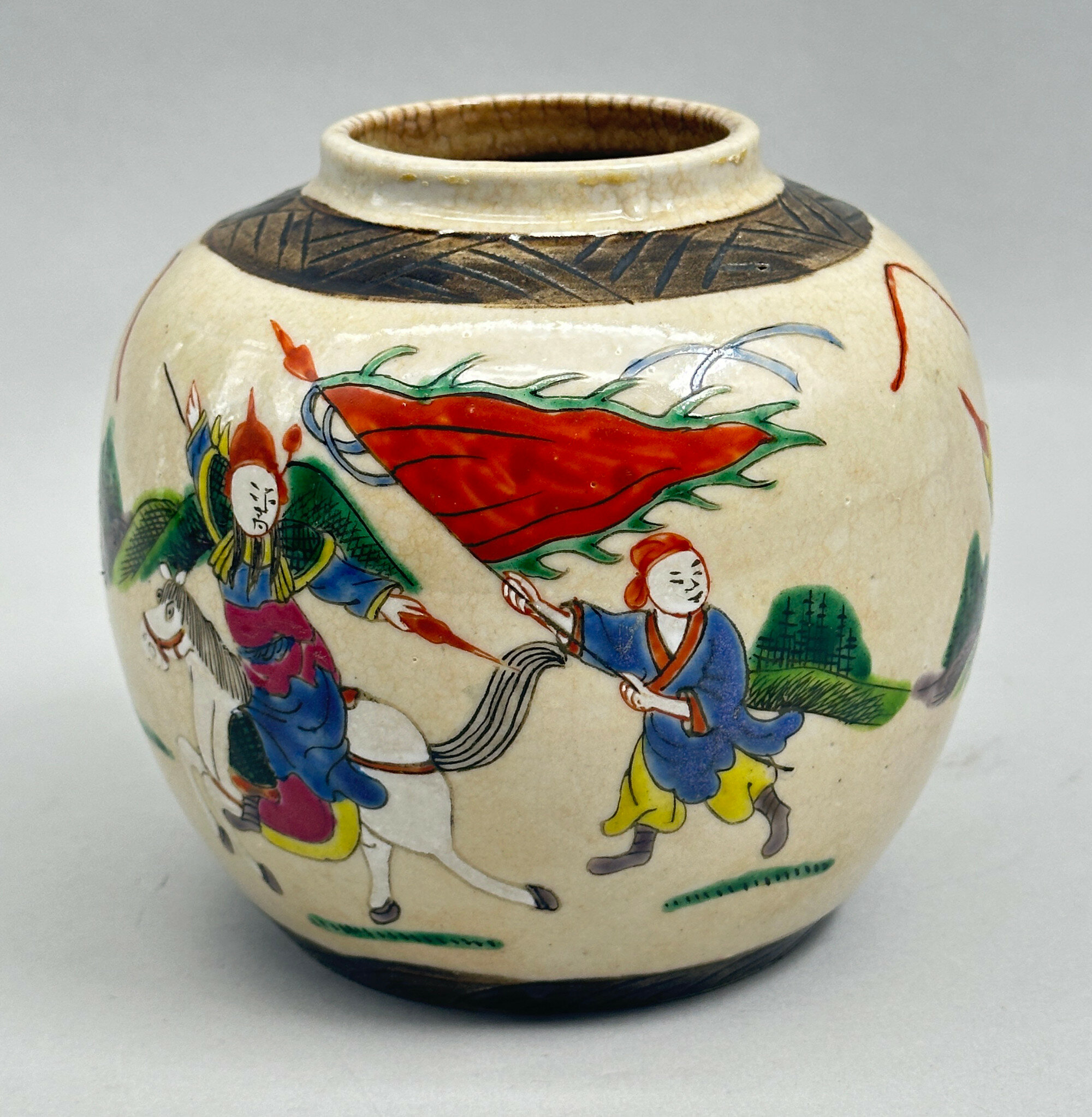
Chinese Crackleware Ginger Jar decorated with Warriors circa 1900
Price: £25'Crackleware' glazed pieces, usually with 'bronzed’ bands, were a staple output of the Chinese potteries from the mid nineteenth century onwards and were produced in a wide variety of mainly vase shape forms, both in polychrome and blue and white and intended as decorative pieces for the Victorian rooms of the West. As with other ceramic types, the quality deteriorated and this piece is typical of the late productions with a more modest level of craftsmanship but still retaining a naif charm. As with many ginger jars, this one lacks its original domed cover which would have been decorated to match.
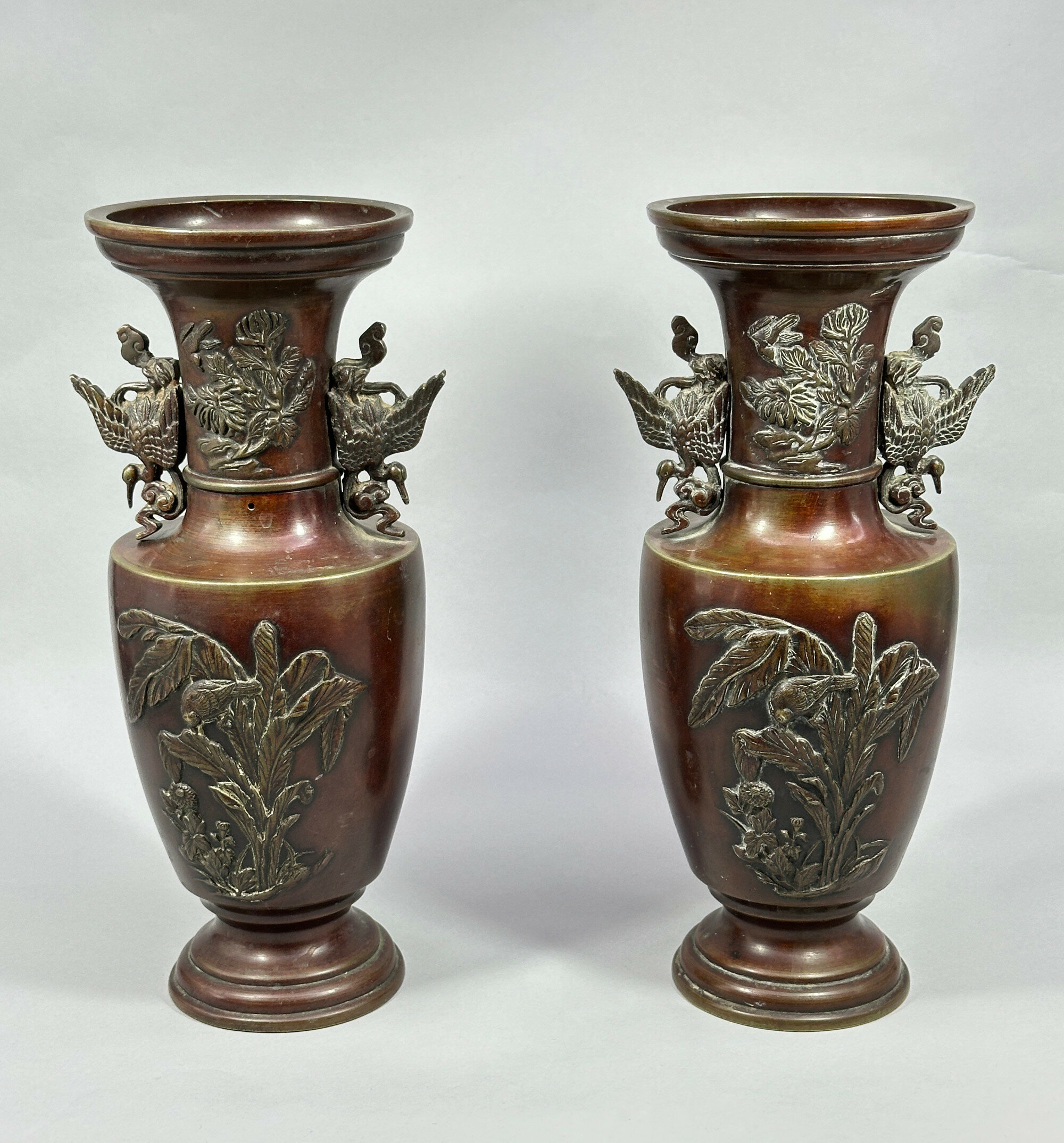
Pair of fine quality Japanese Bronze Vases decorated birds, circa 1880
Price: £220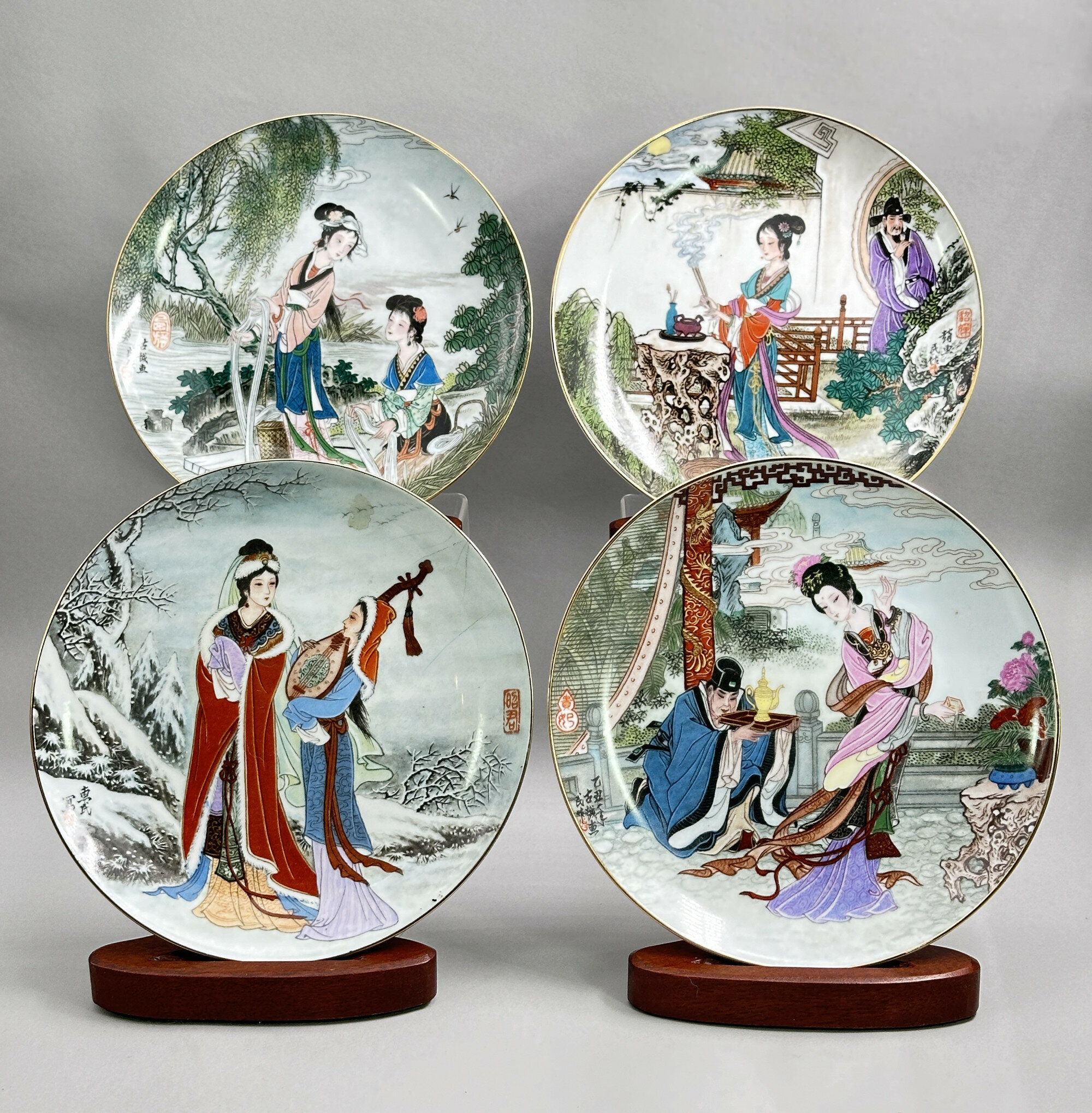
Set of Japanese Plates decorated with Geisha in landscape scenes, late C20th
Price: £40Please note that the stands are for display purposes only.
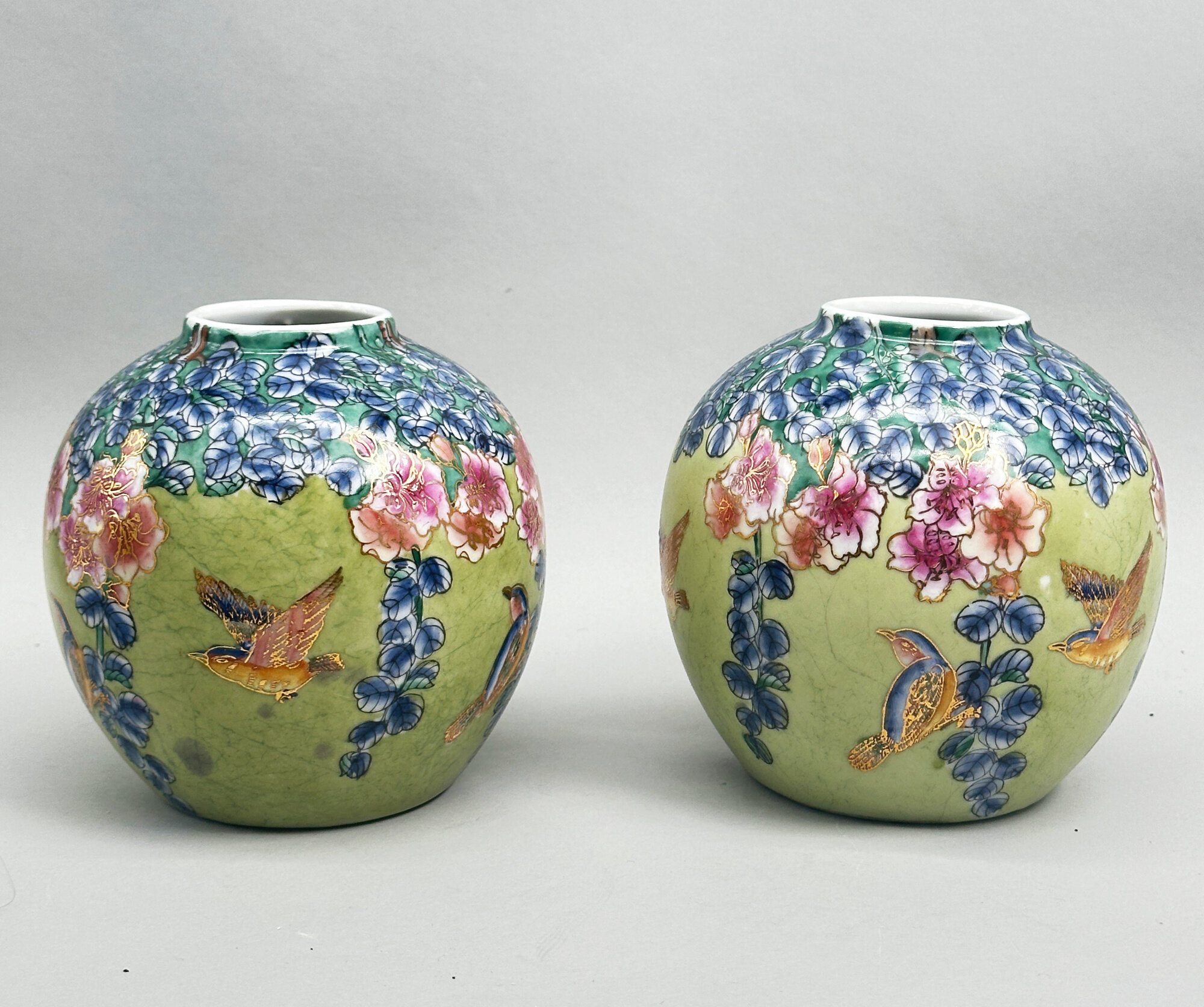
Pair of Chinese Ginger Jars decorated Birds and Flowers, late C20th
Price: £45